
Special Council Meeting
Minutes
Thursday 25 July 2013
Commencing at 4.10pm
Wycheproof Supper Room
367 Broadway, Wycheproof
Warwick Heine
Chief Executive Officer
Buloke Shire Council

Special Council Meeting
Minutes
Thursday 25 July 2013
Commencing at 4.10pm
Wycheproof Supper Room
367 Broadway, Wycheproof
Warwick Heine
Chief Executive Officer
Buloke Shire Council
Minutes of the Special Meeting held on Thursday, 25 July 2013 commencing at 4.10pm in the Wycheproof Supper Room, 367 Broadway, Wycheproof
PRESENT
CHAIRPERSON:
COUNCILLORS:
Cr Ellen White Mallee Ward
Cr David Pollard Lower Avoca Ward
Cr Stuart McLean Lower Avoca Ward
Cr Graeme Milne Mount Jeffcott Ward
Cr Leo Tellefson Mount Jeffcott Ward
Cr Gail Sharp Mount Jeffcott Ward
OFFICERS:
Mr Warwick Heine Chief Executive Officer
Mr Anthony Judd Manager Assets and Infrastructure
Mr Bill Keane Manager Community Services
Mr Bill Ryan Manager Finance
AGENDA
1. COUNCIL prayer AND WELCOME
The Deputy Mayor Cr Leo Tellefson read the Council Prayer and welcomed members of the gallery.
2. RECEIPT OF APOLOGIES
Cr Reid Mather (Mayor) Mallee Ward
Ms Judi Bird Senior Procurement Officer
Ms Gaynor Doreian Manager Works and Corporate Services
Mr Warren Hemopo Manager Reconstruction
3. REQUESTS FOR LEAVE OF ABSENCE
Nil.
4. DECLARATION of PECUNIARY AND conflictS of interest
There were no declarations of interest.
5.1.2 Proposed Budget For The Municipal Year Ending 30 June 2014
5.1.3 Review of Mayor and Councillor Allowances
5.1.4 Shire of Buloke Community Grants and Sponsorship Program
NEXT MEETING
The next Ordinary Meeting of Council will be held in Wycheproof Supper Room, 367 Broadway, Wycheproof on Wednesday, 14 August 2013 at 7.00pm.

WARWICK HEINE
CHIEF EXECUTIVE OFFICER
5. General Business
5.1.1 Council Plan 2013 - 2017 - Adoption For The Purpose Of Seeking Community Feedback Pursuant To Section 223 Of The Local Government Act
Author’s Title: Chief Executive Officer
Department: Office of the CEO File No: CM/13/07
|
1 ViewDraft Council Plan 2013 - 2017 |
Relevance to Council Plan 2013 - 2017
Objective: A Buloke community connected and involved in shaping decisions that affect them
Strategy: Working with communities and other stakeholders in planning for and making decisions about the future
Priority: ensure all major projects and strategies are informed through community and stakeholder consultation which is guided by Council’s Community Consultation framework and, where relevant, appropriate Advisory Committees and/or consultative mechanisms
|
That: 1. Council adopt the draft Council Plan 2013-2017 in principle for the purpose of meeting the formal exhibition and advertising period required by the Local Government Act 1989 (the Act) 2. The period of formal exhibition of the draft Council Plan 2013-2017 be from 29 July 2013 until 28 August 2013. 3. As part of the formal advertising process the community be invited to make a submission and that any submissions received be considered in accord with the provisions of s223 of the Act 4. That Council hold a Special Meeting of Council on Wednesday 28 August 2013 to consider any submissions received on the draft plan and to formally adopt the plan either in its current form or with amendments 5. That a copy of the draft plan be sent to all households in the Shire in accord with the community engagement strategy agreed as art of the plan development process.
Seconded: Cr Stuart McLean Carried. |
1. Executive Summary
The purpose of this report is to present the draft of the Council Plan 2013-2017 for Councillors' consideration and to recommend the draft Plan be released for further community input and for it to be advertised pursuant to the requirements of s223 of the Local Government Act for 28 days to allow for public submissions.
2. Discussion
In accordance with s125 of the Local Government Act 1989 (the Act) a new Council Plan for the 2013-2017 period has been prepared.
It is a requirement under the Act that the plan is made available for public feedback by submission for a period of 28 days, followed by the opportunity for submitters to make a verbal presentation in support of their submission, prior to formal adoption by Council.
It is stressed that the plan is in a draft format and that a proportion of the material that is to be released for public content at this time will not be published as part of the plan finally adopted by Council. This particularly applies to the ‘discussion papers’ that have been included with the draft to provide background context to the plan, and to some of the strategies and priorities identified in it.
While Councillors have been directly involved with the development of the draft plan formal presentation of the document in this final draft form enables Councillors to carry out a final review, and to confirm that their intentions with regards the Vision, Strategic Directions and Priorities for the next four years have been encompassed in the plan.
The need for Council to address matters relating to financial sustainability, short to long term, was one of the matters requiring particular attention during the process of development of the plan. This has also been one of the factors contributing to adoption of the plan being delayed to this time as there was a need to ensure that the plan and the Council budget 2013/14 were fully aligned and the and development of a ten year financial plan. Both the plan and the Budget 2013/14 are based on a ten year financial plan that has been developed by Council over the last few months. Development of the ten year financial plan has required Council to look carefully at its financial capability and capacity and has resulted in a number of policy decisions that are reflected both in the Plan and the Budget 2013/14.
In addition, during the period of its development a number of new medium to long term influences have emerged that needed to be considered in the context of the plan. The likely cost of major flood mitigation works in Charlton and Donald is one example of the factors that have emerged as the plan has been under development. The full cost of the levy banks recommended by the two Flood Plan studies completed earlier this year have not yet been detailed but early estimates suggest the need for several millions of dollars to be found to construct the levies and for several hundreds of thousands of dollars to be found for ingoing maintenance if they are built.
In many instances Council has not been able to find solutions to some of the emerging influences but it does need to ensure that its planning is flexible enough to accommodate change. The financial capacity of Council and the Buloke community will continue to be a significant challenge and this is one of the matters that have been addressed in the Plan. As raised on several of the discussion papers attached to the draft plan Council and the Buloke community will need to make some increasingly difficult decisions over the next few years. Some of these decisions will be about the services to be provided and to what level these are provided, others will be about the capacity to maintain all of the current infrastructure that is in place across the Shire, still others will be about the social and economic viability of small communities that are likely to shrink in size even further in future years.
Preparation of this plan (2013 -2017) more than possibly any plan in the past has highlighted the relatively fragile attire of the Shire. The Shire has a strong and prosperous future from the perspective of agricultural production, but will face many challenges in terms of affordability and liveability. This will present many policy challenges to Council.
Background
When considering the development of the draft plan 2013-2017 Councillors reviewed the previous plan (2009-2013) and undertook a detailed review of current and future economic, social, financial, environmental, affordability and liveability factors likely to impact Buloke, its economy and its community over the next decade.
The review was undertaken over a number of months with Councillors and senior staff participating in a number of workshops and discussions.
A series of discussion papers on key matters was produced as part of the review and were subject to review and discussion as to the implications they held for the Shire now and into the future. Topics covered by the discussion papers included:
· rates affordability
· attracting new investment
· the local economy
· community engagement
· telecommunications
· roads (State highways and local roads)
· public transport
· freight movement
· liveability
· water
· waste management
· infrastructure (capital works)
The objective of the discussion papers was to generate discussion, and from this discussion identify actions and priorities that council needed to consider as part of the development of the plan. A number of these discussion papers will be released to the community as part of the consultation process leading to formal adoption of the 2013-2017 plan.
The review resulted in Council reconfirming its commitment to the provision of good quality service delivery to the community and the need for detailed planning to address a wide range of anticipated changes which are likely to affect all aspects of life in the Shire over the coming decade. Some of these changes may be within the control of council to directly influence, others may need to be the focus of advocacy campaigns to other levels of government, and still others may simply be the result of worldwide economic and social trends.
The review also resulted in some minor changes being made to the Vision for the Shire set by the previous plan (2009-2013).
Community priorities, preferences and concerns were gathered from a variety of sources and fed into the plan development process. Sources of information included:
· review of community plans
· attendance at Township Forum and Progress Association meetings
· meetings with key stakeholder groups
· input received as part of the process of developing other strategic plans
· feedback received as part of the annual community satisfaction survey
· facilitated discussions with a wide range of residents and stakeholders
· research reports.
All of the information gathered has been considered in the preparation of this draft.
Draft indicator statements have been developed and incorporated into the draft plan. These will be further refined before the final plan is adopted based on feedback received from residents and clarification of future Local Government reporting arrangements by the State Government. Local Government reporting requirements are currently being reviewed and increased by the Victorian Auditor General's Office (VAGO) and Local Government Victoria. As government advice becomes more specific, further refinements to the indicator statements set out in the plan may be required.
Community feedback on this draft is being sought. A copy of the draft plan is to be mailed to every household in the Shire with an invitation to provide comment. A return addressed comments form will be included in the mail-out to facilitate responses.
The plan includes a copy of the ten year financial plan developed by Council as part of 2013/14 Budget deliberations. Projected Financial Resource statements for the next ten years have also been included, and these will be updated again following further budget deliberations.
If agreed by Council this draft of the Council Plan 2013-2017 will be on formal exhibition for 28 days, until Wednesday 28 August 2013.
The Local Government Act (the Act) requires the Council Plan to be adopted by Council prior to 30 June 2013 but this has been delayed to allow Council to develop its ten year financial plan which has been the principal tool used to guide the 2013/14 Budget.
It is anticipated that Council will consider formal adoption of the 2013-2017 Council Plan
at a Special Meeting of Council to be held on Wednesday 28 August 2013.
Formal adoption of the plan does not mean that development of the plan will cease. The plan is an iterative document and will be subject to ongoing review and amendment as circumstances change or new information becomes available. Any future change to the plan will require further formal community consultation in accord with the provision of the Act.
3. Financial Implications
Preparation of the Council Plan has been undertaken using internal staff resources.
There are no direct financial implications arising from adoption of the report.
An operating expense allocation has been made to meet the cost of publication of the plan.
4. Community Consultation
Community engagement in the preparation of this draft has been limited to targeted discussions, review of adopted community plans and meetings with key stakeholder groups.
The next stage of community engagement includes a mail out to every household in the Shire with an invitation to provide input and comment on the draft plan.
Copies of the draft plan will also be mailed out to key community and stakeholder groups with an offer for direct discussion with Councillors and senior staff.
5. Internal Consultation
Councillors, senior staff and a wide range of other staff have been involved in the preparation of this draft through meetings, workshops and discussion over the last six months.
6. Legislative / Policy Implications
Council is required by to prepare a Council Plan for a minimum four year period in accordance with s125 of the Local Government Act 1989 (the Act).
7. Environmental Sustainability
There are no environmental considerations arsing form the preparation of this report.
Environmental sustainability is one of the matters addressed in the draft plan.
8. Conflict of Interest Considerations
There are no known conflicts for Councillors or staff associated with this report.
9. Conclusion
Development of the new Council Plan for a four-year Council term is an important process because it expresses the philosophy that will guide the Council and sets out the strategic directions and priorities for the term, and the actions for the first year of the term.
Council Plan development is an iterative process where the priorities of the full range of people affected by it are considered and incorporated where they fit with the stated priorities.
The directions, initiatives and yearly actions drive the Council budget
The draft Council Plan 2013-2017 and the activities described in this report form an important part of the development process.
Buloke Shire Council Special Meeting Minutes Thursday, 25 July 2013
5.1.1 Council Plan 2013 - 2017 - Adoption For The Purpose Of Seeking Community Feedback Pursuant To Section 223 Of The Local Government Act
Attachment 1 Draft Council Plan 2013 - 2017




































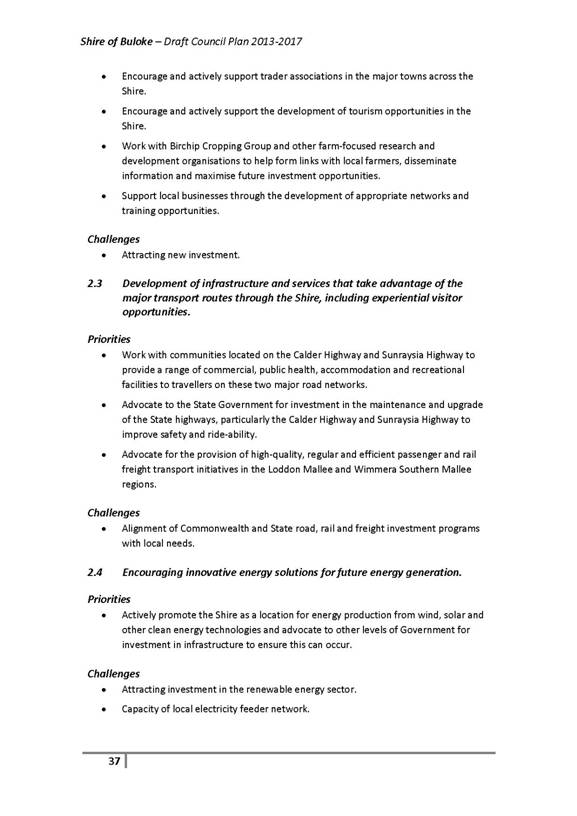

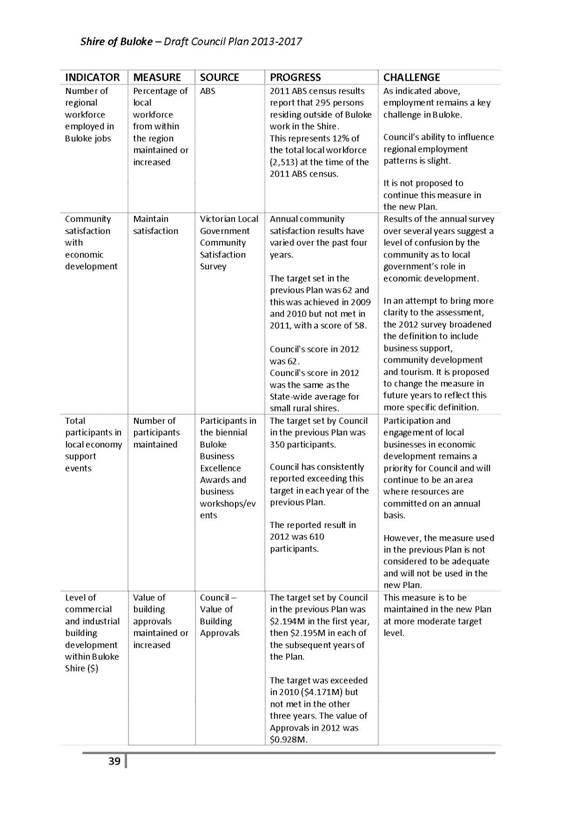


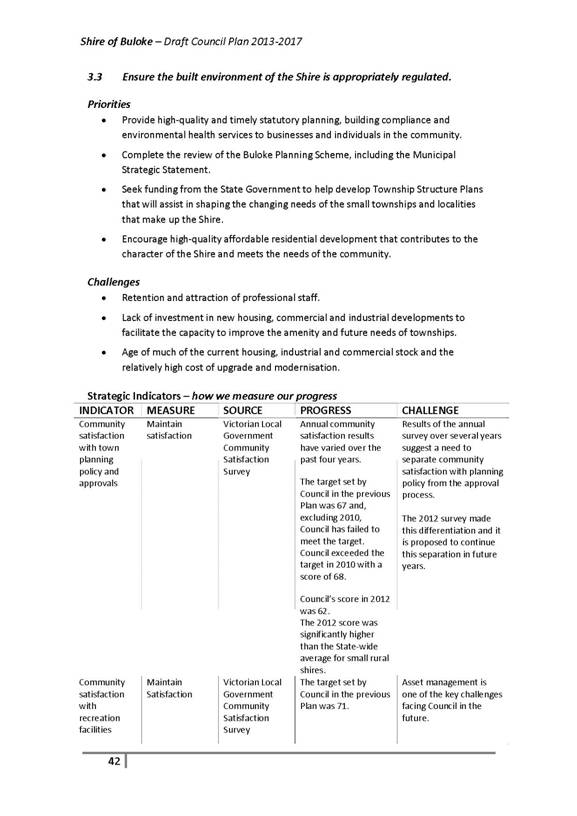


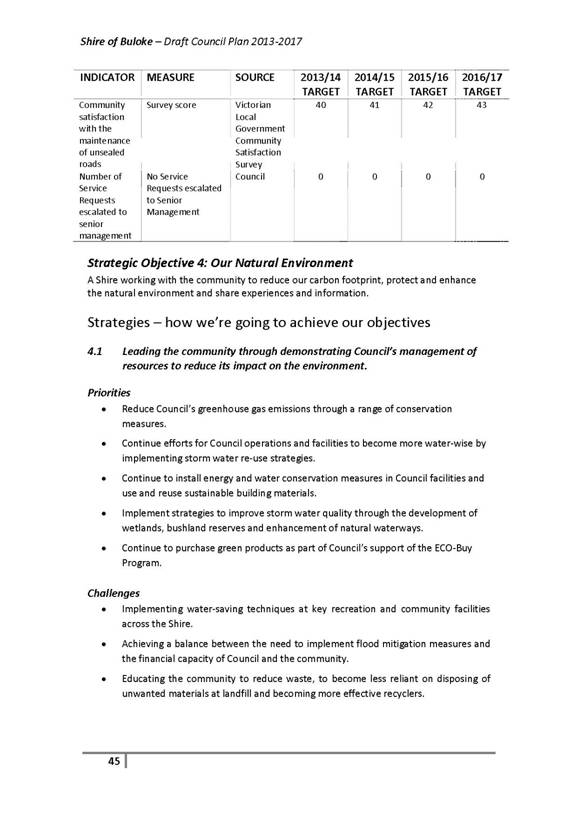
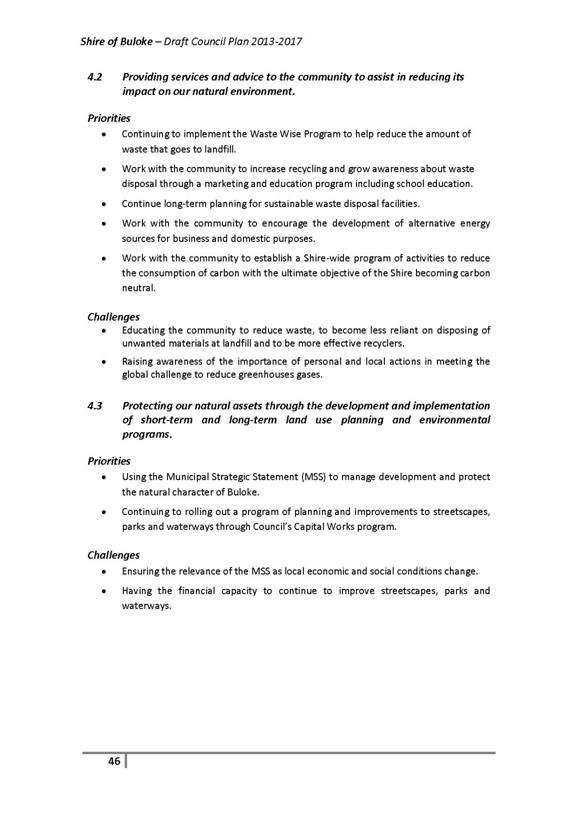
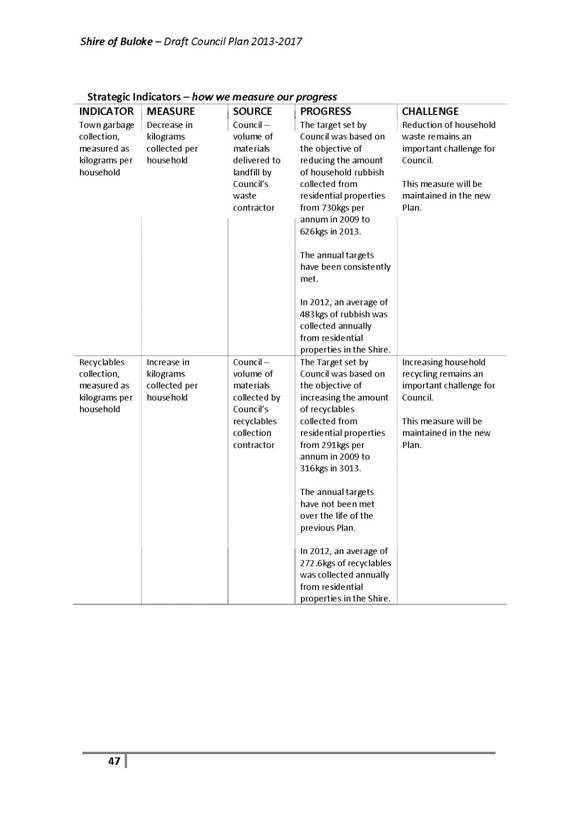
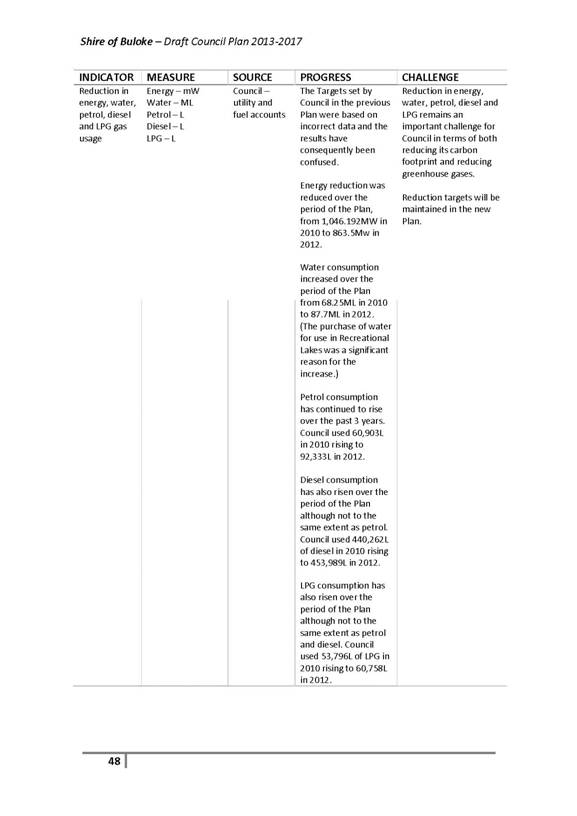
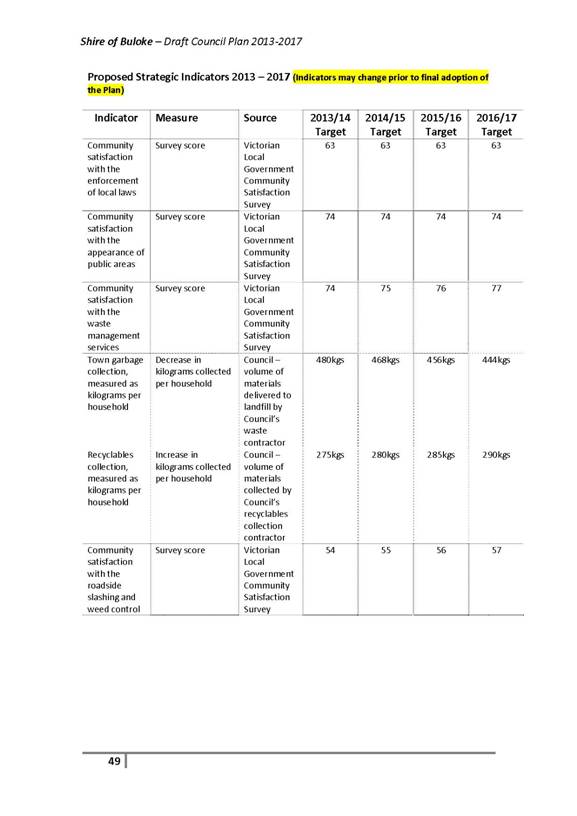

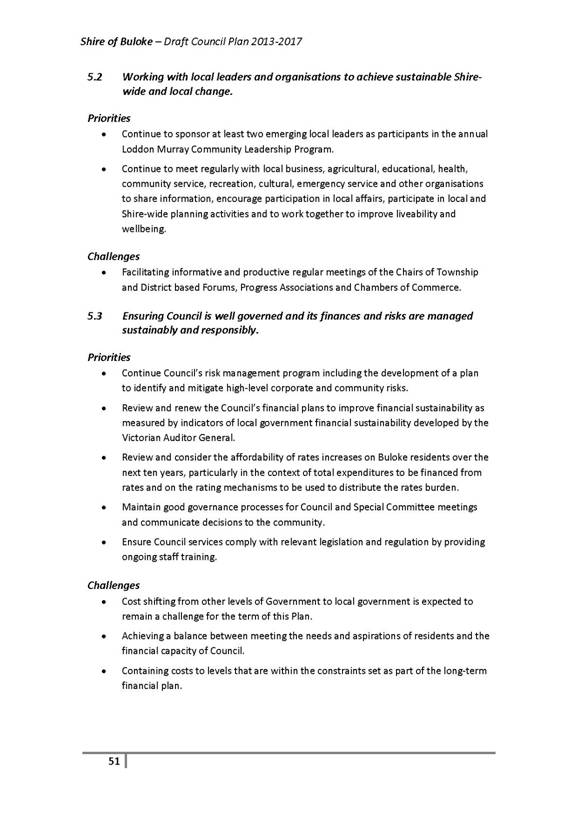
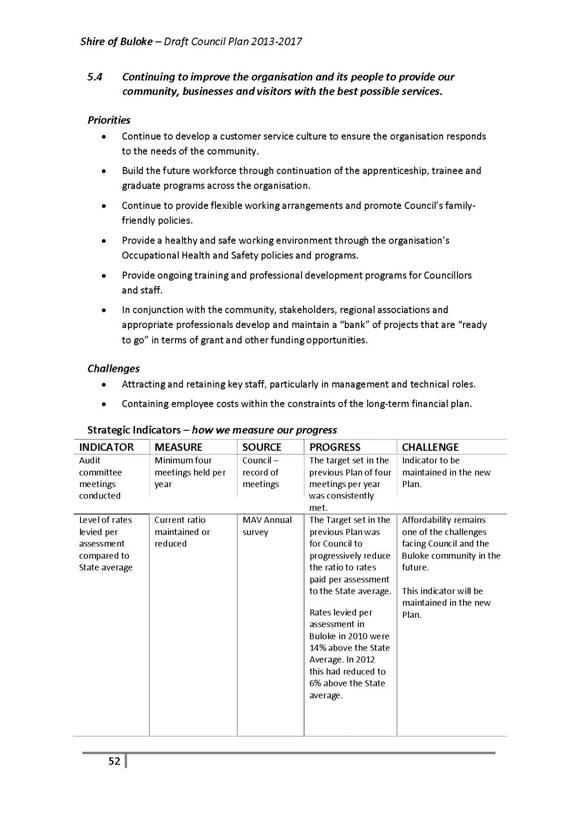
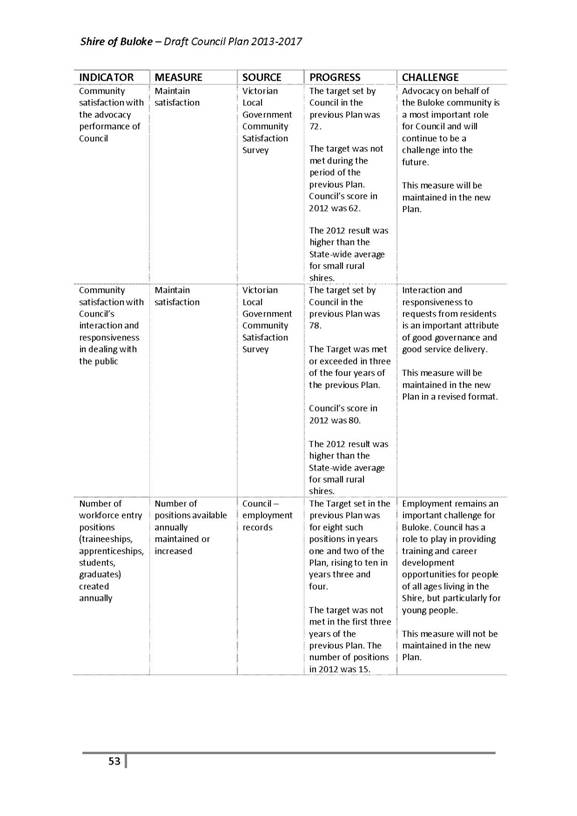
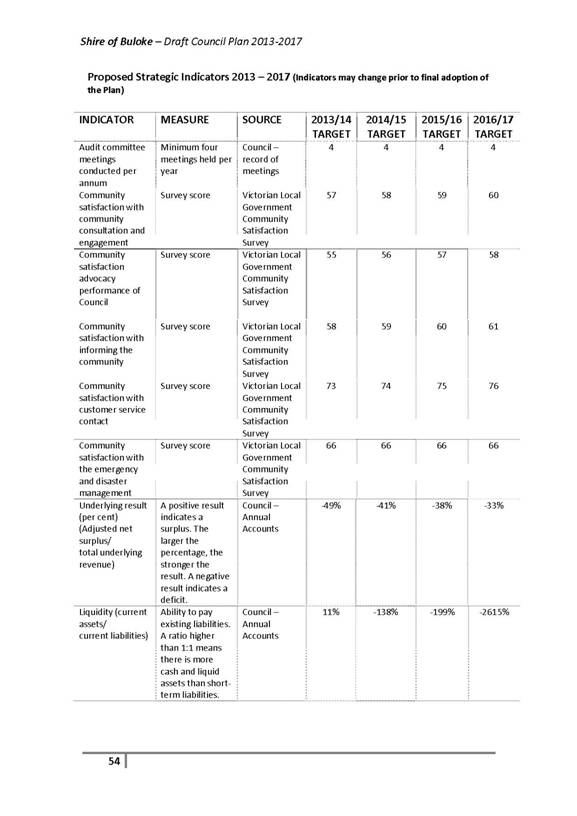
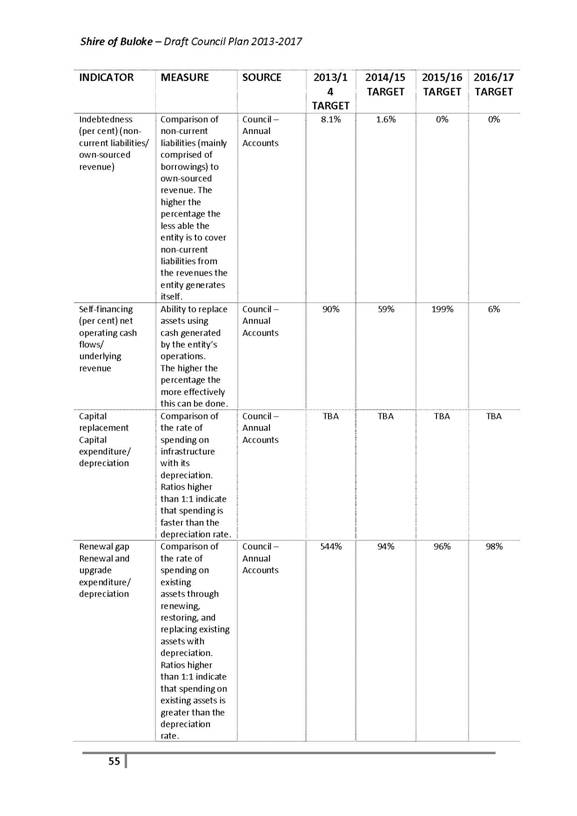
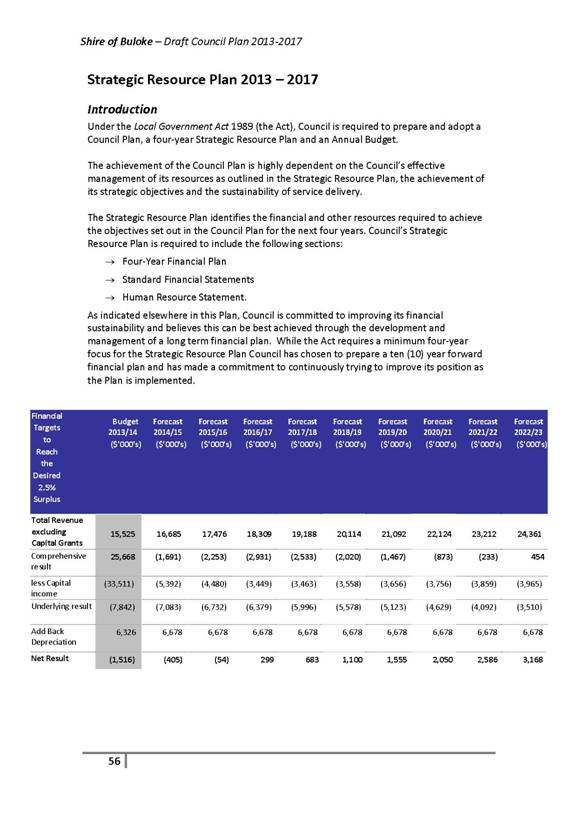
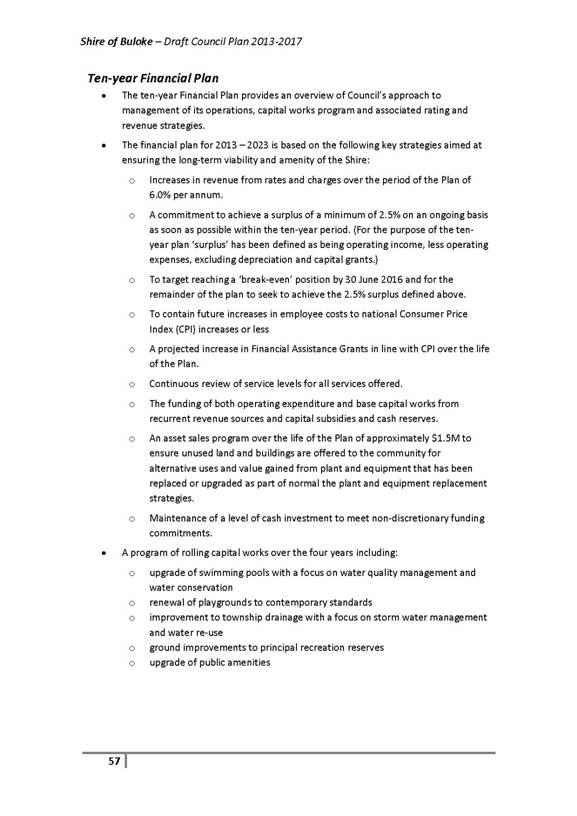
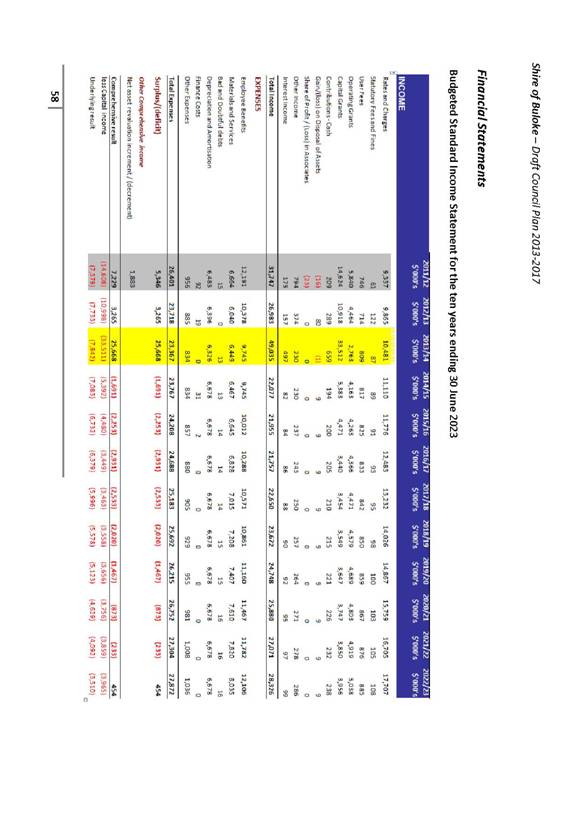
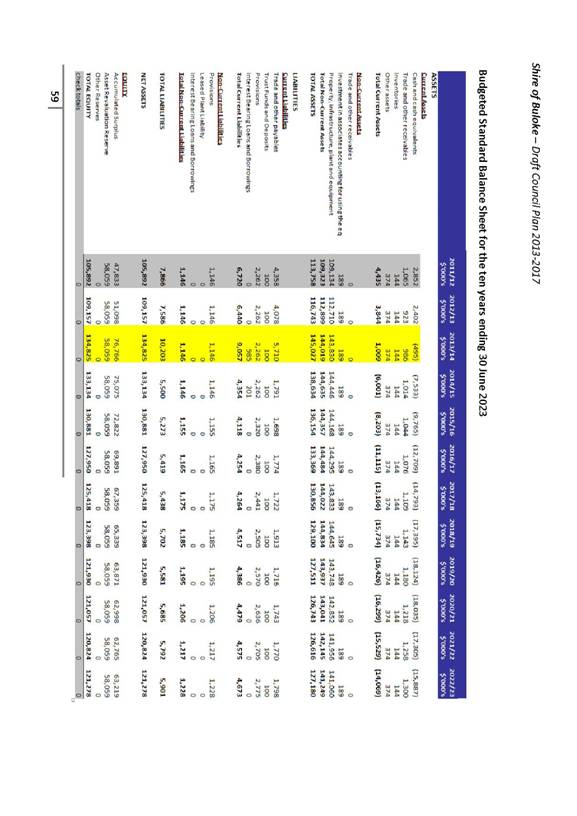

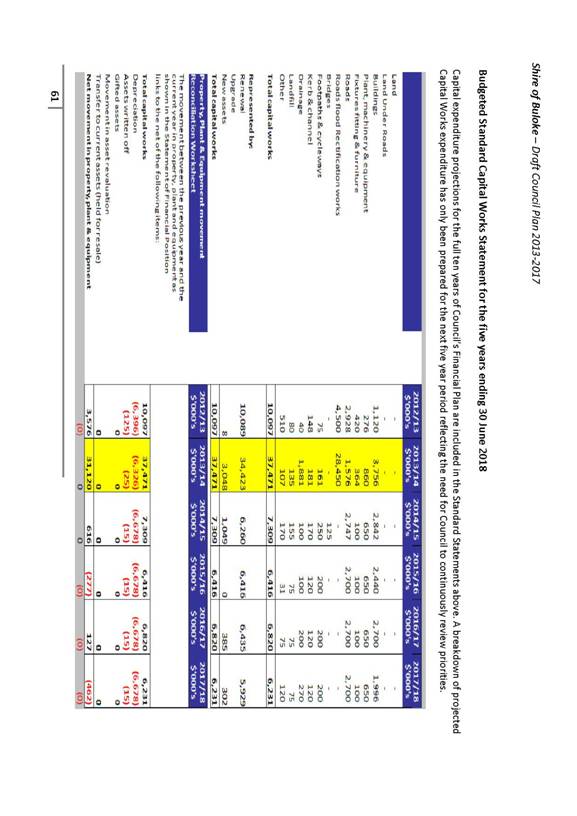

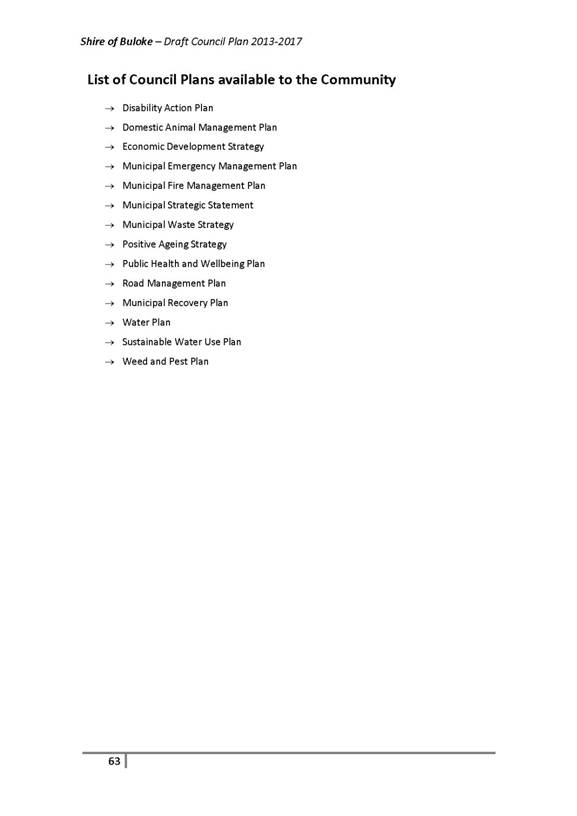
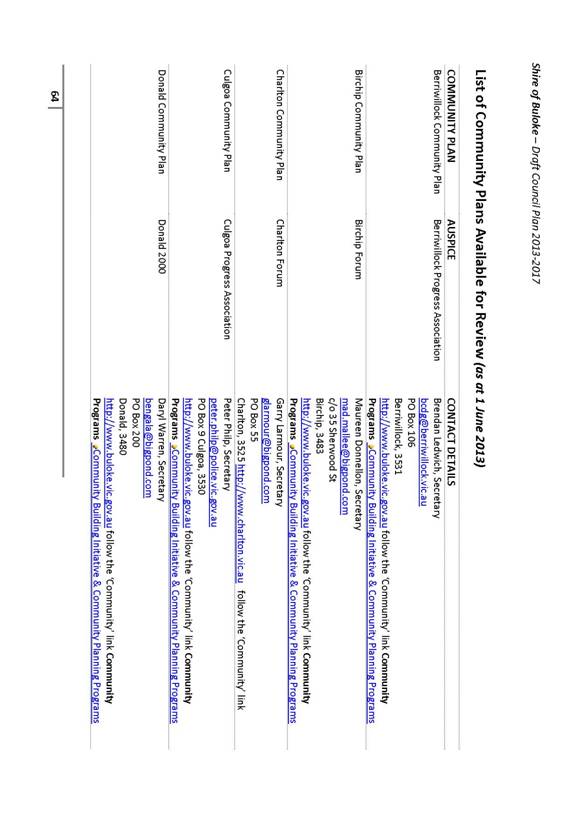
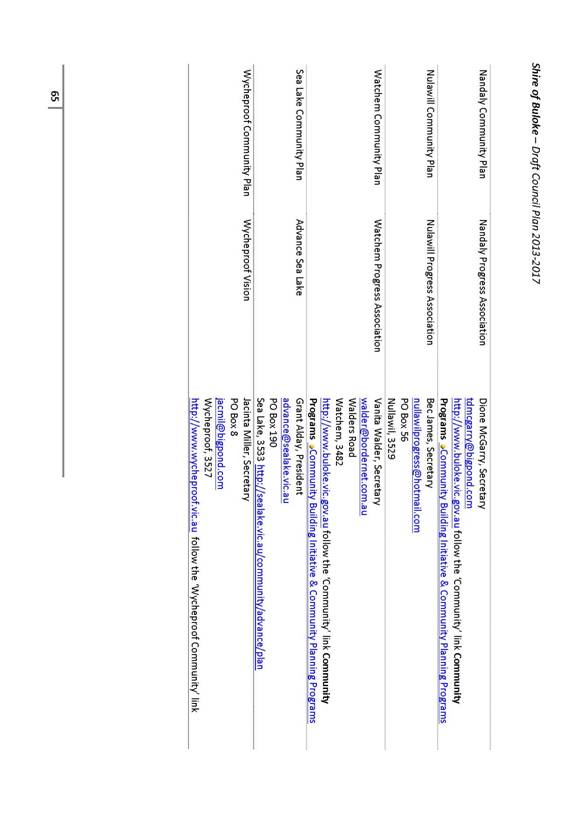
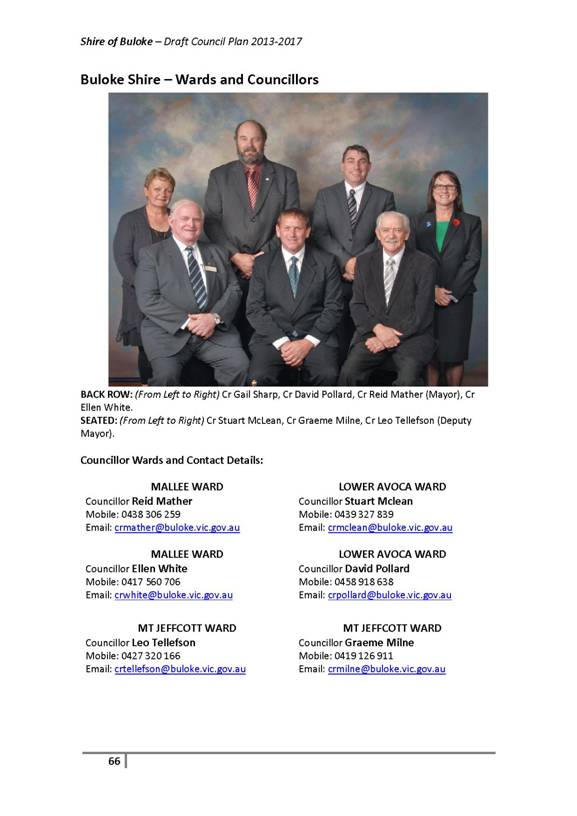
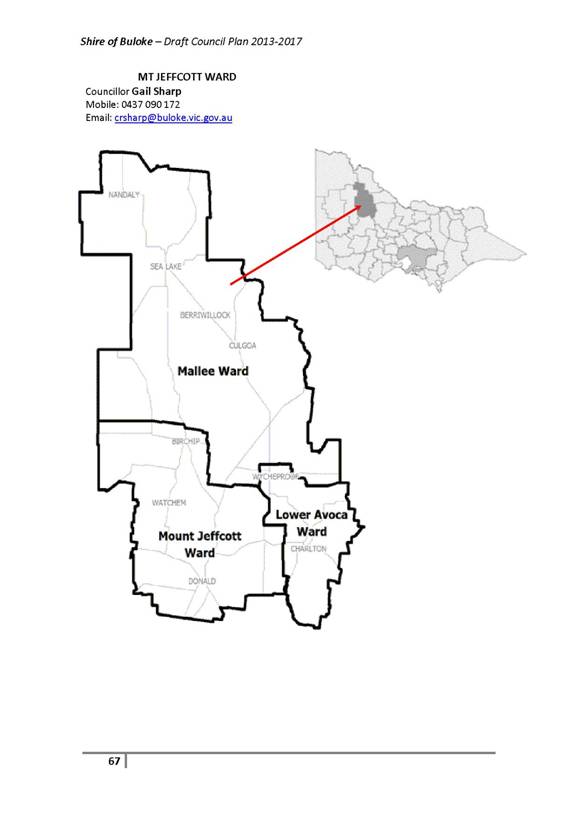
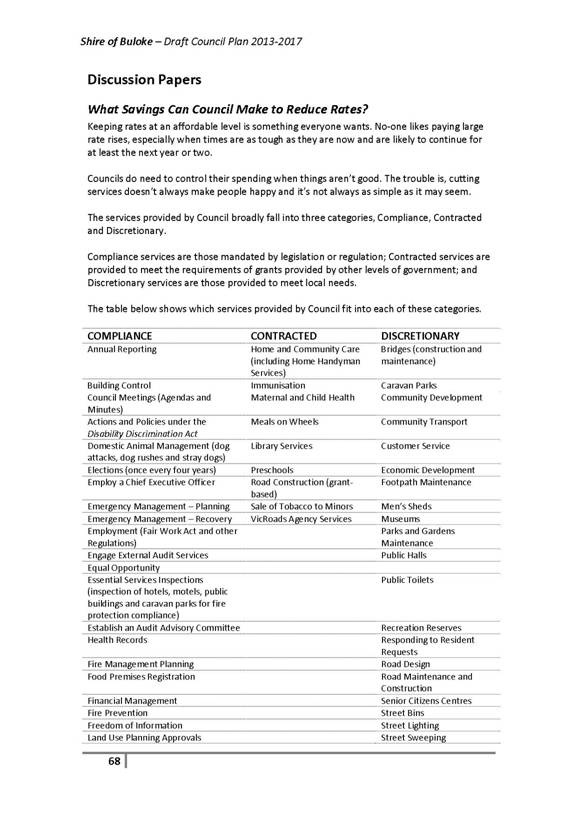
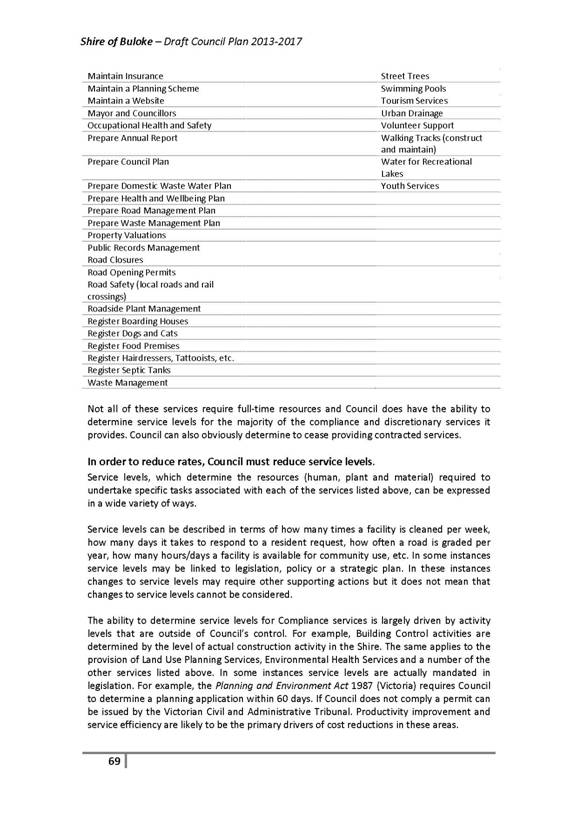
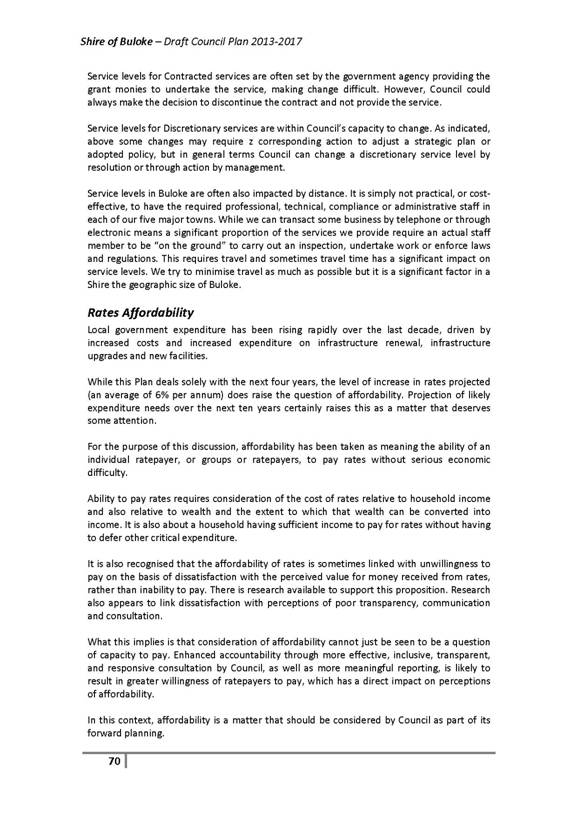
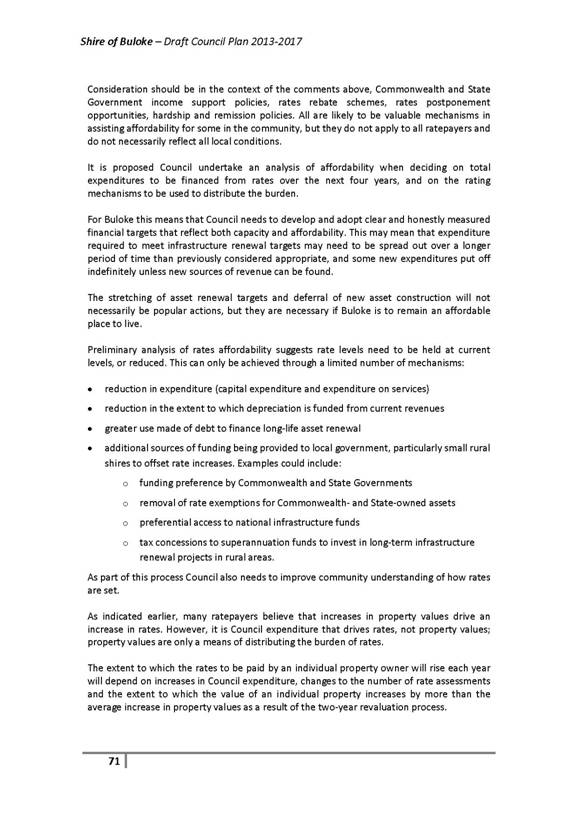
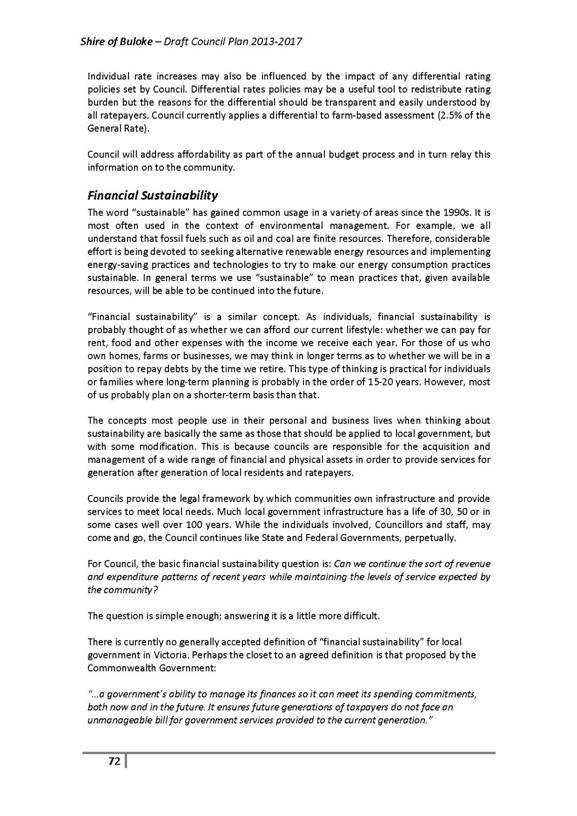
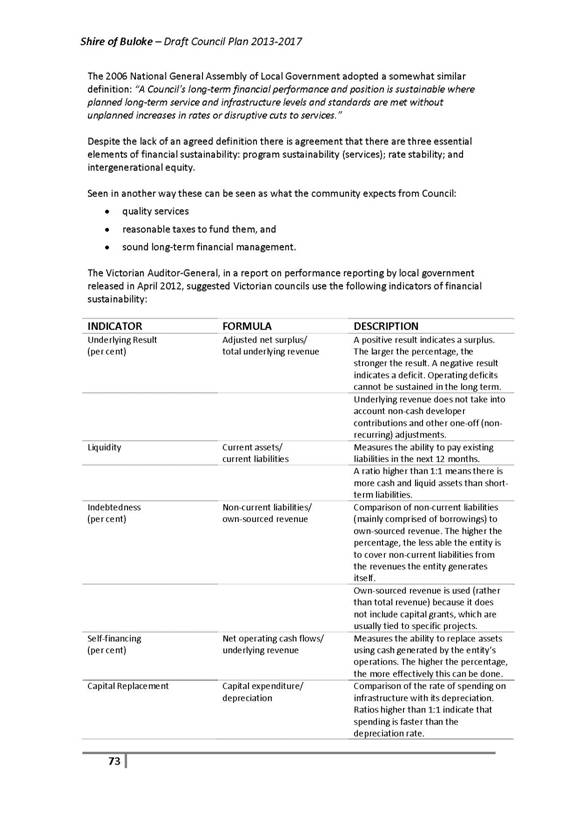
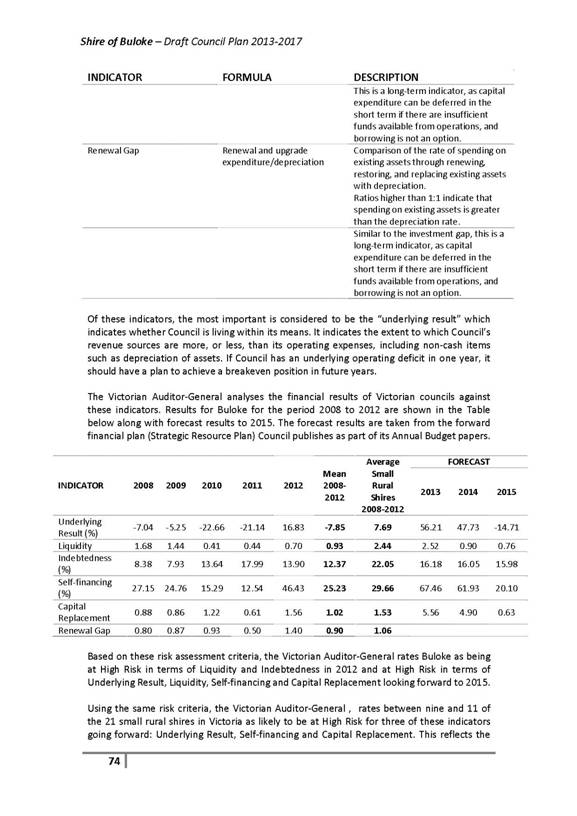
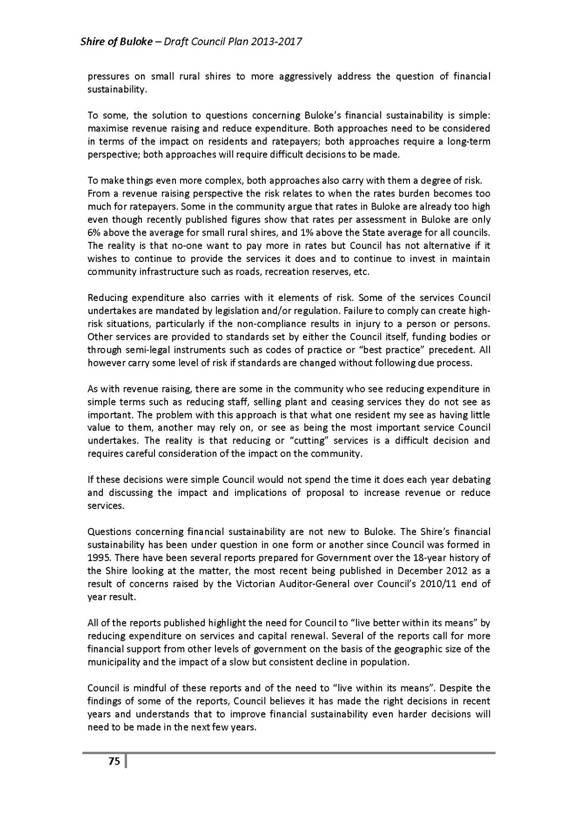
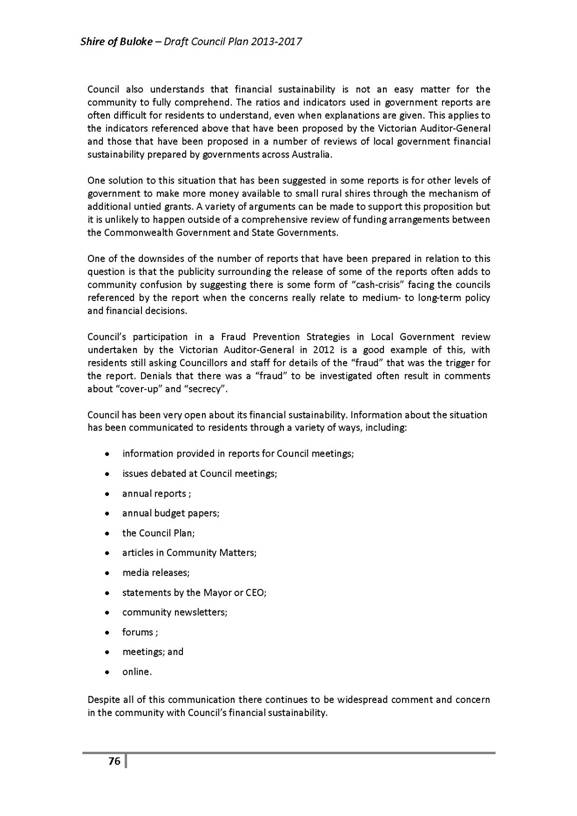
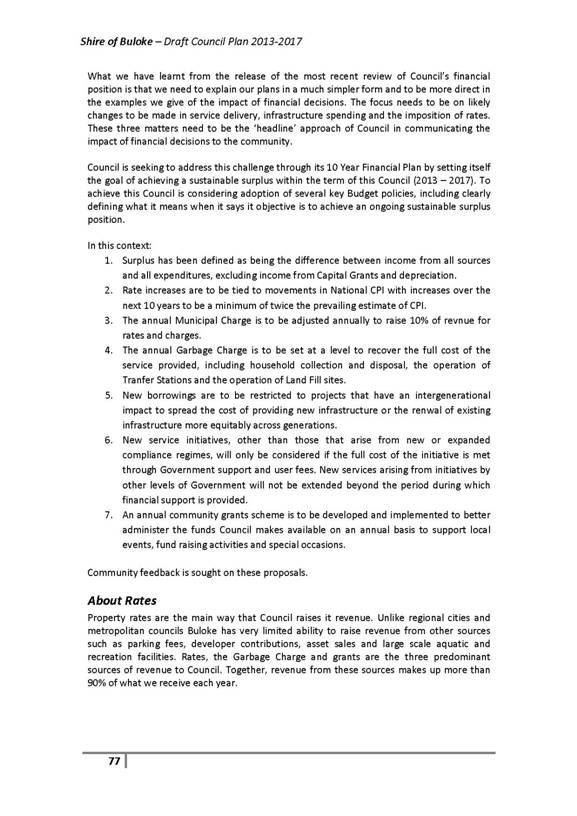
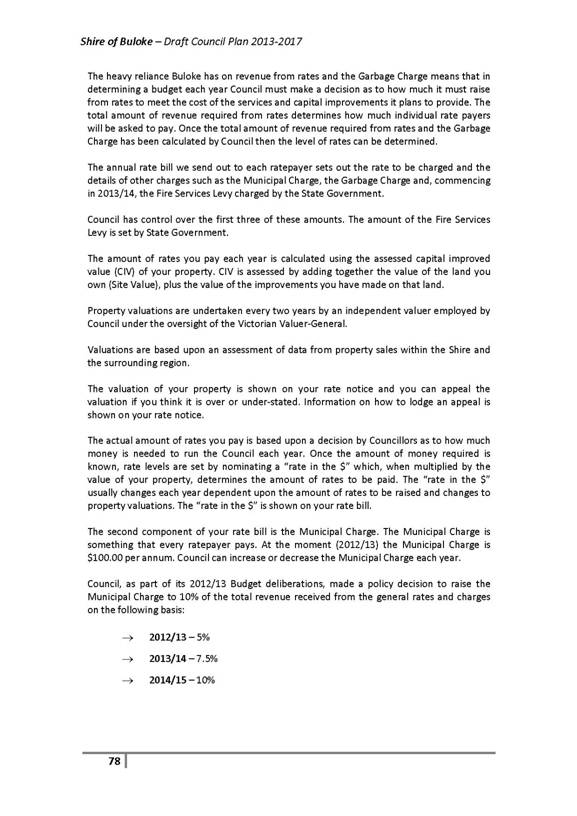
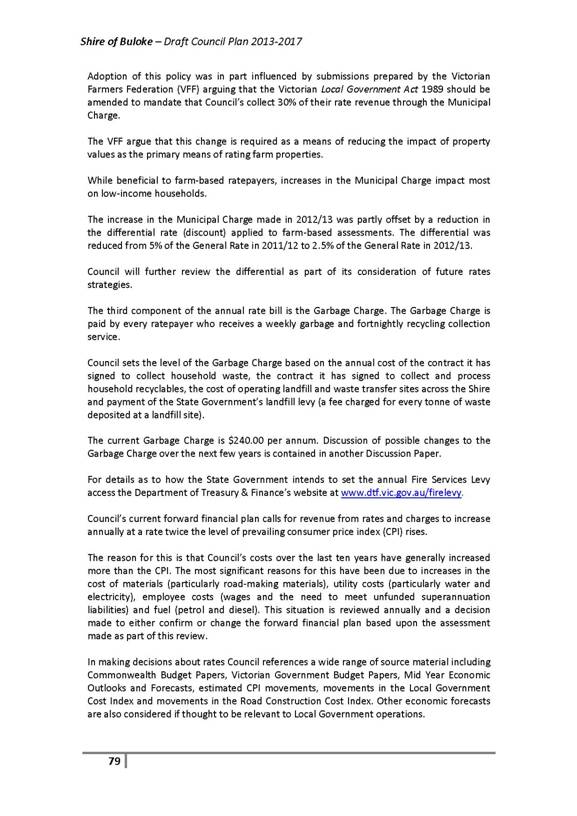
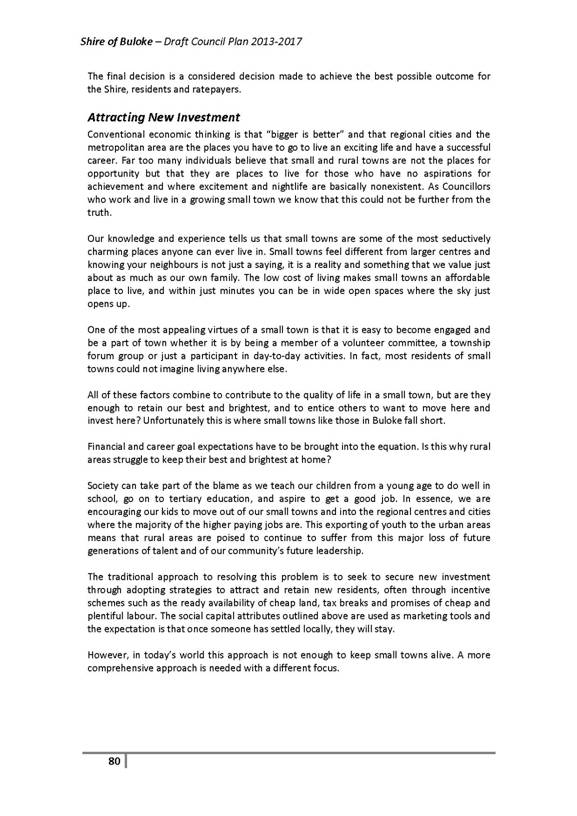
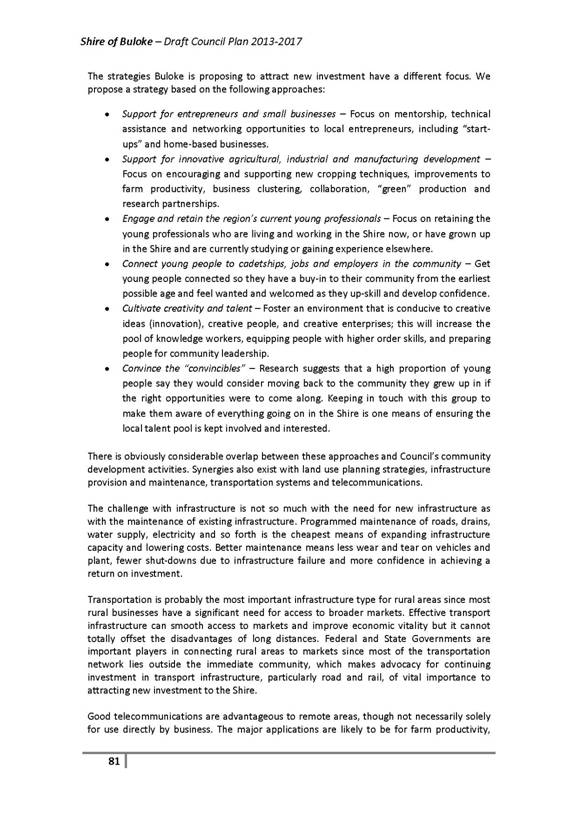
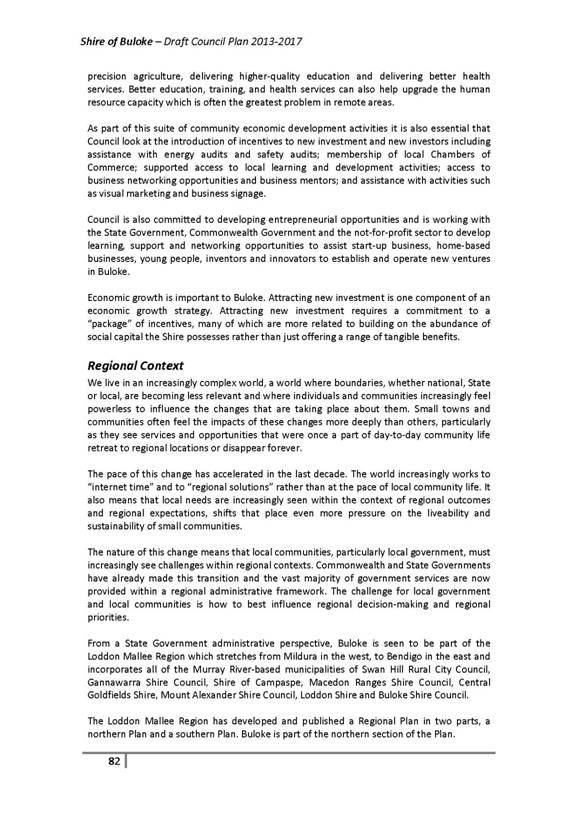
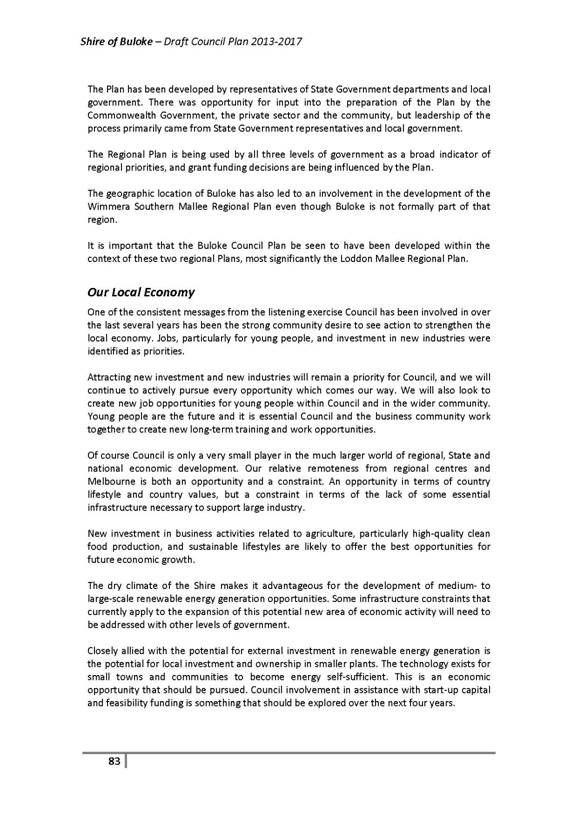
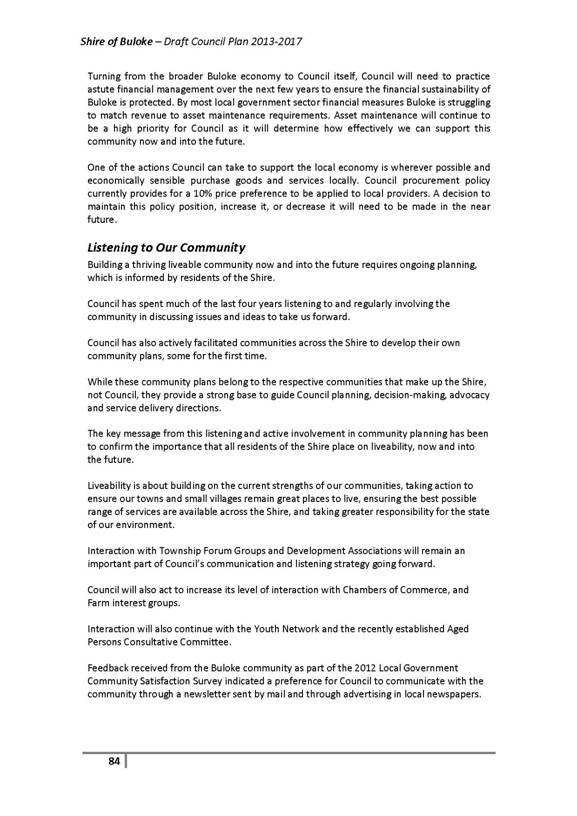
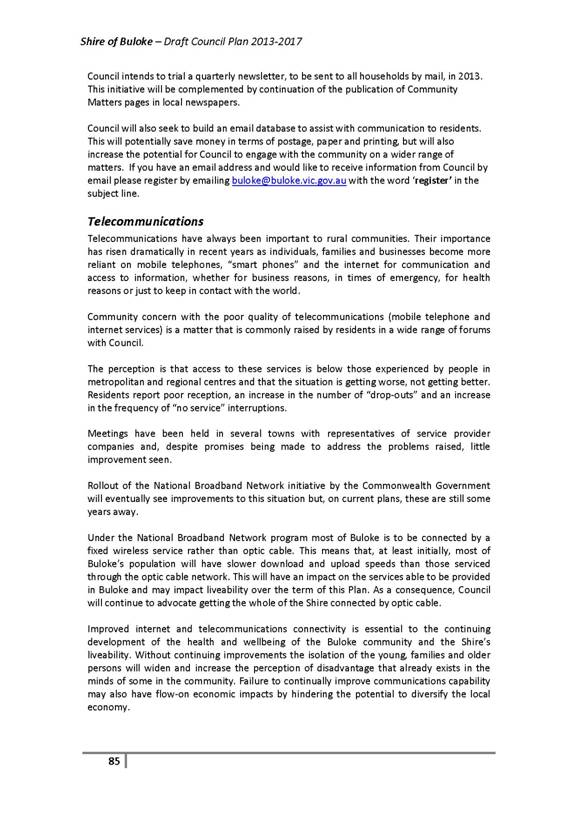
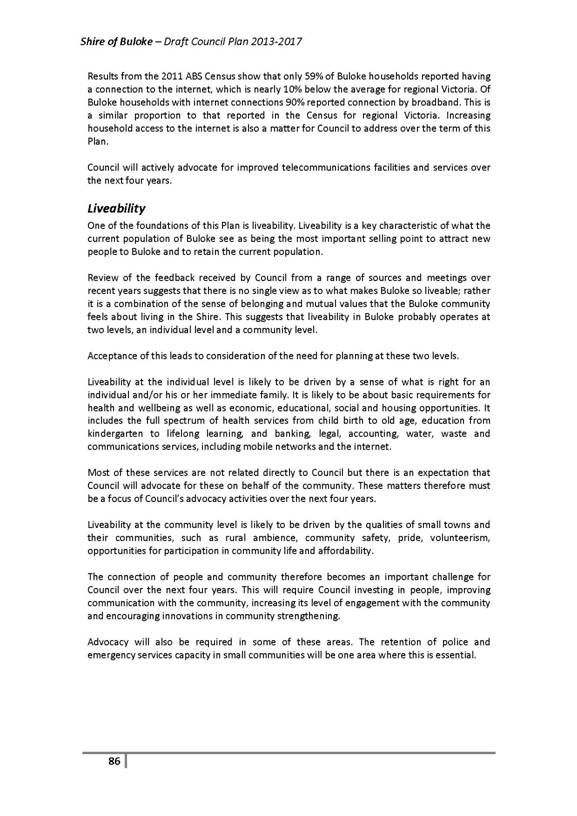
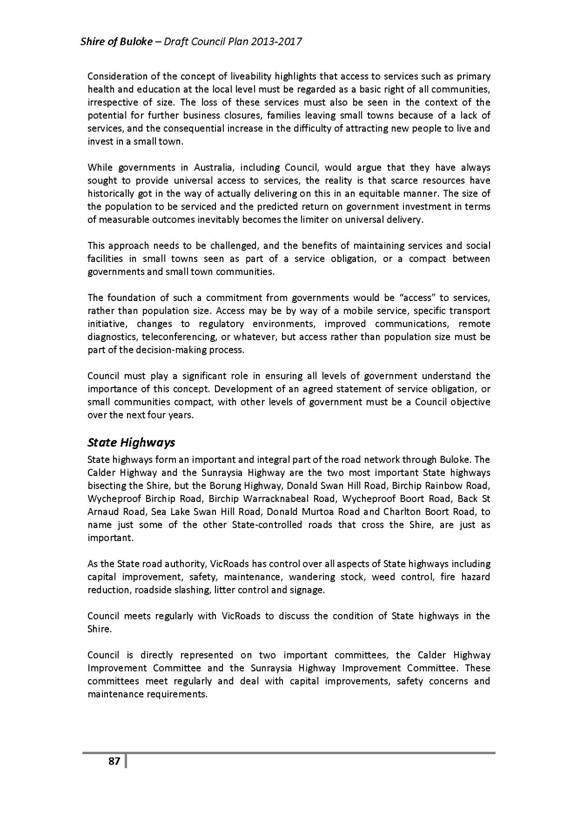
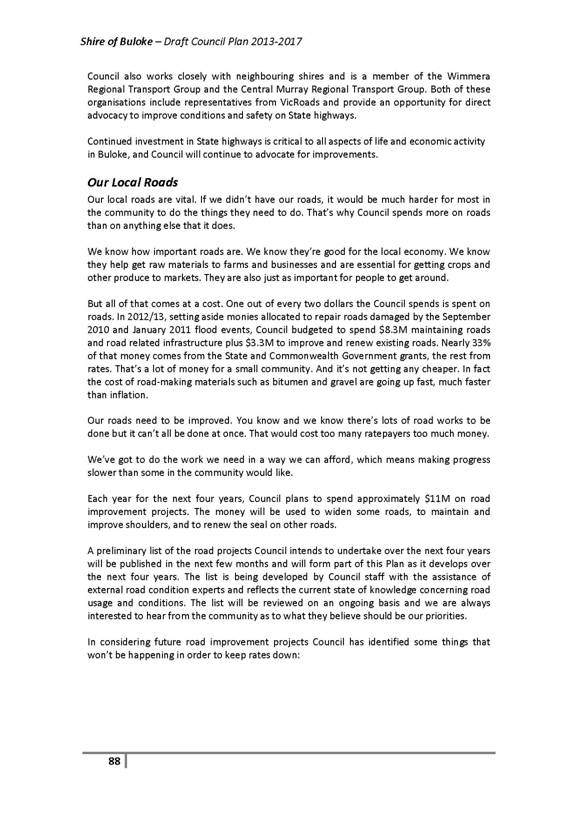
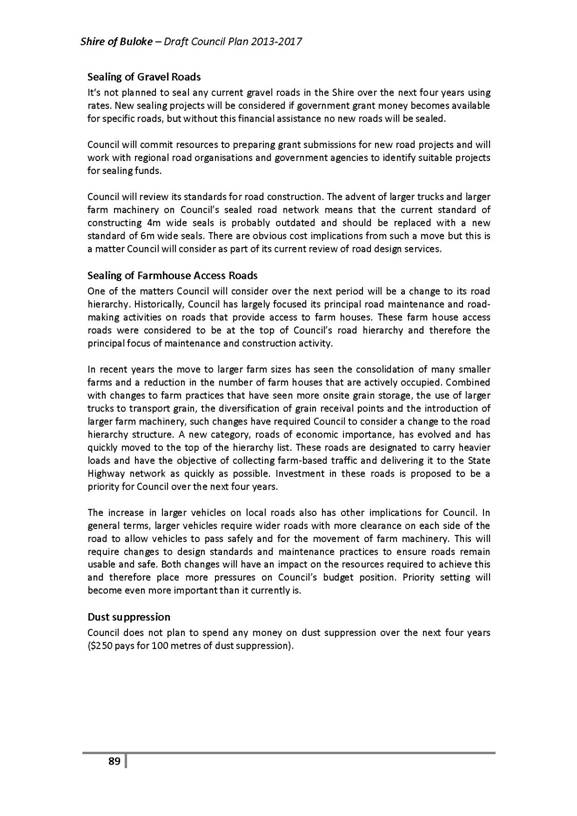
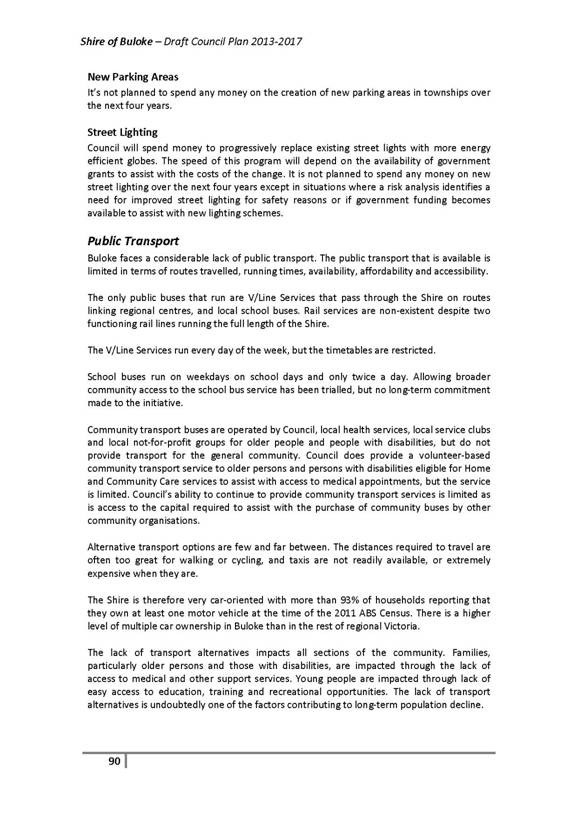
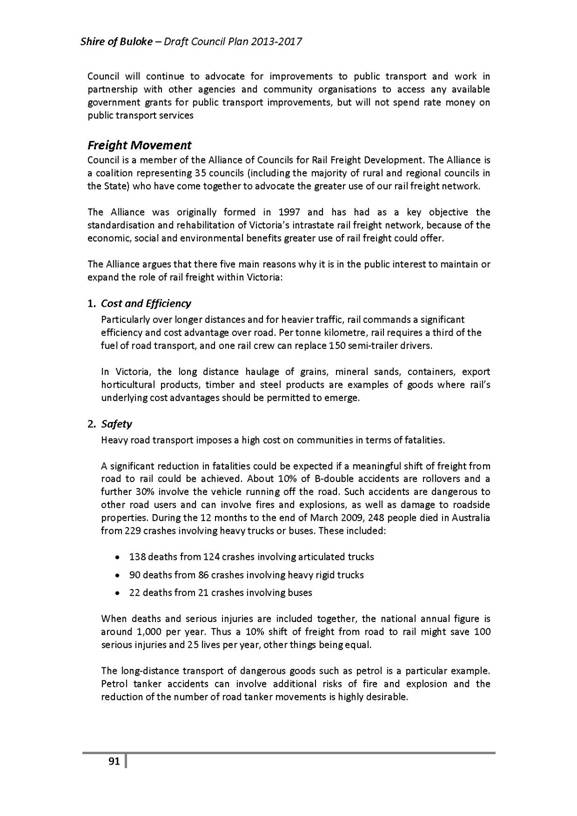
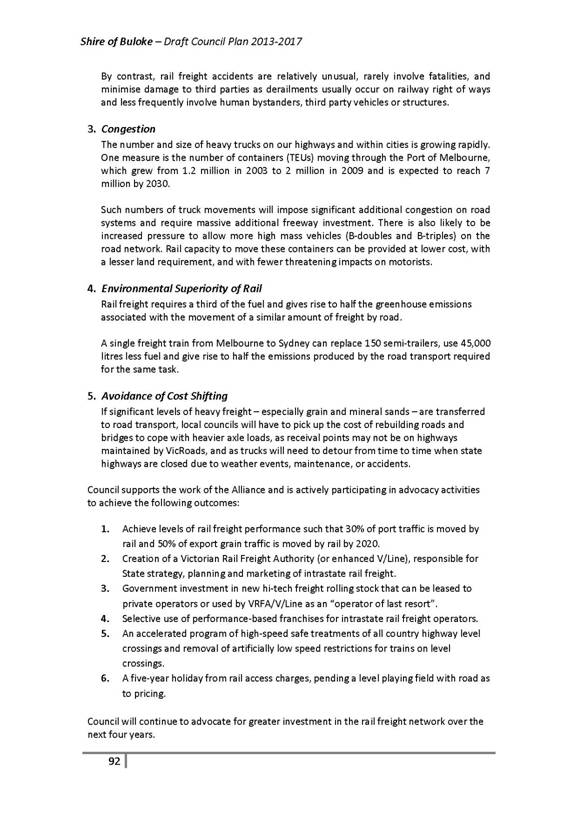
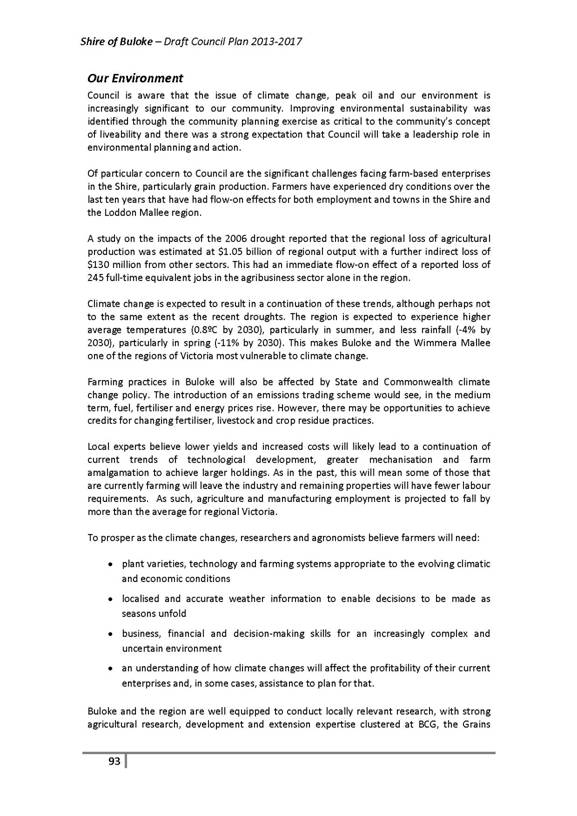
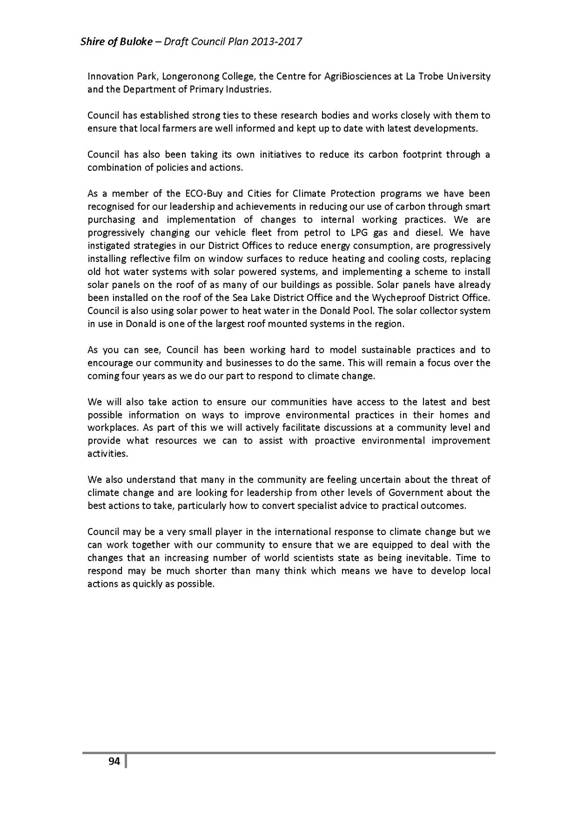
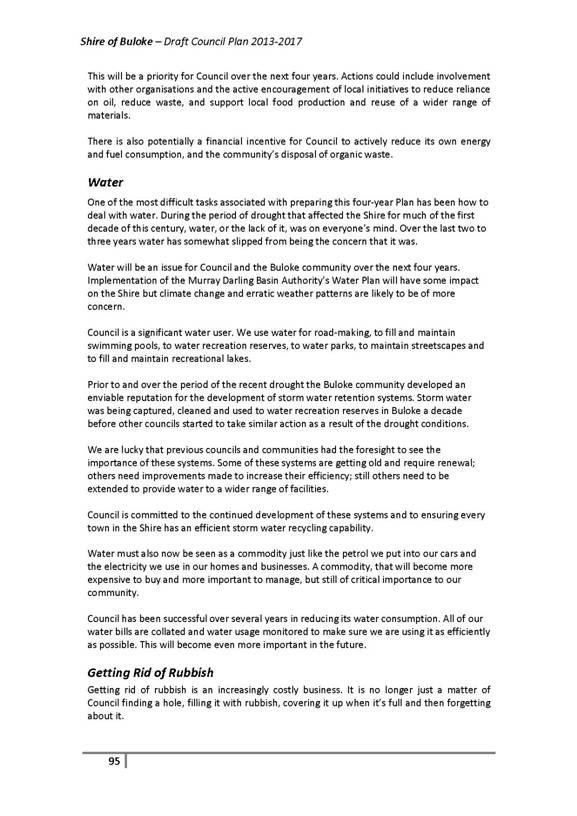

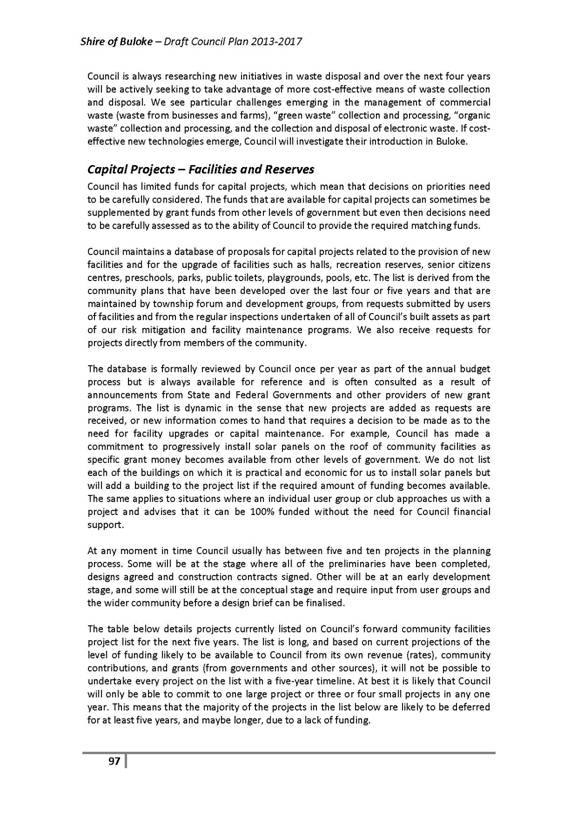
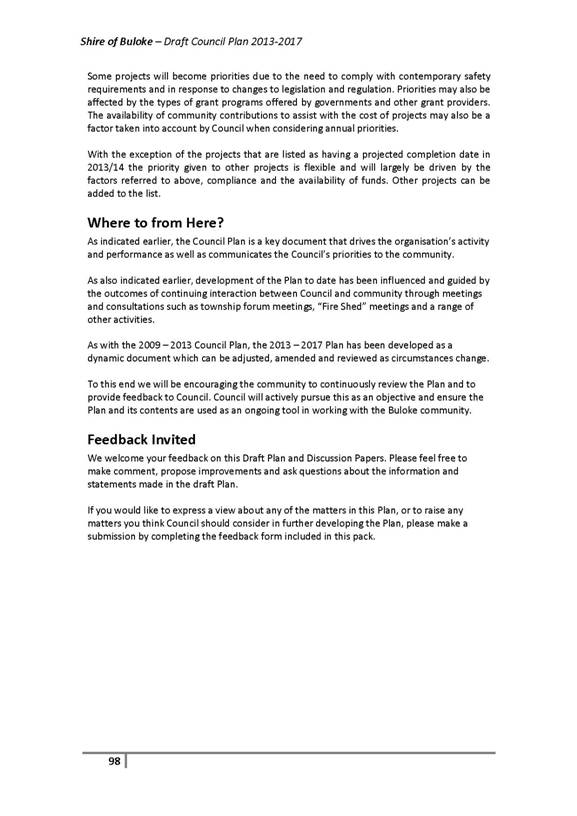
5.1.2 Proposed Budget For The Municipal Year Ending 30 June 2014
Author’s Title: Chief Executive Officer
Department: Office of the CEO File No: FM/05/02
|
1 ViewProposed Budget Year Ending 30 June 2014 |
Relevance to Council Plan 2013 - 2017
Objective: A Buloke community connected and involved in shaping decisions that affect them
Strategy: Working with communities and other stakeholders in planning for and making decisions about the future
Priority: ensure all major projects and strategies are informed through community and stakeholder consultation which is guided by Council’s community consultation framework and, where relevant, appropriate Advisory Committees and/or consultative mechanisms
|
That Council having considered the 2013/14 Proposed Budget resolves: 1. The budget document attached to this report be the budget prepared for the 2013/14 financial year 2. Give public notice of the Proposed Budget in accordance with Section129 of the Local Government Act 1989 (as amended) (the Act) and make available for public inspection the information required by the Act and the Local Government (Finance and Reporting) regulations 2004 3. To display the Proposed Budget at Council’s five District offices and on the Shire of Buloke website 4. To receive submissions on the Proposed Budget until close of business on Tuesday 27 August 2013 5. To appoint a Committee of the whole of Council to hear and consider any submissions received on the Proposed Budget on Wednesday August 28 2013 at 5.00pm in the Council Meeting Room at the Donald District Office 6. To implement differential rates to be struck as follows: General 0.7621% of CIV Commercial/Industrial 0.7621 of CIV Farm 0.7469 of CIV 7. The Municipal Charge be $150 for each rateable assessment in respect of which a Municipal Charge may be levied 8. Service Charges be declared as follows; Municipal Waste Charge $255 9. Early full rate payment discount of 1.5% on current yea rates and charges be granted if full payment (including ant arrears and interest) is received on or before Monday 30 September 2013 (The discount to exclude the Fire Services Property Levy).
Seconded: Cr Stuart McLean Carried. |
1. Executive Summary
This report recommends that Council give public notice of its intention to adopt a budget for the financial year commencing 1 July 2013 and ending 30 June 2014.
The proposed budget be placed on exhibition for a period of 28 days and submissions invited for consideration in accord with s223 of the Local Government Act 1989.
2. Discussion
The draft Council Plan 2013-2017 includes a 10 year forward financial plan (Strategic Resource Plan) that provides a financial framework for meeting the objectives established in the Plan.
The key objective of the 10 year financial plan is to achieve Council’s Strategic Objectives while continuously improving financial sustainability in the short, medium and long term.
The 2013/14 budget has been developed based on the 10 year financial plan, to facilitate the achievement of the Annual Actions listed in the Council Plan,
The Council Plan, 10 year financial plan and the 2013/14 budget have been developed simultaneously to ensure consistency across in short, medium and long term planning and to ensure that the opportunities, challenges and constraints that have been considered as part of the development of these important and significant documents have been consistently analysed and reviewed to inform better decisions.
Council also considered and agreed to a set of principles as part of the development of the 10 year financial plan and the 2013/14 budget as follows:
|
Theme |
Principle |
|
Best Value |
Take account of the Best Value Principles from the Local Government Act: · All services must meet quality and cost standards · All services must meet be responsive to the needs of the community · Each service must be accessible by those members of the community for whom the service is intended · Council must achieve continuous improvement in the provision of services to the community · Council must develop a program of consultation with its community in relation to the services it provides and report regularly to the community
|
|
Alignment |
Council’s budget will take account of the Council Plan, 10 year financial plan and other strategic plans
|
|
Balance |
The budget will aim to balance the demand for services and infrastructure with the community’s ability to pay.
Proposals for service delivery expansion or capital works projects must demonstrate consideration of social, economic and environmental impacts on the community
|
|
Operating Expenditure
|
Council will not borrow money to fund operating expenditure.
Operating expenditure should be funded through operating revenue streams such as rates, fees and charges or operating grants.
|
|
Recurrent Capital Expenditure |
The Council will not borrow money or obtain debt finance to fund the acquisition, replacement or renewal of assets that is expected to occur on an annual or similar basis at approximately the same level each year i.e. recurrent capital works. (Examples of this type of expenditure are road resurfacing, plant replacement, information technology and office equipment acquisitions and replacement. This type of expenditure must be funded through operating revenue streams such as rates and fees and charges.)
|
|
Borrowing |
Prior to undertaking any borrowing the council shall assess its capacity to pay, to ensure that the community is not burdened with unnecessary risk.
The council shall reassess its capacity to pay on an annual basis as part of its budget process. When assessing the borrowing ratios, consideration will be given to the economic earnings potential of the asset being acquired or constructed. The following indicators to be considered: · Liquidity Current Assets to Current Liabilities · Debt Exposure Total Liabilities to Total Realisable Assets · Debt Management Total Debt as a % of Revenue · Debt Management Debt Servicing Costs as a % of Total Revenue
The term of any borrowing shall be set having due regard to the Economic Life of the asset being acquired or constructed. (Council will not generally borrow funds to acquire an asset that has an economic life of less than ten (10) years. · Council will give favourable consideration to borrowing money for the acquisition or construction of an asset where:- · The asset to be acquired is a new addition to council’s asset base or replaces an existing asset with one that is significantly upgraded and has an Economic Life of greater than 10 years; or · All alternative options for undertaking the project without borrowing have been investigated and proven less advantageous to the council; or · The income stream from the asset to be acquired or constructed exceeds the cost of borrowing over the life of that asset; or · Repayments will be met by a third party through an agreement adopted by council · The index of the cost of acquisition or construction is increasing at a rate that exceeds the cost of borrowing i.e. to “save” for the acquisition or construction will result in the actual cost being greater than the cost of borrowing the money and acquiring it today As a general rule the benefits received from undertaking the borrowing should be greater, over the life of the borrowing, than the costs of borrowing.
The Council will not borrow funds when such borrowing would result in any of the following financial ratios being exceeded: · Current Assets to Current Liabilities <60% · Total Liabilities to Total Realisable Assets >150% · Total Debt as a percentage of revenue >100% · Debt Service Ratio >10% |
|
Rate Revenue |
Commit to eliminate present financial and infrastructure imbalances by 10 years’ worth of average annual % increases in rates, fees & charges of in excess of 2 times annual price inflation as measured by national CPI
(Note: National CPI may not be the best long term measure but it is a recognised benchmark and the ‘basket’ of items that is used to construct it is periodically changed to reflect contemporary requirements)
|
|
Municipal Charge |
Adjust the Municipal Charge to raise 10% of revenue from rates and charges through this mechanism by 30 June 2015.
7.5% of revenue from rates and charges to be raised through the Municipal Charge in 2013/14. . |
|
Benchmarking |
Council will continue to benchmark its financial decisions, financial ratios, rating policies and services against other small rural council’s with the objective of positioning itself to be better than the average for small Victorian rural councils across all indicators.
Benchmarking will be used to guide achievable productivity improvements.
|
|
Financial Sustainability |
Commit to a achieving a minimum sustainable operating surplus of 2.5% (income less expenditure excluding capital grants and depreciation) per annum within the shortest possible time and maintain this as the benchmark for development of the 10 year forward financial plan.
An operating surplus of 2.5% be achieved no later than 30 June 2016 and maintained at or above this level for the next 7 years.
|
|
User Fees and Charges |
Progress toward achieving full cost recovery for the major non-statutory fees and charges unless justification for another method is provided
Fees and charges (other than statutory fees and charges and those driven by specific contractual arrangements) are to be increased in line with CPI or market levels, unless an alternative business case is approved.
|
|
Revenue Sources |
New revenue sources are to be identified where possible
|
|
Employee Costs |
Achieve a reduction in employee costs through internal management practices (efficiency, and effectiveness and productivity) and natural attrition.
|
|
New Employee Positions |
New employee proposals which are not cost neutral (all cost basis) are to be justified through a business case that demonstrates increased service demand or the development of a new service/initiative which is aligned with the Council plan.
|
|
New Service Initiatives |
Council only considering new service initiatives if funds are made available from other sources, including other levels of Government, to meet 100% of the cost of the proposed service.
|
|
Working Capital Ratio |
Council’s objective is to attain and maintain a working capital ratio of no less than 150%; every $1 of current liabilities, Buloke has $1.50 of current asses to Achieve the Victorian Auditor General’s low financial risk rating.
|
|
Outsourcing |
Actively seek opportunities to outsource where local cost competitive service providers are available.
|
|
Community Capacity Building |
Work with the community to build its capacity to continue to contribute to the economic growth and wellbeing of the Shire.
|
|
Volunteer Capacity Building |
Continue to work with the community to maintain and grow the role of volunteers in the community.
Recognise the contribution volunteers make to the Buloke community.
|
|
Community Grants |
Develop and implement a Community Grants Scheme to ensure greater accessibility, transparency and accountability in the allocation of council funds to community organisations and individuals to assist with events, sponsorship and community activities.
|
Economic Impacts on the 2013/14 Budget
When preparing the 2013/14 budget, consideration has been given to the economic climate which will impact Council during the budget period.
Economic influences external to Council include:
· Constrained Federal and State Government fiscal environment
· Uncertainty of international markets which impacts agricultural production costs and margins
· General cost of living escalations
· Substantial increases in utility costs and insurance premiums
· The statutory environment which requires Council to meet legislative obligations, including:
o The introduction of the Fire Services property Levy required to be collected by local government
o Greater resource allocation to all aspects of emergency management planning
o Increased administration of domestic animal matters
o Increased compliance with regulations
· Increased community expectations regarding the need for flood mitigation works following the 2010 and 2011 flood events and the flow-on impacts these events have had on the insurance market and the regulatory environment facing home builders and others
Internal influences which have had a significant impact on the preparation of the 2013/14 budget being:
· Recommendations from the s135 Review of Council’s Financial Sustainability by the Minster for Local Government
· Recommendations from the Victorian Auditor General’s report on Fraud Strategies in Local Government
· Receipt of external funding for several large capital works projects that will require increased funding from rate revenue in 2013/14 and 2014/15
· Additional pressures resulting from the growth in service requirements and expectations, particularly in terms of roads
· The need to replace and upgrade ageing infrastructure
· The consequences of ongoing demographic change in the Shire (ageing population, changes to farming practices and the impact of new arrivals)
· Investment in developing workforce capability, particularly to achieve productivity, efficiency and effectiveness targets
· Recognition of the challenges in meeting strategic objectives in an environment of limited financial resources and the availability of appropriately skilled staff
2013/14 Budget
The proposed budget has been prepared in accordance with relevant statutory requirements including the Local Government (Finance and Reporting) Regulations 2004.
The key features of the proposed budget are:
1. Capital Works of $37.47M
During 2013/14 Council will continue to oversee the repair and reconstruction of roads and road related infrastructure affected by the 2010 and 2011 flood events. $28M will be spent during the year. All of the funds required for this work will be recovered through the Natural Disaster Response and Recovery Arrangements entered into by the Federal and State Governments.
During 2013/14 construction of the Donald Family Services Centre will be commenced.
Works commenced on the Berriwillock Community Centre, Sea Lake Swimming Pool and Charlton Swimming Pool will be completed.
If funding is received from the federal government work will commence on the detailed design of flood mitigation works in Charlton and Donald as recommended by the respective Flood Plans completed in 20112/13.
Road projects (excluding flood repairs) to the value of $1.57M will be completed.
2. An operating surplus of $25.7M including capital revenue of $33.51M.
3. The underlying result will be a deficit of $7.84M. (The underlying result is derived by deducting capital income from the comprehensive result.)
4. Repayment of debt of $0.57M.
5. An increase in income from Rates, the Municipal Charge and the Garbage Charge of 6%.
6. Differential Rating
In April 2013, Ministerial Guidelines for Differential Rating were gazetted and must be applied to this budget and the 2013/14 rating year
Differential rates are established to:
· Assist Council to meet its primary objective of endeavouring to achieve the best outcome for the local community having regard to the long term and cumulative effects of Council’s decisions (s3C(1) of the Act);
· To raise revenue to be used to improve the overall quality of life of people in the local community within Council’s municipal district (in accordance with the facilitating objective of s3C(c) of the Act); and
· To ensure the equitable imposition of rates and charges (in accordance with the facilitating objective in s3C(2)(f) of the Act).
Council applies two differential rates (Farm Rate and Commercial/Industrial Rate) through the application of a percentage to the General rate.
The Farm Rate in 2013/14 is 98% of the general rate.
The Commercial/Industrial Rate is 100% of the general rate.
The Farm Rate has remained the same as in the previous year and takes into account ongoing difficulties experienced by the farming sector and the decision by Council to increase the percentage of rates raised through the Municipal Charge.
7. Rate Levels:
General 0.7621% of CIV
Commercial/Industrial 0.7621% of CIV
Farm 0.7469% of CIV
8. Municipal Charge
The percentage of rates raised through the Municipal Charge has increased from 5% of total revenue from rates and charges in 2012/13 to 7.5% in 2013/14.
Council has indicated it will consider increasing the percentage of rates and charges revenue raised through the Municipal Charge to 10% in 2014/15.
This policy decision was influenced by submissions made to Council by local farm based ratepayers in support of a campaign by the VFF to mandate 30% of local government revenue from Rates and Charges being raised through the Municipal Charge.
9. An amount of $10.46M is estimated to be raised by general rates, municipal charge and the waste charge.
General Rates $9.03M
Municipal Charge $0.60M
Waste Charge $0.83M
10. The Municipal Charge will be increased from $100 to $150 for each rateable property to better address perceived inequities in the rating system as it impact farm based ratepayers.
11. An increase in the Garbage Charge of $21.70 to $255 per service to bring the revenue raised through the charge closer to a full cost recovery situation.
12. Early full rate payment discount of 1.5% on current year rates and charges to be granted if full payment (including any arrears and interest) is received on or before Monday 30 September 2013. (Note: the discount does not apply to the property Services Levy.)
13. A Community Grants Scheme is to be introduced in 2013/14 to ensure greater accessibility, transparency and accountability in the allocation of council funds to community organisations and individuals to assist with events, sponsorship and community activities.
The new Scheme will replace the former Mayor’s Fund arrangements, reporting on ad-hoc requests and historic sponsorship and support arrangements, including the provision of in-kind support.
The new Scheme is consistent with contemporary governance practices and its introduction follows the receipt of advice from the Local Government Investigations and Compliance Inspectorate of the need for reform.
An amount of $0.1M has been set aside for distribution through the Scheme.
The new arrangements will require many organisations who currently receive financial support from Council to apply under the new Scheme. A Guidelines document to the Scheme has been developed and community information and training opportunities will be offered.
3. Financial Implications
The proposed Budget 2013/14 provides the financial framework in which Council required to work for the forthcoming year.
Progress against the budget will be reported to Council on a monthly basis.
4. Community Consultation
The Council is required to give public notice of its intention to declare the rate and adopt the budget.
Section 223 of the Local Government Act provides that any person can make a submission to Council for consideration in respect to the budget within a 28 day period of formal notification. Council must hear any person requesting to be heard in respect to their submission.
Formal notification of the budget will be given in herald Sun on 29 July 2013 and in the three locally circulating newspapers the same week (week commencing 29 July 2013). During the public exhibition period the budget will be available for inspection at the Council’s five District offices and on the Shire of Buloke website being www.buloke.vic.gov.au. Publicity will be undertaken in the local media during the exhibition period.
The hearing of any submissions will be held on Wednesday 28 August, 2013 from 5.00pm in the Council Meeting Room at the Donald District Office.
A Special Council Meeting to consider any submissions received and adopt the budget will be held at 7.00pm at the Donald District office.
5. Internal Consultation
The budget has been prepared by the Finance Manager with extensive input from Councillors, the Senior Management team and Budget Managers.
6. Legislative / Policy Implications
In accordance with the Local Government Act 1989 Council must:
· prepare a budget for each financial year commencing 1 July (s127)
· declare the amount it intends to raise by general rates (s158)
· comply with guidelines established under s161 (Ministerial Guidelines for Differential Rating)
The Council must adopt its budget and forward a copy to the Minister for Local Government by 31 August 2013.
7. Environmental Sustainability
There are no environmental considerations arising from this report.
8. Conflict of Interest Considerations
Section 79C(2) of the Local Government Act indicates that if a budget or revised budget to be approved by Council includes funding for a matter of which a Councillor has a Conflict of Interest, the Councillor is taken not to have a Conflict of Interest for the purposes of approving the budget or revised budget if:
- The Council approved the matter and proposed funding previously; and
- The Councillor disclosed the nature of the Conflict of Interest when the decision in respect of the funding was originally considered and made.
This section of the Act means that if a Councillor has not previously declared a Conflict of Interest in the allocation in which they have a conflict, prior to considering the budget, the Councillor will have a Conflict of Interest in the budget and will therefore need to leave the Council Chamber and not vote on the budget.
9. Conclusion
As soon as practicable after Council has prepared its budget the Council must advertise that the budget has been prepared. The notice must
:
- State that a person has a right to make a submission under s223 of the Local Government Act 1989 on any proposal contained in the budget
- Advise that copies of the budget are available for inspection at the Council’s offices during normal business hours for at least 28 days after the publication of the public notice
As formal documentation has now been prepared the Council should proceed with the adoption of the proposed budget for the purpose of public advertisement and the consideration of public submissions.
Buloke Shire Council Special Meeting Minutes Thursday, 25 July 2013
5.1.1 Proposed Budget For The Municipal Year Ending 30 June 2014
Attachment 1 Proposed Budget Year Ending 30 June 2014
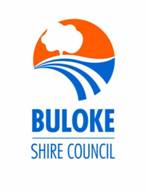
BULOKE SHIRE COUNCIL
Annual Budget
2013 – 2014
Contents
Mayor’s Introduction
Chief Executive Officer’s Summary
1.0 Budget Process
2.0 Strategic Planning Framework
2.1 Linkage to the Council Plan
2.2 Strategic objectives
3.0 Budget influences
3.1 Snapshot of Buloke Shire Council
3.2 External influences
3.3 Budget principles
3.4 Long term strategies
4.0 Analysis of Operating Budget
4.1 Budgeted income statement
4.2 Income
4.3 Expenses
4.4 Expenditure by Service Function
5.0 Analysis of Budgeted Cash Position
5.1 Budgeted cash flow statement
5.2 Restricted and unrestricted cash and investments
6.0 Analysis of Capital Budget
6.1 Capital works
6.2 Funding sources
7.0 Analysis of Budgeted Financial Position
7.1 Budgeted balance sheet
7.2 Key assumptions
8.0 10 Year Financial Plan (Strategic Resource Plan) and Key Financial Indicators
8.1 Plan development
8.2 Financial resources
8.3 Key financial indicators
9.0 Rating Information
9.1 Rating context
9.2 Current year rate increase
9.3 Rating Structure
9.4 Impact Assessment.
9.5 Beyond 2013/14
9.6 Rates Administration
9.7 General revaluation of properties
9.8 Fire Services Property Levy
10.0 Other Strategies
10.1 Borrowings
10.2 Infrastructure
10.3 Service delivery
11.0 Review of Mayor and Councillor Allowances
Appendices
Appendix A - Budgeted Standard Statements
Appendix B - Statutory disclosures
Appendix C - Capital works program
Appendix D - Fees and charges schedule
Buloke Shire Council Special Meeting Thursday, 25 July 2013
5.1.1 Proposed Budget For The Municipal Year Ending 30 June 2014
Attachment 1 Proposed Budget Year Ending 30 June 2014
Mayor’s Introduction
Buloke ratepayers will pay 6% more in rates and charges in 2013/14.
The increase is made up of a 4.4% increase in revenue from rates and a 23.4% increase in revenue from the Municipal Charge and the Waste Charge.
The increase is necessary to assist Council to ensure it can meet current and forward financial targets that are essential to the long term financial sustainability of the Shire.
The increase is also necessary to ensure Council can meet the cost of providing the range of services that it currently provides to the Buloke community.
Financial sustainability continues to be a significant consideration for Council. The Victorian Auditor General expressed concern with Council sustainability in regard to Council’s 2010/11 and 2011/12 Annual Accounts, particularly in terms of liquidity and the reliance on grants from other levels of government for infrastructure renewal.
In response to these comments and other reports concerning sustainability Council has adopted a forward budget policy as part of the 2013/14 Budget, committing to achieving a sustainable surplus within the shortest possible term. The policy sets out how this will be measured, and also makes a commitment to more effectively use the set of financial sustainability indicators developed and used by the Victorian Auditor General.
At the heart of the policy is a ten year forward financial plan that has been carefully developed to reflect the strategies that the current council, and future council’s, must consider when preparing annual budgets.
While adopting a budget policy and turning this into a 10year financial plan does not prevent a future Council from reviewing its position and changing the policy in the years ahead, it does signal that the current Council is serious in its endeavours to improve the current financial position and provide a foundation for further improvements.
As in 2012/13, a consequence of these considerations has been a need to restrict funding of new service initiatives in 2013/14 and to contain Capital Expenditure to projects that are either required to meet current contractual obligations, or are funded, partly or fully, by grants from other levels of government and community contributions.
The situation has also required Council to identify and act on opportunities to reduce expenditure wherever possible. This has been achieved without impacting current service levels, or failing to meet service delivery obligations as required by funding agreements with other levels of government. However, the 2013/14 Budget is based on funding for seven less staff position than in 2012/13. A further reduction in staff positions is projected for 2014/15 in order to meet the financial targets in the 10 year financial plan.
The positions shed in 2012/13 and 2013/14 have all been achieved through natural attrition. While service levels to the community will generally be maintained, the reductions in staff capacity will have an impact on Council completing some of the strategic planning and policy reviews it has previously committed to.
One significant initiative taken by Council in developing the 2013/14 Budget has been a decision to consolidate the means by which it considers requests from the community for support of community based activities (projects, events, sponsorship, etc.). Rather than consider these request on an ad-hoc basis as has been the case in the past 2013/14 will see the introduction of a Community Grants and Sponsorship Program which will require all requests for support, irrespective of whether for cash or in-kind, considered within a structured program format. This initiative is consistent with contemporary good governance practice. Community organisations will be assisted to make the transition from the current system to the new program.
When making Budget decisions for 2013/14 Council has also been conscious of the financial pressures facing residents and ratepayers. The decision to increase revenue from rates and charges was only made following careful consideration of all of the factors affecting the local economy and the need to ensure that liveability in the Shire does not decline.
As liveability is considered to be directly connected to the services delivered in the Shire achieving the right balance between affordability, and liveability, becomes a matter of direct concern to Council. Population decline is also an important element of this consideration. As population declines, irrespective of how slowly this may be occurring it has a direct impact on affordability and liveability.
Council has also determined to continue with the policy adopted in 2012/13 to restructure its rates strategy in accord with proposals developed by the Victorian Farmers Federation and supported by local farm based ratepayers.
In 2012/13 the value of rates raised through the mechanism of the Municipal Charge was increased to 5%. The value of rates to be collected through the Municipal Charge in 2013/14 will increase to 7.5%. Council remains committed to further increasing this to 10% in 2014/15. A Farm Rebate will continue to apply in 2013/14 and has been set at 98% of the General Rate.
Council has also determined to continue to set an annual Municipal Waste Charge.
As part of its long term financial strategy Council has determined to adjust this charge to reflect the full cost of waste services provided to residents (collection and disposal of putrescibles (household waste), collection and processing of recyclables, operation of land fill sites and transfer stations and the rehabilitation of closed landfill sites). The Municipal Waste Charge will increase to $255 in 2013/14 and increase further in 2014/15 to move closer to a full cost recovery situation.
Property values used for rating purposes in 2013/14 will remain the same as in 2012/13. The next revaluation will come into effect in 2014/15.
A consequence of the continuing restructure of Council’s rating strategy is that residential and commercial property owners will face slightly greater increase in rates in 2013/14 than farm based ratepayers. This is principally as a result of the increase in the proportion of rates collected through the Municipal Charge.
The 2013/14 Budget provides for a $37.5M Capital Works program, including $28.5M for the continuing repair and restoration of roads damaged by the January 2011 Flood Event.
The 2013/14 Budget projects Council will end the year with an operating surplus of $25.7M, an increase of $22.4M from the estimated 2012/13 end of year position which was a surplus of $3.3M.
The projected underlying result (revenue less operating costs (including depreciation)) is a deficit of ($7.9M), a marginal decrease of only $0.2M on the estimated 2012/13 end of year position, a deficit of $7.7M). This underlying result reflects the continuing fragility of Council’s long term financial sustainability and reinforces the need for careful ongoing management of operating costs and to consistently increase revenue to meet unavoidable cost increase.
Council’s long term financial plan demonstrates that it can return to a surplus situation but that this will take time and require strict adherence to the ensuring costs are reduced and revenue streams maximised.
The 2013/14 rating year also marks the beginning of new arrangements for the collection of the State Government’s Fire Services Property Levy. The levy, one off the recommendations of the 2009 Bushfire Royal Commission is being collected by local government on behalf of the State Government. The levy will appear on rate notices in 2013/14 and must be paid at the same time as municipal rates. The amount of the levy is set by State Government and cannot be changed by Council. The amount of the levy will be clearly marked on the rates notice.
The proposed 2013/14 Budget will be on public exhibition until Tuesday 27 August 2012 to provide the community with a chance to provide feedback.
You can view the proposed Budget and Council Plan at Council’s District Offices and Council’s website, www.buloke.vic.gov.au.
Budget at a glance
The proposed Budget is based on an increase in revenue from general rates and charges increase of 6%. This increase is made up of:
· 4.4% increase in average rates per assessment,
· $50 increase in the Municipal Charge ($150 Charge in 2013/14 compared to $100 Charge in 2012/13), and
· $15.00 increase in the Waste Collection Charge ($255 per service in 2013/14 compared to $240.00 in 2012/13)
· New borrowings of $1.55M to meet defined benefits superannuation scheme requirements.
What does it all cost for the ratepayer?
· Living in a median priced house (CIV $100,000) - $97.30 increase in annual rates and charges OR $1.87 extra a week
· Operating a median priced commercial business (CIV $150,000) - $91.30 increase in annual rates and charges OR $1.75 extra a week
· Operating a median priced farm (CIV $250,000) - $112.75 increase in annual rates and charges OR $2.17 extra a week.
2013/14 Capital Works - Highlights:
Council has allocated $32.4M in the 2013/14 Budget to ensure infrastructure assets continue to meet the needs of the community now and into the future.
· $28.5M towards the repair and restoration of roads damaged by the January 2011 flood events (the cost of these works is recovered through the National Disaster response and Recovery Arrangements administered through the Victorian government);
· $1.9M for the reconstruction and rehabilitation of sections of the road network;
· $3.7M for building works including commitments to building works at the Berriwillock Community Centre, Donald Family Services Centre, Swimming Pools, Recreation Reserves and Charlton Travellers Rest;
· $0.07M on improvements to recycling facilities at landfill sites; and
· $0.1M for footpath improvements.
In conclusion, I would like to thank my Councillor colleagues, senior staff and all of the other staff who have participated in the development of this budget.
Cr Reid Mather
Mayor
Buloke Shire Council Special Meeting Thursday, 25 July 2013
5.1.1 Proposed Budget For The Municipal Year Ending 30 June 2014
Attachment 1 Proposed Budget Year Ending 30 June 2014
Chief Executive Officer’s Summary
Council has prepared a Budget for the 2013/14 financial year which seeks to balance the demand for services and infrastructure with the community’s capacity to pay.
Key budget information is provided below about the rate increase, operating result, service levels, cash and investments, capital works, financial position, financial sustainability and key strategic activities of the Council.
As part of a comprehensive strategy to address the concerns expressed by the Victorian Auditor General and others about Council ongoing financial sustainability the 2013/14 Budget has been prepared within the context of a long term (10 year) financial plan. The key focus of the 10 year financial plan has been to guide financial decisions to return Council to a sustainable surplus position.
The ten-year financial plan provides an overview of Council’s approach to management of its operations, capital works program and associated rating and revenue strategies.
The ten year financial plan is based on the following key strategies aimed at ensuring the long-term viability and amenity of the Shire:
· Increases in revenue from rates and charges over the period of the Plan of 6.0% per annum.
· A commitment to achieve a surplus of a minimum of 2.5% on an ongoing basis as soon as possible within the ten-year period. (For the purpose of the ten-year plan ‘surplus’ has been defined as being operating income, less operating expenses, excluding depreciation and capital grants.)
· To target reaching a ‘break-even’ position by 30 June 2016 and for the remainder of the plan to seek to achieve the 2.5% surplus defined above.
· To contain future increases in employee costs to national Consumer Price Index (CPI) increases or less
· A projected increase in Financial Assistance Grants in line with CPI over the life of the Plan.
· Continuous review of service levels for all services offered.
· The funding of both operating expenditure and base capital works from recurrent revenue sources, capital subsidies and cash reserves.
· An asset sales program over the life of the Plan of approximately $1.5M to ensure unused land and buildings are offered to the community for alternative uses and value gained from plant and equipment that has been replaced or upgraded as part of normal the plant and equipment replacement strategies.
· Maintenance of a level of cash investment to meet non-discretionary funding commitments.
· A program of rolling capital works over the four years including:
® Upgrade of swimming pools with a focus on water quality management and water conservation
® Renewal of playgrounds to contemporary standards
® improvement to township drainage with a focus on storm water management and water re-use
® Ground improvements to principal recreation reserves
® Upgrade of public amenities
A summary of the 10 year plan is shown in the Table below.
|
Budget Target Savings Required to Reach Desired 2.5% Underlying Result |
Actual |
Forecast |
Budget |
Forecast |
Forecast |
Forecast |
Forecast |
Forecast |
Forecast |
Forecast |
Forecast |
Forecast |
|
2011/12 |
2012/13 |
2013/14 |
2014/15 |
2015/16 |
2016/17 |
2017/18 |
2018/19 |
2019/20 |
2020/21 |
2021/22 |
2022/23 |
|
|
|
$'000's |
$'000's |
$'000's |
$'000's |
$'000's |
$'000's |
$'000's |
$'000's |
$'000's |
$'000's |
$'000's |
$'000's |
|
Total Revenue excluding Capital Grants and Asset Sales |
17,139 |
15,985 |
15,525 |
16,685 |
17,476 |
18,309 |
19,188 |
20,114 |
21,092 |
22,124 |
23,212 |
24,361 |
|
Comprehensive result |
7,229 |
3,265 |
25,636 |
(1,676) |
(2,238) |
(2,916) |
(2,518) |
(2,005) |
(1,452) |
(858) |
(218) |
469 |
|
less Capital income |
(14,608) |
(10,998) |
(33,526) |
(5,407) |
(4,495) |
(3,464) |
(3,478) |
(3,573) |
(3,671) |
(3,771) |
(3,874) |
(3,980) |
|
Underlying result |
(7,379) |
(7,733) |
(7,889) |
(7,083) |
(6,732) |
(6,379) |
(5,996) |
(5,578) |
(5,123) |
(4,629) |
(4,092) |
(3,510) |
|
Add Back Depreciation |
6,483 |
6,396 |
6,326 |
6,678 |
6,678 |
6,678 |
6,678 |
6,678 |
6,678 |
6,678 |
6,678 |
6,678 |
|
Net Result |
(896) |
(1,338) |
(1,563) |
(405) |
(54) |
299 |
683 |
1,100 |
1,555 |
2,050 |
2,586 |
3,168 |
1. Revenue and Rates
Revenue in the Buloke context is relatively one dimensional; rates and charges. Council’s ability to raise revenue from user fees is relatively small, but as with other factors impacting our financial situation it is not something that can be ignored.
Council has been consistent over the last five years in increasing revenue from rates and charges by approximately 6% per annum. This has secured a steady and increasing revenue stream as shown in the graph below. This policy is forecast to continue as part of the 10 year forward financial plan.
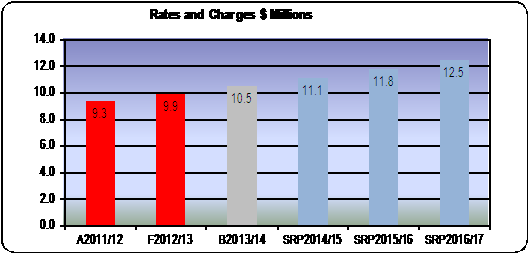
It is proposed that general rates increase by 4.4% for the 2013/14 year, raising total rates of $9.02M.
The Municipal charge has been increased from $100 to $150. Revenue from the Municipal charge increasing from $0.46M in 2012/13 to $0.6M in 2013/14.
Two differential rates are to be declared.
The rate for commercial/industrial properties is to be the same as the general rate.
The rate for farm properties is to remain at 98% of the general rate.
Total revenue to be raised through rates and charges for the year will be $9.9M, an overall increase of 6% over the previous year.
2. Operating result
The expected operating result for the 2013/14 year is a surplus of $25.7M which is an increase of $22.4M in comparison to the previous year
The size of the surplus is affected by the receipt of $28.5M in capital grants for the repair of flood affected roads. These grant funds were programmed to be received in 2012/13, but is now to be received in 2013/14.following a decision by the Federal Government in late June 2013 to extend the period for which flood repair works can be claimed to 30 June 2014.
The underlying result, which excludes capital grants and non-cash contributions, is a deficit of $7.8M, an increase of $0.1M over 2012/13.
The forecast operating result for the 2013/14 year is a surplus of $3.3M
The graph below shows the trend in the operating result through to the 2016/17 financial year.
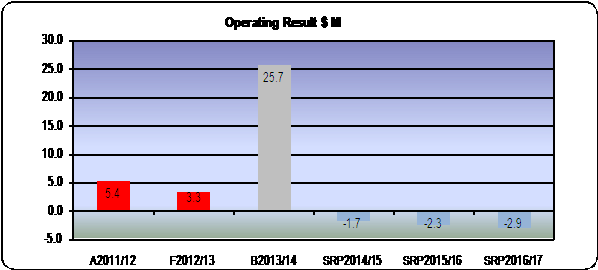
3. Services
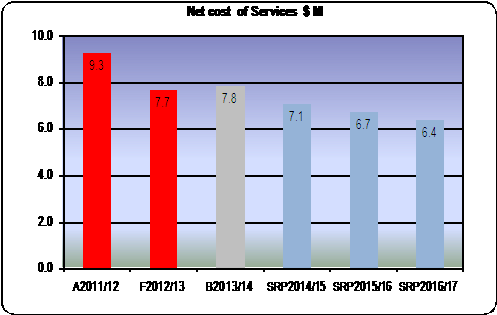
The net cost of services delivered to the community in 2013/14 year is expected to be $7.8M, an increase of $0.1 from 2012/13.
The increase is predominantly due to projected increases in the cost of materials and services.
No specific change in service levels is projected for the 2013/14 year. However all services will be subject to continuing review as Council endeavour to make the savings necessary to meet the targets set in the 10 year financial plan. .
4. Cash and investments
The level of cash and investments will reduce over the next year as the funds received, particularly for flood repairs are expended.
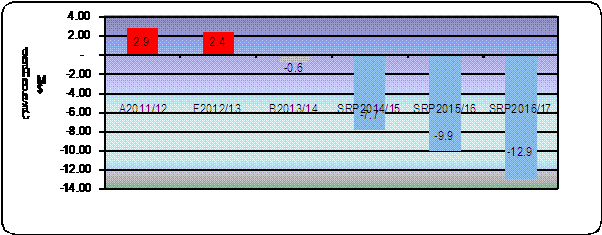
Setting aside the flood grant monies cash and investments are expected to decrease by $3.0M during the year, resulting in an overdraft balance of $0.6M as at 30 June 2014. This is due to payments associated with the cost of capital works from 2012/13 carried forward to 2013/14 and outflows associated with major building projects programmed for 2013/14.
The reduction in cash and investments for the period 2014/15 to 2016/17 is in line with Council's 10 year financial plan. It is based on a conservative outlook of future grant allocations due to uncertainty as to the continuation of current Federal and State Government capital funding grants schemes. If these schemes are changed as a result of future government policy the current forward Capital Works program will need to be adjusted to reflect the situation.
5. Capital works
Capital works expenditure for the 2013/14 year is forecast at $37.5M.
This is the largest capital works program ever undertaken by the Shire.
The program is predominantly Grant funded with $28.5M coming from grants received for flood rectification works and $1.0M from the State Government’s Country Roads and Bridges program.
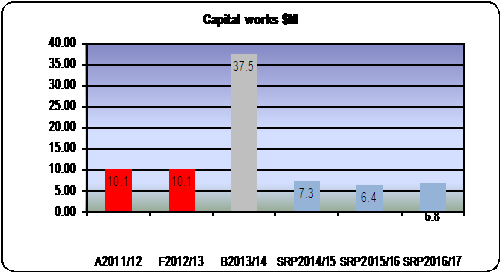
2013/14 will also see commencement of construction of the Donald Family Services Centre. Construction of this project will commence in the second half of 2013/14 and be completed on 2014/15. The project is funded through a mix of Federal, State, Council and local community contributions. One component of the State Government’s funding for this project ($1.0M) was received in 2013/14. Other funding will be received as construction milestones are met.
The capital expenditure program has been set and prioritised based on an assessment of need, a process of consultation with local communities and alignment with community plans.
6. Financial position
Preparation of the 10 year financial plan has highlighted the continuing fragility of Council’s financial position. Changes to anyone of the parameters that have been agreed as the basis of the plan will have consequential impacts on Council’s capacity to continue to provide the services that it does.
The key issue for Council in looking forward is the maintenance of adequate Working Capital. While an anticipated revaluation of assets will strengthen Council’s balance sheet it does not provide any real cash to meet the day to day costs of providing services to the community. To provide services Council needs to be in a liquid cash situation. Assessing and monitoring this situation is one of the values of developing the 10 year financial plan.
The future forecast for Working Capital is shown in the following table. It is a ‘grim’ picture and highlights the need for Council to continue to increase revenue, reduce operational expenditure and further restrict capital expenditures.
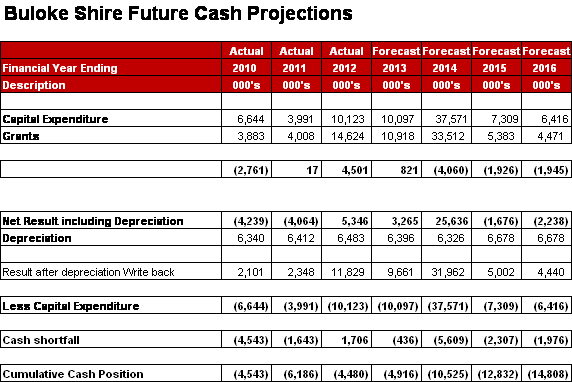
The tight working capital situation can be attributed to a number of factors but perhaps the principal contributor has been an over commitment to capital expenditure from council funds and not from external grants.
In the past capital projects have been funded from short term funds and this cannot be allowed to continue, particularly when Council is running at an operating deficit.
Council has been fortunate over recent years that advance capital funds have been received to maintain working capital. While this may continue in the future, it is not something that Council should rely on when considering its future financial plans.
To rectify this situation requires a reduction in operational and capital expenditure over the next two to three years and a commitment to maintain this for the remainder of the 10 year financial plan. Difficult decisions concerning future revenue streams, the maintenance of facilities, services and infrastructure will need to be made to achieve this going forward.
8. Concluding Remarks
This budget has been developed through a rigorous process of consultation and review and management endorses it as financially responsible. More detailed budget information is available throughout this document.
Warwick Heine
Chief Executive Officer
Buloke Shire Council Special Meeting Thursday, 25 July 2013
5.1.1 Proposed Budget For The Municipal Year Ending 30 June 2014
Attachment 1 Proposed Budget Year Ending 30 June 2014
1.0 Budget Process
The Local Government Act 1989 requires Council to prepare and adopt an annual budget for each financial year. The budget is required to include certain information about the rates and charges that Council intends to levy as well as a range of other information required by the Regulations which support the Act. The budget is required to be adopted and a copy submitted to the Minister for Local Government by 31 August each year
The 2013/14 budget, which is included in this report, is for the year 1 July 2013 to 30 June 2014 and has been prepared in accordance with the Act and relevant Regulations.
The budget includes standard statements being a budgeted Income Statement, Balance Sheet, Cash Flows and Capital Works. These statements have been prepared for the year ended 30 June 2014 in accordance with the Act and Regulations, and consistent with the annual financial statements which are prepared in accordance with Accounting Standards.
The budget also includes detailed information about the rates and charges to be levied, the capital works program to be undertaken and other financial information, which Council requires in order to make an informed decision about the adoption of the budget.
The key process followed to prepare the budget is summarised in the Table below.
|
Budget process |
Timing |
|
1. Officers update Council's long term financial projections |
March/May |
|
2. Officers prepare operating and capital budgets |
Jan/May |
|
3. Councillors consider draft budgets at informal briefings |
Mar/May |
|
4. Proposed budget submitted to Council for approval |
May |
|
5. Public notice advising intention to adopt budget |
June |
|
6. Budget available for public inspection and comment |
June |
|
7. Public submission process undertaken |
Jun |
|
8. Submissions period closes (28 days) |
July |
|
9. Submissions considered by Council/Committee |
July |
|
10. Budget and submissions presented to Council for adoption |
July |
|
11. Copy of adopted budget submitted to the Minister |
Aug |
|
12. Revised budget where a material change has arisen |
Sep-Jun |
2.0 Strategic Planning Framework
2.1 Linkage to the Council Plan
The budget is directly linked to the Council Plan 2013-2017. This ensures the budget is directly aligned to the outcomes set out in the Council Plan.
As part of the process of developing the Council Plan 2013-2017 and the 2013/14 Budget Council has also developed a 10 year forward financial plan.
The 10 year financial plan sets out Council’s financial objectives for the period and will be used on an ongoing basis to ensure decisions made are consistent with the objectives of the plan.
The diagram below depicts the strategic planning framework used by Council.
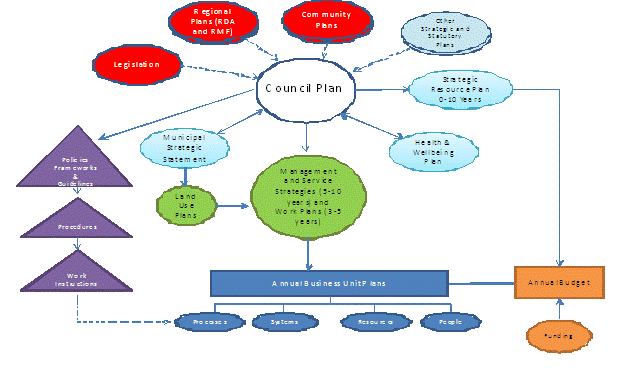
The timing of each component of the planning framework is critical to the successful achievement of the planned outcomes. The Council Plan, including the Strategic Resource Plan, is required to be completed by 30 June following a general election and is reviewed each year by February to ensure that there is sufficient time for officers to develop their Activities and Initiatives and Key Strategic Activities in draft form prior to the commencement of the Annual Budget process in March. It also allows time for targets to be established during the Strategic Resource Planning process to guide the preparation of the Annual Budget.
1.2 Our purpose
Our Vision, Mission and Values
2.2 Strategic objectives
Council delivers activities and initiatives under 72 service categories. Each contributes to the achievement of one of the five Strategic Objectives as set out in the Council Plan.
The Council Plan 2013-2017 sets out 5 Strategic Objectives. The 5 Strategic Objectives set out in the plan, the priorities identified to be achieved in meeting the objectives and how progress is to be measured is detailed below:
Strategic Objective 1: Our Community
A Buloke community where people of all ages, backgrounds and abilities are embraced and supported and can access the Council services they need to live healthy and fulfilling lives.
A Buloke community connected and involved in shaping decisions that affect them.
1.1 Working with the community to make Buloke an even better place to live.
Priorities
· advocating for and investing in innovative models of service delivery.
· continuously reviewing the services provided to ensure they are meeting community needs and are being delivered efficiently in a cost effective manner.
· supporting and valuing volunteers.
· supporting the provision of a broad range of housing choice, affordability and availability.
· supporting the provision of innovative support and services to an aging population.
· engaging with and connecting with young people.
· advocating for improved health outcomes.
· supporting sports and recreation clubs and facilities.
· supporting the continuing development of community-based arts and cultural activities.
· collaboration with tertiary institutions and other research organisations to increase our knowledge of local service needs, aspirations and indicators of wellbeing.
Challenges
· Connecting with young people across the Shire and engaging them in decision making and planning futures.
· Maintaining and developing a pool of trained volunteers to continue to support community endeavours across the Shire.
1.2 Working with communities and other stakeholders in planning for and making decisions about the future.
Priorities
· Ensure all major projects and strategies are informed through community and stakeholder consultation which is guided by Council’s Community Consultation framework and, where relevant, appropriate advisory committees and/or consultative mechanisms.
· Explore current and future opportunities to improve Council’s community engagement and consultation activities.
· Actively engage with township forums, progress associations, Chambers of Commerce and other organisations to further develop and implement their respective community plans.
· Celebrate the vitality and resilience of towns and localities across the Shire through facilitation and support for events and community festivals.
· Continue to identify and pursue grant opportunities for community-based organisations across the Shire and provide support and assistance where appropriate.
· Continue to work with local communities to maintain linkages with past residents through providing advice on local events through print and electronic media opportunities.
Challenges
· Developing the capacity to make use of changing technologies to connect with, communicate with and engage with the community.
· Maintaining the currency and relevance of community plans to communities across the Shire.
1.3 Working with communities and other stakeholders to maintain and enhance a living environment where people feel safe, are connected to their community and are actively encouraged and supported to participate in community life.
Priorities
· Develop a community safety risk assessment process for service and project activities and progressively implement this over the term of the Plan.
· Advocate to State Government and Victoria Police to maintain a police presence in the Shire at current levels and to improve response times to incidents in small towns and isolated communities.
· Advocate for improvements to telecommunications infrastructure in the Shire include mobile telephone coverage, improved internet access and faster download speeds.
· Advocate to Commonwealth and State Governments for further improvements to rural addressing, including the use of contemporary technologies, to improve response times by emergency services.
· Continue to develop methods of communication and engagement with residents through the use of telecommunications, the internet and printed materials.
Challenges
· Raising community awareness as to the importance of community safety and the need to consider this as part of everyday life.
Proposed Strategic Indicators 2013 – 2017
|
INDICATOR |
MEASURE |
SOURCE |
2013/14 TARGET |
2014/15 TARGET |
2015/16 TARGET |
2016/17 TARGET |
|
Community satisfaction with Council’s overall performance |
Survey score |
Victorian Local Government Community Satisfaction Survey
|
54 |
55 |
56 |
57 |
|
Community satisfaction with Council’s engagement in decision-making on key local issues
|
Survey score |
Victorian Local Government Community Satisfaction Survey
|
57 |
58 |
59 |
60 |
|
Use of Council’s website
|
Number of hits annually |
Council |
19,000 |
20,000 |
21,000 |
22,000 |
|
Community satisfaction with Council’s provision of elderly support services |
Survey score |
Victorian Local Government Community Satisfaction Survey
|
71 |
72 |
73 |
74 |
|
Community satisfaction with Council’s provision of family support services |
Survey score |
Victorian Local Government Community Satisfaction Survey
|
63 |
64 |
65 |
66 |
Strategic Objective 2: Our Local Economy
A local economy in which the contribution of the agricultural sector and business sector is recognised and their continued growth actively encouraged and supported.
A local economy in which new business is actively encouraged; investment welcomed; employment created; business skills developed and local networks are supported.
2.1 Building on our comparative advantages in sustainable agricultural production and related value-adding and service industries.
Priorities
· Actively participate in regionally significant economic development projects and continue to market Buloke Shire from a leadership position.
· Promote the capability of local producers to provide high quality grains, legumes, oil seeds and live meat to local, national and international markets and ensure Land Use policies in the Buloke Planning Scheme protect the future of these economic assets.
· Continue to develop a strong partnership with the Birchip Cropping Group, Sea Lake “No Till” Group, Nullawil Lamb Group and other farm-based stakeholder groups to promote best practice and innovation in the agricultural sector.
· Continue to operate the Wycheproof Saleyards as an important regional livestock exchange.
Challenges
· Sustaining economic development capability and the capacity to liaise with key stakeholders.
2.2 Leveraging new industry development from the Wimmera Mallee Pipeline, active encouragement of entrepreneurship, promotion of local business opportunities, fostering growth in business networks and the availability of business support services.
Priorities
· Help develop the local economy through implementation and ongoing review of Council’s Economic Development Strategy.
· Review and apply the Industrial Land Use policy provisions within the Buloke Planning Scheme to ensure it encourages business investment while maintaining the character of the Shire.
· Celebrate the success of outstanding local businesses through the biennial Buloke Business Excellence Awards.
· Promote Buloke Shire as an attractive location for business investment through local, regional and State opportunities as they present themselves.
· Encourage and actively support trader associations in the major towns across the Shire.
· Encourage and actively support the development of tourism opportunities in the Shire.
· Work with Birchip Cropping Group and other farm-focused research and development organisations to help form links with local farmers, disseminate information and maximise future investment opportunities.
· Support local businesses through the development of appropriate networks and training opportunities.
Challenges
· Attracting new investment.
2.3 Development of infrastructure and services that take advantage of the major transport routes through the Shire, including experiential visitor opportunities.
Priorities
· Work with communities located on the Calder Highway and Sunraysia Highway to provide a range of commercial, public health, accommodation and recreational facilities to travellers on these two major road networks.
· Advocate to the State Government for investment in the maintenance and upgrade of the State highways, particularly the Calder Highway and Sunraysia Highway to improve safety and ride-ability.
· Advocate for the provision of high-quality, regular and efficient passenger and rail freight transport initiatives in the Loddon Mallee and Wimmera Southern Mallee regions.
Challenges
· Alignment of Commonwealth and State road, rail and freight investment programs with local needs.
2.4 Encouraging innovative energy solutions for future energy generation.
Priorities
· Actively promote the Shire as a location for energy production from wind, solar and other clean energy technologies and advocate to other levels of Government for investment in infrastructure to ensure this can occur.
Challenges
· Attracting investment in the renewable energy sector.
· Capacity of local electricity feeder network.
2.5 Advocating for the provision of essential infrastructure (including telecommunications) to support new and existing businesses, including farm-based enterprises.
Priorities
· Develop a Shire-wide supported approach to drive improvements in broadband and mobile phone coverage.
· Develop innovative local information and communication technology solutions through community planning initiatives.
Challenges
· National Broadband rollout program currently projects access to the slower fixed wireless service for all parts of the Shire except for Donald which will be connected to optical cable.
Proposed Strategic Indicators 2013 – 2017
|
INDICATOR |
MEASURE |
SOURCE |
2013/14 TARGET |
2014/15 TARGET |
2015/16 TARGET |
2016/17 TARGET |
|
Community satisfaction with business and community development and tourism |
Survey score |
Victorian Local Government Community Satisfaction Survey
|
58 |
59 |
60 |
61 |
|
Level of commercial and industrial building development within the Shire ($) |
Value of building approvals maintained or increased |
Shire of Buloke – Value of Building Approvals |
$8.5 M |
$8.5 M |
$8.5 M |
$8.5 M |
Strategic Objective 3: Our Built Environment
A Shire planned to meet the current and future needs of the agricultural sector while maintaining and enhancing its natural environment.
A Shire where roads, drains, public spaces, community facilities, parks and other essential infrastructure are fit for purpose, well maintained and contribute to the well-being of the community.
3.1 Improving local road and transport networks to facilitate safe and efficient transport movement within and across the Shire.
Priorities
· Work with the State Government to improve the safety and trafficability of the Calder Highway, Sunraysia Highway and Borung Highway.
· Work with the State Government to increase the percentage of freight carried on the rail network.
· Lobby for increased allocation of grants by the Commonwealth and State Government for the maintenance and upgrade of local road networks to make it safer and easier to transport produce and for residents to travel within the Shire.
· Advocate for new services and for improvements in the convenience and frequency of public transport services.
· Keep local roads maintained to a high standard as specified in Council’s Road Management Plan.
· Continue to develop more opportunities for movement within towns by bicycle and on foot.
· Facilitate access to town centres by providing clearly marked and safe car parking facilities.
Challenges
· Alignment of Commonwealth and State road, rail and freight investment programs with local needs.
· Commonwealth fiscal policy and continued restrictions on the growth of Grants Commission allocations.
· Ability for Council to continue to fund road rehabilitation and road maintenance at current levels.
3.2 Maintaining and improving the condition of Council owned assets to ensure essential services are provided and the community has access to quality public facilities.
Priorities
· Continue the development and implementation of plans to protect, maintain and manage Council assets including, parks, reserves, halls, swimming pools, playgrounds, sports facilities, senior citizen centres and preschools.
· Develop a Sustainable Sports Facility Management Plan to improve water management, ensure surfaces are more drought tolerant, reduce energy consumption and meet contemporary playing requirements.
· Ensure infrastructure developments provide equitable access for all abilities.
· Continue to implement Council’s Strategic Drainage Program.
· Continue to implement Council’s Strategic Swimming Pool Upgrade Program.
· Consider and respond to the recommendations of town Flood and Drainage Plans developed following the 2010 and 2011 flood events.
· Create and maintain the amenity and safety of the Shire’s townscapes, streetscapes and rural environments.
Challenges
· Balancing the demand for maintenance and upgrade of existing infrastructure with long-term financial capacity.
· The impact of a slowly declining population on the capacity to maintain the number and variety of sports and recreation facilities within the Shire.
· Balancing the need for flood mitigation and protection works in flood affected towns with financial capacity.
3.3 Ensure the built environment of the Shire is appropriately regulated.
Priorities
· Provide high-quality and timely statutory planning, building compliance and environmental health services to businesses and individuals in the community.
· Complete the review of the Buloke Planning Scheme, including the Municipal Strategic Statement.
· Seek funding from the State Government to help develop Township Structure Plans that will assist in shaping the changing needs of the small townships and localities that make up the Shire.
· Encourage high-quality affordable residential development that contributes to the character of the Shire and meets the needs of the community.
Challenges
· Retention and attraction of professional staff.
· Lack of investment in new housing, commercial and industrial developments to facilitate the capacity to improve the amenity and future needs of townships.
· Age of much of the current housing, industrial and commercial stock and the relatively high cost of upgrade and modernisation.
Proposed Strategic Indicators 2013 – 2017
|
INDICATOR |
MEASURE |
SOURCE |
2013/14 TARGET |
2014/15 TARGET |
2015/16 TARGET |
2016/17 TARGET |
|
Community satisfaction with general town planning policy |
Survey score |
Victorian Local Government Community Satisfaction Survey |
56 |
57 |
58 |
59 |
|
Community satisfaction with planning and building permit services |
Survey score |
Victorian Local Government Community Satisfaction Survey |
53 |
54 |
55 |
56 |
|
100% of planning applications processed within the statutory limit |
No applications outside of statutory limit |
Council – Planning Approvals Issued |
100% |
100% |
100% |
100% |
|
Community satisfaction with recreation facilities |
Survey score |
Victorian Local Government Community Satisfaction Survey |
70 |
71 |
72 |
73 |
Community satisfaction with the condition of local streets and footpaths |
Survey score |
Victorian Local Government Community Satisfaction Survey |
55 |
56 |
57 |
58 |
|
Community satisfaction with the maintenance of unsealed roads |
Survey score |
Victorian Local Government Community Satisfaction Survey |
40 |
41 |
42 |
43 |
|
Number of Service Requests escalated to senior management |
No Service Requests escalated to Senior Management |
Council |
0 |
0 |
0 |
0 |
Strategic Objective 4: Our Natural environment
A Shire working with the community to reduce our carbon footprint, protect and enhance the natural environment and share experiences and information.
4.1 Leading the community through demonstrating Council’s management of resources to reduce its impact on the environment.
Priorities
· Reduce Council’s greenhouse gas emissions through a range of conservation measures.
· Continue efforts for Council operations and facilities to become more water-wise by implementing storm water re-use strategies.
· Continue to install energy and water conservation measures in Council facilities and use and reuse sustainable building materials.
· Implement strategies to improve storm water quality through the development of wetlands, bushland reserves and enhancement of natural waterways.
· Continue to purchase green products as part of Council’s support of the ECO-Buy Program.
Challenges
· Implementing water-saving techniques at key recreation and community facilities across the Shire.
· Achieving a balance between the need to implement flood mitigation measures and the financial capacity of Council and the community.
· Educating the community to reduce waste, to become less reliant on disposing of unwanted materials at landfill and becoming more effective recyclers.
4.2 Providing services and advice to the community to assist in reducing its impact on our natural environment.
Priorities
· Continuing to implement the Waste Wise Program to help reduce the amount of waste that goes to landfill.
· Work with the community to increase recycling and grow awareness about waste disposal through a marketing and education program including school education.
· Continue long-term planning for sustainable waste disposal facilities.
· Work with the community to encourage the development of alternative energy sources for business and domestic purposes.
· Work with the community to establish a Shire-wide program of activities to reduce the consumption of carbon with the ultimate objective of the Shire becoming carbon neutral.
Challenges
· Educating the community to reduce waste, to become less reliant on disposing of unwanted materials at landfill and to be more effective recyclers.
· Raising awareness of the importance of personal and local actions in meeting the global challenge to reduce greenhouses gases.
4.3 Protecting our natural assets through the development and implementation of short- term and long-term land use planning and environmental programs.
Priorities
· Using the Municipal Strategic Statement (MSS) to manage development and protect the natural character of Buloke.
· Continuing to rolling out a program of planning and improvements to streetscapes, parks and waterways through Council’s Capital Works program.
Challenges
· Ensuring the relevance of the MSS as local economic and social conditions change.
· Having the financial capacity to continue to improve streetscapes, parks and waterways.
Proposed Strategic Indicators 2013 – 2017
|
Indicator |
Measure |
Source |
2013/14 Target |
2014/15 Target |
2015/16 Target |
2016/17 Target |
|
Community satisfaction with the enforcement of local laws |
Survey score |
Victorian Local Government Community Satisfaction Survey |
63 |
63
|
63 |
63 |
|
Community satisfaction with the appearance of public areas |
Survey score |
Victorian Local Government Community Satisfaction Survey |
74 |
74 |
74 |
74 |
|
Community satisfaction with the waste management services |
Survey score |
Victorian Local Government Community Satisfaction Survey |
74 |
75 |
76 |
77 |
|
Town garbage collection, measured as kilograms per household |
Decrease in kilograms collected per household |
Council – volume of materials delivered to landfill by Council’s waste contractor |
480kgs |
468kgs |
456kgs |
444kgs |
|
Recyclables collection, measured as kilograms per household |
Increase in kilograms collected per household |
Council – volume of materials collected by Council’s recyclables collection contractor |
275kgs |
280kgs |
285kgs |
290kgs |
|
Community satisfaction with the roadside slashing and weed control |
Survey score |
Victorian Local Government Community Satisfaction Survey |
54 |
55 |
56 |
57 |
Strategic Objective 5: Our People and organisation.
An organisation that is responsive to the evolving needs of the community.
An organisation that is responsibly governed with a strong emphasis on sustainable financial and risk management.
An organisation that values and supports the development of its people and is a employer of choice.
An organisation committed to active communication and engagement with our community.
5.1 Continuing to actively listen to the community and providing constructive and timely feedback on proposed actions.
Priorities
· Councillors and senior staff regularly attending township forum and progress association meetings to report on Council activities, listen to local concerns and provide feedback on past activities.
· Continue the “Fire Shed” community meeting initiative as a means of regular communication and contact with farm-based residents of the Shire.
· Continue to publish Community Matters on a six weekly cycle in local newspapers.
· Develop and publish a quarterly newsletter to be sent to all Shire residents either by email or in hard copy.
· Maintain Council’s website to ensure the relevance and currency of information and explore opportunities to use emerging electronic communication and engagement tools.
· Implement upgrades to the Customer Request tracking system to ensure all requests are logged and appropriate feedback provided.
Challenges
· Making best use of the communications technology available to Council.
· Investing in new communication technologies as it is developed and gains public acceptance.
· Responding in a timely fashion in a world where the receipt of an “instant” response to a request is increasingly becoming the “norm”.
5.2 Working with local leaders and organisations to achieve sustainable Shire-wide and local change.
Priorities
· Continue to sponsor at least two emerging local leaders as participants in the annual Loddon Murray Community Leadership Program.
· Continue to meet regularly with local business, agricultural, educational, health, community service, recreation, cultural, emergency service and other organisations to share information, encourage participation in local affairs, participate in local and Shire-wide planning activities and to work together to improve liveability and wellbeing.
Challenges
· Ensuring Buloke Network and Chamber of Commerce Chairs meetings are relevant, informative and productive.
5.3 Ensuring Council is well governed and its finances and risks are managed sustainably and responsibly.
Priorities
· Continue Council’s risk management program including the development of a plan to identify and mitigate high-level corporate and community risks.
· Review and renew the Council’s financial plans to improve financial sustainability as measured by indicators of local government financial sustainability developed by the Victorian Auditor General.
· Review and consider the affordability of rates increases on Buloke residents over the next ten years, particularly in the context of total expenditures to be financed from rates and on the rating mechanisms to be used to distribute the rates burden.
· Maintain good governance processes for Council and Special Committee meetings and communicate decisions to the community.
· Ensure Council services comply with relevant legislation and regulation by providing ongoing staff training.
Challenges
· Cost shifting from other levels of Government to local government is expected to remain a challenge for the term of this Plan.
· Achieving a balance between meeting the needs and aspirations of residents and the financial capacity of Council.
· Containing costs to levels that are within the constraints set as part of the long-term financial plan.
5.4 Continuing to improve the organisation and its people to provide our community, businesses and visitors with the best possible services.
Priorities
· Continue to develop a customer service culture to ensure the organisation responds to the needs of the community.
· Build the future workforce through continuation of the apprenticeship, trainee and graduate programs across the organisation.
· Continue to provide flexible working arrangements and promote Council’s family-friendly policies.
· Provide a healthy and safe working environment through the organisation’s Occupational Health and Safety policies and programs.
· Provide ongoing training and professional development programs for Councillors and staff.
· In conjunction with the community, stakeholders, regional associations and appropriate professionals develop and maintain a “bank” of projects that are “ready to go” in terms of grant and other funding opportunities.
Challenges
· Attracting and retaining key staff, particularly in management and technical roles.
· Containing employee costs within the constraints of the long-term financial plan.
Proposed Strategic Indicators 2013 – 2017
|
INDICATOR |
MEASURE |
SOURCE |
2013/14 TARGET |
2014/15 TARGET |
2015/16 TARGET |
2016/17 TARGET |
|
Audit committee meetings conducted per annum |
Minimum four meetings held per year |
Council – record of meetings |
4 |
4 |
4 |
4 |
|
Community satisfaction with community consultation and engagement |
Survey score |
Victorian Local Government Community Satisfaction Survey |
57 |
58 |
59 |
60 |
|
Community satisfaction advocacy performance of Council |
Survey score |
Victorian Local Government Community Satisfaction Survey
|
55 |
56 |
57 |
58 |
|
Community satisfaction with informing the community |
Survey score |
Victorian Local Government Community Satisfaction Survey |
58 |
59 |
60 |
61 |
|
Community satisfaction with customer service contact |
Survey score |
Victorian Local Government Community Satisfaction Survey |
73 |
74 |
75 |
76 |
|
Community satisfaction with the emergency and disaster management |
Survey score |
Victorian Local Government Community Satisfaction Survey |
66 |
66 |
66 |
66 |
|
Underlying result (per cent) (Adjusted net surplus/ total underlying revenue) |
A positive result indicates a surplus. The larger the percentage, the stronger the result. A negative result indicates a deficit. |
Council – Annual Accounts |
-49%
|
-41% |
-38% |
-33%
|
|
|
|
|
|
|
|
|
|
INDICATOR |
MEASURE |
SOURCE |
2013/14 TARGET |
2014/15 TARGET |
2015/16 TARGET |
2016/17 TARGET |
|
Liquidity (current assets/ current liabilities) |
Ability to pay existing liabilities. A ratio higher than 1:1 means there is more cash and liquid assets than short-term liabilities. |
Council – Annual Accounts |
11% |
-138% |
-199% |
-2615 |
|
Indebtedness (per cent) (non-current liabilities/ own-sourced revenue) |
Comparison of non-current liabilities (mainly comprised of borrowings) to own-sourced revenue. The higher the percentage the less able the entity is to cover non-current liabilities from the revenues the entity generates itself.
|
Council – Annual Accounts |
8.1% |
1.6% |
0% |
0% |
|
Self-financing (per cent) net operating cash flows/ underlying revenue |
Ability to replace assets using cash generated by the entity’s operations. The higher the percentage the more effectively this can be done. |
Council – Annual Accounts
|
90% |
59% |
199% |
6%
|
|
Capital replacement Capital expenditure/ depreciation |
Comparison of the rate of spending on infrastructure with its depreciation. Ratios higher than 1:1 indicate that spending is faster than the depreciation rate. |
Council – Annual Accounts |
TBA |
TBA |
TBA |
TBA |
|
Renewal gap Renewal and upgrade expenditure/ depreciation |
Comparison of the rate of spending on existing assets through renewing, restoring, and replacing existing assets with depreciation. Ratios higher than 1:1 indicate that spending on existing assets is greater than the depreciation rate. |
Council – Annual Accounts |
544% |
94% |
96% |
98% |
3.0 Budget influences
3.1 Snapshot of Buloke Shire Council
Buloke Shire is located in north-western Victoria, between 210 and 360 kilometres north-west of Melbourne.
Buloke is bounded by Mildura and Swan Hill Rural Cities in the north, Gannawarra and Loddon Shire in the east, Northern Grampians Shire in the south, and Yarriambiack Shire in the west.
Buloke is a predominantly rural area. The main townships are Birchip, Charlton, Donald, Sea Lake and Wycheproof. Smaller townships include Berriwillock, Culgoa, Nandaly, Nullawil and Watchem.
The Shire encompasses a total land area of approximately 8,000 square kilometres. It is approximately 140 kilometres long and 60 kilometres wide.
Two main highways, the Calder Highway and the Sunraysia Highway, run north and south through the Shire.
Land is used largely for agriculture, particularly grain (wheat, oats and barley) production and sheep grazing.
Buloke is named after the “buloke” or “bulloak” tree, Allocasuarina luehmannii, which is common in the area.
3.2 External influences
There are many external factors that affect Council’s current economic capacity and its future financial planning.
This discussion focuses on those matters considered most relevant to Council’s current deliberations
Demography
The Buloke community at the last Census (2011) consisted of 6,381 persons (1,532 (24%) over the age of 65; 3,280 (51.5%) between 20 and 64 years; 1,231 (19.2%) between 5 and 19 years; and 339 (5.3%) between 0 and 4 years).
Buloke is a homogenous community with 5,764 (90.3%) of its residents born in Australia.
The Buloke population is stable, with 5,105 residents (74.5%) living in the Shire for at least five years. 889 residents (13.0%) moved to the Shire from another part of Victoria in the last five years. 188 residents (2.7%) moved to the Shire from interstate in the last five years.
The educational qualifications attained by Buloke residents are comparatively less than found in regional Victoria with only 1,542 residents (29.1%) holding post-secondary educational qualifications.
Of the 3,260 households in Buloke, 1,593 (57.4%) are owned outright and 580 (20.9%) are being purchased, which is well above the levels in regional Victoria. The majority of houses (2,591 or 78.4%) are detached dwellings.
Analysis of household income levels in Buloke in 2011 compared to regional Victoria shows that there was a smaller proportion of high-income households (those earning $1,700 per week or more) and a larger proportion of low-income households (those earning less than $500 per week). Overall, 198 Buloke households (7.2%) earned a high income, and 903 (32.9%) were low-income households, compared with 14.1% and 23.9% respectively for regional Victoria.
Economic Outlook
Workplaces in Buloke currently provide approximately 2,646 jobs. Agriculture is the most substantial employment sector in the Shire, providing 818 jobs (30.0%). This is followed by 319 jobs (11.7%) in the health sector, 227 (8.3%) in the education sector, 214 (8.9%) in the retail trades sector and 155 (5.7%) in the public administration sector.
A small number of people work in the manufacturing sector (130 or 4.8%) and the construction sector (130 or 4.8%).
A high proportion, 2,403 (90.8%), of the jobs in Buloke are filled by people who live in the Shire.
Comparison of employment by industry between the 2006 and 2011 ABS census results illustrate the changes that are taking place in the Buloke economy.
Between 2006 and 2011 the proportion of person working in the agriculture sector, retail, manufacturing and education sectors all fell. The number of persons who reported working in the agriculture sector fell by 15% (140 jobs over the five-year period). Jobs in the retail sector fell 15% with falls of 6% and 3% respectively in the manufacturing and education sectors. Increases were reported in the transport and technical sectors, but the numbers were small.
Council is one of the largest local employers, employing 262 persons in 2012/13 (151 effective full-time positions). Part-time and casual positions make up 51% of the total number of persons employed by Council.
Volunteering is an important part of the Buloke economy and is an accepted indicator of community cohesiveness and wellbeing, and of how readily individuals are able to contribute to their community.
Analysis of the voluntary work performed in Buloke in 2011 compared to regional Victoria shows that there was a higher proportion of persons participating in volunteer activities in Buloke than in the average of other rural municipalities. Overall, 42.7% of the Buloke population reported performing voluntary work, compared with 23.4% for regional Victoria. Consistent with the employment trends reported above, the number of persons who reported participation in volunteer activity in Buloke decreased by 70 people between 2006 and 2011
National/State Economic Factors
The midyear financial outlook for 2012/13 released by the Commonwealth Government forecast that the Australian economy will continue to grow strongly for the reminder of the year and for the medium term.
The unemployment rate is forecast to remain low (5.25% or less) for the next several years with inflation at 2.5% for the same period.
The key risks to Australia’s economic outlook are seen by the Government to be external and related to the crisis in the euro area, imminent fiscal tightening in the United States and the challenges facing the Chinese economy as new leadership tries to move their economy to a more sustainable growth path in the context of a weak and uncertain outlook for external demand.
The 2013/14 Commonwealth Budget was released in May 2013 and confirmed the projected directions of the national economy for the next few years.
The May budget also confirmed the future directions of the extent of Federal funding support to Local Government. Current Grants Commission arrangements were confirmed and a further commitment made to the Roads to Recovery program. The Budget also contained a strong commitment to regional development, particularly support for regional and rural communities..
The Budget also referenced a small increase in funding for services to older persons but was no suggestion of any significant change to current funding arrangements. Introduction of the National Disability Insurance Scheme may have some impact on Local Government but this will not be known until full details of the scheme are announced.
A change of Government following the anticipated 2013 Federal Elections may result in some changes to the May budget, but any changes of significance to Local Government are not likely until the May 2014 Budget.
The 2013/14 Victorian Budget was also released in May.
The current outlook for Victoria is similar to the Federal situation. Unemployment is forecast to rise to 5.5% in the next twelve months and then fall back to 5% for the medium term. CPI is forecast at the same level as the national outlook, 2.5%.
The focus of the 2013/14 Victorian Budget remained on fulfilling the election undertakings (promises) made at the last State election. With a State election due in 2014 this will be the last full Budget year to fund those undertakings.
The MAV and VLGA have made submissions to the State Government for improved funding arrangements for a number of services delivered by Local Government. To date there has been no response from Sate Government to these submissions and it is difficult to forecast if any of these initiatives will result in improvements to current arrangements.
Overview of External Influences
The Table below highlights some of the external influences that need to be considered by Council when making decisions about budget and setting rate levels.
|
Assumption |
Commentary |
|
Rates will continue to form a significant part of Council’s revenue stream. |
Despite the structural inequities inherent in using property values as a tax base, no change to this method of calculating municipal rates is predicted in the foreseeable future. Tax reform has been on the agenda for Federal and State Governments for many years but there has been no indication of changes to current tax arrangements that would open up new tax revenue opportunities to Local Government. The current proposal to seek Constitutional recognition for Local Government is unlikely to change this situation. Property values, particularly for farm properties, in the north of the Shire are expected to continue to rise over the next few years as a result of increasing world demand for food and the demand for land for purposes other than food production. The value of other property types within the Shire are not expected to rise at the same rate as farm properties therefore increasing the potential for inequities the distribution of rating impact. |
|
Federal Government forward projections for CPI increases are 2.5% for the next 3 years. |
CPI increases in rural areas are likely to increase at a faster rate than national averages due to the impact of transport costs, distance and lack of market competition. Projected increases in rural areas are likely to be between 3.0% and 3.5% annually. Construction materials, contracts, goods and service costs are estimated to increase in the range of 4.5% to 6%.
Fuel and associated products pricing expected to remain high based on worldwide demand. Council cannot isolate itself from the impact of these rises. |
|
Federal Government forward projections for wage growth are for 3.75% per annum for the next three years. |
Wage growth in rural areas is historically below national averages. However, the growth of pattern and sector bargaining as provided for under the Fair Work Act is likely to lead to change is this situation. Projected increases in wage growth in Buloke for the next three years are 3% per annum. This anticipated increase puts further pressure on Council to restrain increases in employment costs as outlined earlier. A target of 2% growth per annum is proposed. |
|
The level of rates and charges required to be raised by Council is directly related to the services to be provided and the service standards to which they are provided. |
The underlying assumption for the 2013/14 Budget is that the Buloke community wishes to see current services continue to be provided. No opportunities have arisen over the last year for Council to determine to cease providing a particular service. Opportunities have been grasped to improve productivity and reduce costs but no service has been discontinued. Service levels can be reduced in some areas of Council activities and some trial changes to service levels have been initiated Such reductions need to be undertaken following a full assessment of consequences. There has been no pressure from the community for Council to initiate new services in the last 12 months. It is assumed that any new services to be initiated will only be considered if funds are made available from other levels of Government for that purpose. |
|
‘Untied’ Federal and State Governments grant programs are likely to reduce in scale and availability. |
Successive Federal Governments have indicated a desire to review the Federal Assistance Grants Program (FAGS) but as no viable alternative has been suggested the current system has remained. The long term future of FAGS continues to be questionable. Annual increases in FAGS allocations have been contained to prevailing CPI or just below. This rate of increase is projected to increase for the next few years unless the scheme itself is reviewed. A reduction in ‘untied’ grants funding would have a significant impact on Council’s future expenditure decision making decisions. Any reduction in ‘untied’ grants would require Council to review its service mix to ensure maximum benefit from grant funds available. |
|
Federal and State ‘tied’ grants program are expected to continue.
|
No changes to ‘tied’ grant arrangements are forecast for 2013/14.
‘Roads to Recovery’ or a similar road funding program will continue for the next four years.
It is expected that the current trend of annual increases in grant funds, but with a decrease in real terms, will continue. |
|
State Government levies |
Increases in State Government levies are projected to continue to impact Local Government. |
|
The cost of compliance with Federal and State Governments statutes, regulations and other compliance regimes is not negotiable. |
Council is established under the Victorian Constitution and is required to comply with Victorian Statutes and associated regulation. Council must meet its statutory obligations. The cost of meeting statutory requirements is part of Council’s core governance responsibilities. |
|
Federal and State Governments will seek to raise additional revenue through levies on transactions, licences and services provided by Council. |
This form of ‘cost shifting’ will become more prevalent and have an increasing impact on ‘affordability’. Current examples include levies on land fill activities and dog and cat registration. |
|
‘Peak oil’ and other energy related global problems will have an impact on fuel and energy prices. |
Fuel and energy prices are projected to increase at levels well above projected CPI increases. |
|
Volunteers will continue to play an important part in the life of the Shire |
Volunteers are already significant contributors to a range of Council services. Volunteer numbers have been falling slowly for a number of years. Council’s responsibility for the management of volunteers has increased significantly in recent years. The recent Federal OH&S Laws are a further example of this trend. Council will need to develop new approaches to the recruitment, retention and management of volunteers. |
In preparing the 2013/14 budget, a number of external influences have been taken into consideration, because they are likely to impact significantly on the services delivered by Council in the budget period. These include:
· Australian Average Weekly Earnings (AWE) growth for Public Sector full-time adult ordinary time earnings in the 12 months to May 2012 was 3.6% (ABS release 16 August 2012). The wages price index in Victoria is projected to be 3.25% per annum in 2013/14 increasing to 3.50% in the subsequent two years (Victorian Budget Papers 2012/13). Council must renegotiate a new Collective Agreement during the 2013/14 year for commencement on 1 July 2014.
· The ‘Engineering Construction’ and ‘Non-Residential Building’ Indices prepared by the Construction Forecasting Council are forecast at 2.4% and 3.8% respectively for 2013/14.
· Under new legislation, the Fire Services Property Levy Act 2012, introduced as a result of recommendations by the Victorian Bushfires Royal Commission (VBRC), a new Fire Services Property Levy (FSPL) will be collected by Council on behalf of the State government, to fund the operations of the MFB and CFA. The levy will apply to all private property owners – including persons and organisations who do not currently pay council rates, such as churches, charities, private schools and RSL’s – from 1 July 2013. A number of Council properties will also be subject to the fire levy.
· Advance payment of 50% of the 2013/14 Victorian Grants Commission general assistance allocation in the 2012/13 financial year.
3.3 Budget principles
In response to these influences, guidelines were prepared and distributed to all Council officers with budget responsibilities to assist with 2013/14 Budget preparation.
The guidelines set out the key budget principles upon which the officers were to prepare their budgets. The principles included:
· Existing fees and charges to be increased in line with CPI or market levels.
· Grants to be based on confirmed funding levels.
· New revenue sources to be identified where possible.
· Service levels to be maintained at 2012/13 levels with the aim to use less resources with an emphasis on innovation and efficiency.
· Salaries and wages to be increased in line EBA arrangements.
· Contract labour to be minimised.
· Construction and material costs to increase in line with the Engineering Construction Index
· New initiatives or employee proposals to be justified through a business case.
· Real savings in expenditure and increases in revenue identified in 2012/13 to be preserved
· Operating revenues and expenses arising from completed 2012/13 capital projects to be included.
3.4 Long term strategies
The budget includes consideration of a number of long term strategies and contextual information to assist Council to prepare the Budget in a proper financial management context. These include a ten year forward financial plan and other long term strategies (section 10.) including borrowings, infrastructure and service delivery.
4.0 Analysis of Operating Budget
This section analyses the operating budget including expected income and expenses of the Council for the 2013/14 year.
4.1 Budgeted income statement

3.1.1 Underlying deficit (0.15 million increase)
The underlying result is the net surplus or deficit for the year adjusted for capital grants, contributions of non-monetary assets and other once-off adjustments. It is a measure of financial sustainability and Council’s ability to achieve its service delivery objectives as it is not impacted by non-recurring or once-off items of income and expenses which can often mask the operating result.
The underlying result for the 2013/14 year is a deficit of $7.9M which is an increase of $0.15M over the 2012/13 year.
In calculating the underlying result, Council has excluded grants received for capital purposes as funding for the capital works program is once-off and usually non-recurrent. Contributions of non-monetary assets are excluded as the value of assets assumed by Council is dependent on the level of development activity each year.
4.2 Income
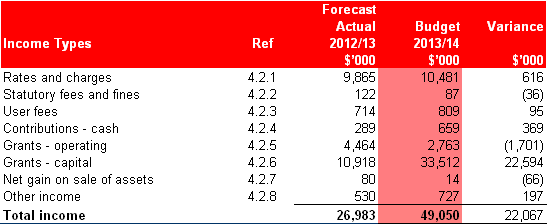
The chart below provides a graphic representation of the sources of revenue currently available to Council with a breakdown by revenue source.

4.2.1 Rates and charges ($0.61M increase)
It is proposed that general rate income be increased by 5% for Commercial and Residential properties over 2012/13.
The rate for farm properties is set to increase by 4% over the previous year with a reduction in the farm differential to 98% of the general rate.
The Municipal charge is to be increased from $100 to $150 per assessment.
The overall increase in rates and charges for 2013/14 is 6%. (Section 9. “Rating Information” includes a more detailed analysis of the rates and charges to be levied for 2013/14).
4.2.2 Statutory fees and fines ($0.036M decrease)
Statutory fees relate mainly to fees and fines levied in accordance with legislation and include animal registrations and Health Act registrations.
Increases in statutory fees are made in accordance with legislative requirements.
Statutory fees are forecast to decrease by 30% compared to 2012/13. This is due to an anticipated decrease in planning fees as domestic flood repairs wind down. Additionally, income from fire clearance fines and clearance works are expected to reduce following an increased public awareness..
A detailed listing of statutory fees is included in Appendix E.
4.2.3 User fees ($0.01M increase)
User charges relate mainly to the recovery of service delivery costs through the charging of fees to users of Council’s services. These include, use of leisure, entertainment and other community facilities and the provision of human services such home help services. In setting the budget, the key principle for determining the level of user charges has been to ensure that increases do not exceed CPI increases or market levels.
User charges are projected to increase by 11.7% or $0.1M over 2012/13. The main area contributing to the increase is Garbage Charges where the annual charge for the provision of garbage services has increased from $240 to $255. This is in line with Council’s long term view that garbage services should be provided on a full cost recovery basis.
A detailed listing of fees and charges is included in Appendix E.
4.2.4 Contributions - cash ($0.37M increase)
Contributions relate to monies paid by outside parties that assist in offsetting these expenses for Council.
Contributions are projected to increase by $0.4M or 56.3% compared to 2012/13 due mainly to the increase in community contributions for capital projects.
4.2.5 Grants - operating ($1.7M decrease)
Operating grants include all monies received from State and Federal sources for the purposes of funding the delivery of Council’s services to ratepayers. Overall, the level of operating grants has decreased by 38% or $1.7M compared to 2012/13. The main factor contributing to reduced funding levels is the Victorian Grants Commission.
The reduction in Victorian Grants Commission (VGC) funding, results from the prepayment of 50% of the Victorian Grants Commission funds in June 2013.
4.2.6 Grants - capital ($22.6M increase)
Capital grants include all monies received from State, Federal and community sources for the purposes of funding the capital works program. Overall the level of capital grants has increased by 67.4% or $22.6M compared to 2012/13 due mainly to substantial flood grants being received in 2013/14 that will were originally expected in 2012/13.
It is important to note that the majority of these grant funds will be expended on projects in the 2013/14 financial year.
Section 6. “Analysis of Capital Budget” includes a more detailed analysis of the grants and contributions expected to be received during the 2013/14 year.
4.2.7 Net gain on sale of assets ($0.07M decrease)
Net proceeds from the sale of Council assets are forecast to be $14k for 2013/14 and relate mainly to the planned cyclical replacement of part of the plant and vehicle fleet.
4.2.8 Other income ($0.2M increase)
Other income relates to a range of items such as private works, cost recoups and other miscellaneous income items. It also includes interest revenue on investments and rate arrears.
Other income is forecast to increase by 27.1% or $0.19M compared to 2012/13.
Interest on investments is forecast to increase by 317% or $0.34m compared to 2012/13. This is mainly due to a forecast increase in Council’s available cash reserves during 2013/14 due to a major capital fund injections in 2013/14 expected to be in excess of 28.5 million. Interest on unpaid rates is forecast to remain reasonably static as the amount of rates debtors outstanding remains relatively constant from year to year.
4.3 Expenses
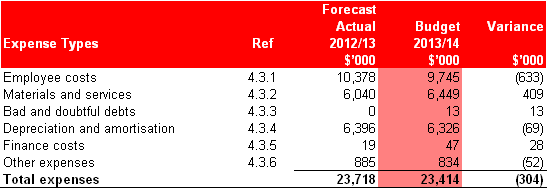
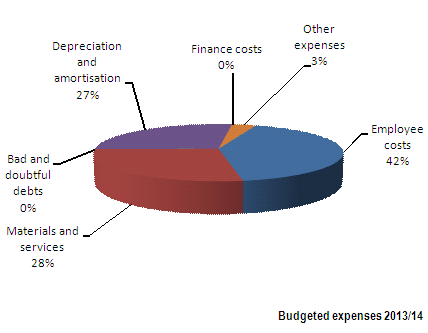
Source: Appendix A
4.3.1 Employee costs ($$0.63M decrease)
Employee costs include all labour related expenditure such as wages and salaries and on-costs such as allowances, leave entitlements, employer superannuation, rostered days off, etc.
Employee costs are forecast to decrease by 9.3% or $0.633M compared to 2012/13. This decrease relates to three key factors:
· Increases following renegotiation of Council’s Enterprise Bargaining Agreement (EBA) are not due until 2014/15. There is no increase applicable in 2013/14 being the last year of the existing agreement.
· Decreases in staff numbers resulting largely from Council’s decision to amalgamate some positions and not to replace some positions that become vacant by natural attrition.
· The transfer of Kindergarten services to an outside provider during the 2012/13 year.
In summary, average staff numbers (based on monthly averages) during the budget period are as follows:


4.3.2 Materials and services ($0.4M increase)
Materials and services include the purchases of consumables, payments to contractors for the provision of services and utility costs. Materials and services are forecast to increase by $0.4 M in comparison to 2012/13.
4.3.3 Bad and doubtful debts ($0.01M increase)
Bad and doubtful debts are projected to increase by $13k as the impact of the Fire Services Levy impacts on ratepayer’s capacity to pay.
4.3.4 Depreciation and amortisation ($0.69M decrease)
Depreciation is an accounting measure which attempts to allocate the value of an asset over its useful life for Council’s property, plant and equipment including infrastructure assets such as roads and drains. The decrease of $0.69 million for 2013/14 is due mainly to the reclassification of assets that now have a longer useful life than previously anticipated
4.3.5 Finance costs ($0.028M increase)
Borrowing costs relate to interest charged by financial institutions on funds borrowed. The increase in borrowing costs results from the planned borrowing of $1.55 million in 2012/13 to cover a substantial amount of the Defined Benefits superannuation call previously received.
4.3.6 Other expenses ($0.05M decrease)
Other expenses relate to a range of unclassified items including contributions to community groups, advertising, insurances, motor vehicle registrations and other miscellaneous expenditure items. Other expenses are forecast to decrease marginally as costs continue to be constrained.
4.4 Expenditure by Service Function
|
Operating Area |
2012/13 Forecast Actual ($000’s) |
2013/14 Budget ($000’s) |
Comments |
|
Governance |
|
||
|
Revenue |
18 |
0 |
No election in 2013/14 |
|
Expense |
(548) |
(448) |
No election in 2013/14 |
|
Net Service Cost |
(530) |
(448) |
|
|
Executive Manager |
|
||
|
Revenue |
2,946 |
1,556 |
50% of Grants Commission payment received in 2012/13 |
|
Expense |
(306) |
(289) |
|
|
Net Service Cost |
2,640 |
1,267 |
|
|
Planning |
|
||
|
Revenue |
26 |
36 |
|
|
Expense |
(147) |
(156) |
|
|
Net Service Cost |
(121) |
(120) |
|
|
Procurement |
|
||
|
Expense |
(337) |
(366) |
|
|
Net Service Cost |
(337) |
(366) |
|
|
Municipal Emergency Management |
|
||
|
Revenue |
60 |
60 |
|
|
Expense |
(6) |
(116) |
Employment cost |
|
Net Service Cost |
54 |
(56) |
|
|
Community Development |
|
||
|
Revenue |
10 |
15 |
|
|
Expense |
(163) |
(127) |
|
|
Net Service Cost |
(153) |
(112) |
|
|
Economic Development |
|
||
|
Revenue |
62 |
62 |
|
|
Expense |
(294) |
(311) |
Employment cost |
|
Net Service Cost |
(232) |
(249) |
|
|
Municipal Recovery |
|
||
|
Revenue |
113 |
0 |
|
|
Expense |
(265) |
0 |
|
|
Net Service Cost |
(152) |
0 |
|
|
Operating Area |
2012/13 Forecast Actual ($000’s) |
2013/14 Budget ($000’s) |
Comments |
|
Finance |
|
||
|
Revenue |
130 |
427 |
|
|
Expense |
(620) |
(570) |
Employment savings |
|
Net Service Cost |
(490) |
(143) |
|
|
Revenue Collection |
|
||
|
Revenue |
9,270 |
9,890 |
|
|
Expense |
(175) |
(159) |
|
|
Net Service Cost |
9,095 |
9,731 |
|
|
Corporate Services Administration |
|
||
|
Expense |
(502) |
(517) |
|
|
Net Service Cost |
(502) |
(517) |
|
|
Risk Management |
|
||
|
Expense |
(86) |
(104) |
|
|
Net Service Cost |
(86) |
(104) |
|
|
Records Management |
|
||
|
Expense |
(285) |
(248) |
Employment savings |
|
Net Service Cost |
(285) |
(248) |
|
|
Human Resources |
|
||
|
Revenue |
8 |
3 |
|
|
Expense |
(443) |
(459) |
|
|
Net Service Cost |
(435) |
(456) |
|
|
Information Technology |
|
||
|
Expense |
(644) |
(694) |
|
|
Net Service Cost |
(644) |
(694) |
|
|
Customer Service |
|
||
|
Revenue |
17 |
15 |
|
|
Expense |
(607) |
(645) |
|
|
Net Service Cost |
(590) |
(630) |
|
|
School Crossings |
|
||
|
Revenue |
12 |
13 |
|
|
Expense |
(39) |
(45) |
|
|
Net Service Cost |
(27) |
(32) |
|
|
Compliance |
|
||
|
Revenue |
133 |
115 |
|
|
Expense |
(322) |
(288) |
|
|
Net Service Cost |
(189) |
(173) |
|
|
Community Services Administration |
|
||
|
Revenue |
37 |
35 |
|
|
Expense |
(348) |
(336) |
|
|
Net Service Cost |
(311) |
(301) |
|
|
Operating Area |
2012/13 Forecast Actual ($000’s) |
2013/14 Budget ($000’s) |
Comments |
||||
|
Maternal & Child Health |
|
||||||
|
Revenue |
204 |
185 |
|
||||
|
Expense |
(281) |
(280) |
|
||||
|
Net Service Cost |
(77) |
(95) |
|
||||
|
Pre-Schools |
|
||||||
|
Revenue |
153 |
39 |
Transfer of employment to YMCA |
||||
|
Expense |
(229) |
(138) |
Transfer of employment to YMCA |
||||
|
Net Service Cost |
(76) |
(99) |
|
||||
|
HACC Services |
|
|
||||||
|
Revenue |
203 |
167 |
|
|
||||
|
Expense |
(365) |
(313) |
|
|
||||
|
Net Service Cost |
(162) |
(146) |
|
|
||||
|
Home and Community Care |
|
||||||
|
Revenue |
638 |
718 |
|
||||
|
Expense |
(807) |
(896) |
|
||||
|
Net Service Cost |
(169) |
(178) |
|
||||
|
Aged Services - Brokered Programs |
|
||||||
|
Revenue |
218 |
236 |
|
||||
|
Expense |
(216) |
(206) |
|
||||
|
Net Service Cost |
2 |
30 |
|
||||
|
Youth Programs |
|
||||||
|
Revenue |
96 |
75 |
Reduced community contribution |
||||
|
Expense |
(138) |
(140) |
|
||||
|
Net Service Cost |
(42) |
(65) |
|
||||
|
Library Services |
|
||||||
|
Revenue |
98 |
98 |
|
||||
|
Expense |
(247) |
(273) |
|
||||
|
Net Service Cost |
(149) |
(175) |
|
||||
|
Other Community Service Programs |
|
||||||
|
Revenue |
63 |
43 |
|
||||
|
Expense |
(61) |
(113) |
|
||||
|
Net Service Cost |
2 |
(70) |
|
||||
|
Assets & Infrastructure - Administration |
|
||||||
|
Revenue |
8 |
0 |
|
||||
|
Expense |
(700) |
(674) |
Employment savings |
||||
|
Net Service Cost |
(692) |
(674) |
|
||||
|
Operating Area |
2012/13 Forecast Actual ($000’s) |
2013/14 Budget ($000’s) |
Comments |
||||
|
Recreation Services |
|
||||||
|
Revenue |
2 |
0 |
|
||||
|
Expense |
(80) |
(84) |
|
||||
|
Net Service Cost |
(78) |
(84) |
|
||||
|
Public Health and Wellbeing |
|
||||||
|
Revenue |
31 |
30 |
|
||||
|
Expense |
(200) |
(204) |
|
||||
|
Net Service Cost |
(169) |
(174) |
|
||||
|
Building Regulations and Inspections |
|
||||||
|
Revenue |
91 |
65 |
|
||||
|
Expense |
(214) |
(223) |
|
||||
|
Net Service Cost |
(123) |
(158) |
|
||||
|
Property Maintenance |
|
||||||
|
Expense |
(252) |
(33) |
Employment savings |
||||
|
Net Service Cost |
(252) |
(33) |
|
||||
Built Assets (Halls, Community Buildings, etc.) |
|
|
||||||
|
Revenue |
66 |
62 |
|
|
||||
|
Expense |
(1,902) |
(1,937) |
|
|
||||
|
Net Service Cost |
(1,836) |
(1,875) |
|
|
||||
|
Other Council assets |
|
|
||||||
|
Expense |
(221) |
(375) |
|
|
||||
|
Net Service Cost |
(221) |
(375) |
|
|
||||
|
Assets & Infrastructure Projects |
|
|
||||||
|
Revenue |
50 |
50 |
|
|
||||
|
Expense |
(35) |
(45) |
|
|
||||
|
Net Service Cost |
15 |
5 |
|
|
||||
|
Works and Construction - Administration Support |
|
|
||||||
|
Expense |
(138) |
(100) |
|
|
||||
|
Net Service Cost |
(138) |
(100) |
|
|
||||
|
Community Support (Events etc.) |
|
|
||||||
|
Expense |
(26) |
(5) |
|
|
||||
|
Net Service Cost |
(26) |
(5) |
|
|
||||
|
Road Services |
|
|
||||||
|
Expense |
(7,584) |
(8,044) |
|
|
||||
|
Net Service Cost |
(7,584) |
(8,044) |
|
|
||||
|
Urban Areas and Environment |
|
|
||||||
|
Expense |
(565) |
(539) |
|
|
||||
|
Net Service Cost |
(565) |
(539) |
|
|
||||
|
Parks and Gardens |
|
|
||||||
|
Expense |
(774) |
(760) |
|
|
||||
|
Net Service Cost |
(774) |
(760) |
|
|
||||
|
Operating Area |
2012/13 Forecast Actual ($000’s) |
2013/14 Budget ($000’s) |
Comments |
|
||||
|
Urban Infrastructure |
|
|
||||||
|
Revenue |
1 |
0 |
|
|
||||
|
Expense |
(1,442) |
(1,507) |
|
|
||||
|
Net Service Cost |
(1,441) |
(1,507) |
|
|
||||
|
Waste and Environment |
|
|
||||||
|
Revenue |
935 |
978 |
|
|
||||
|
Expense |
(1,295) |
(1,245) |
|
|
||||
|
Net Service Cost |
(360) |
(267) |
|
|
||||
|
Aerodromes |
|
|
||||||
|
Expense |
(69) |
(84) |
|
|
||||
|
Net Service Cost |
(69) |
(84) |
|
|
||||
|
Saleyards Truck Wash |
|
|
||||||
|
Revenue |
77 |
95 |
|
|
||||
|
Expense |
(70) |
(71) |
|
|
||||
|
Net Service Cost |
7 |
24 |
|
|
||||
|
Labour Oncost |
|
|
||||||
|
Expense |
(118) |
395 |
|
|
||||
|
Net Service Cost |
(118) |
395 |
|
|
||||
Asset Disposal |
|
|
||||||
|
Revenue |
80 |
0 |
|
|
||||
|
Net Service Cost |
80 |
0 |
|
|
||||
|
Sundry Debtor External Works |
|
|
||||||
|
Revenue |
84 |
35 |
|
|
||||
|
Expense |
(59) |
(38) |
|
|
||||
|
Net Service Cost |
25 |
(3) |
|
|
||||
|
Fleet Expenses and Recovery |
|
|
||||||
|
Revenue |
8 |
12 |
|
|
||||
|
Expense |
89 |
47 |
|
|
||||
|
Net Service Cost |
97 |
59 |
|
|
||||
|
Plant Expenses and Recovery |
|
|
||||||
|
Revenue |
0 |
14 |
|
|
||||
|
Expense |
418 |
406 |
|
|
||||
|
Net Service Cost |
418 |
420 |
|
|
||||
|
Capital Grants and Contributions |
|
|
||||||
|
Revenue |
11,034 |
33,982 |
|
|
||||
|
Expense (Flood Reconstruction) |
0 |
(3) |
|
|
||||
|
Net Service Cost |
11,034 |
33,979 |
|
|
||||
5.0 Analysis of Budgeted Cash Position
This section analyses the expected cash flows from the operating, investing and financing activities of Council for the 2013/14 year. Budgeting cash flows for Council is a key factor in setting the level of rates and providing a guide to the level of capital expenditure that can be sustained with or without using existing cash reserves.
The analysis is based on three main categories of cash flows:
· Operating activities - Refers to the cash generated or used in the normal service delivery functions of Council. Cash remaining after paying for the provision of services to the community may be available for investment in capital works, or repayment of debt
· Investing activities - Refers to cash generated or used in the enhancement or creation of infrastructure and other assets. These activities also include the acquisition and sale of other assets such as vehicles, property and equipment
· Financing activities - Refers to cash generated or used in the financing of Council functions and include borrowings from financial institutions and advancing of repayable loans to other organisations. These activities also include repayment of the principal component of loan repayments for the year.
5.1 Budgeted cash flow statement

Source: Appendix A
5.1.1 Operating activities 24.1M increase)
The increase in cash inflows from operating activities is due mainly to a $22.6M increase in capital grants to fund the C6 and C12 capital works program (flood repair). These funds were anticipated to be received in the previous financial year but were deferred until 2013/14.
A $0.4M increase in rates and charges, which is in line with the rates and charges increases mentioned previously.
The net cash flows from operating activities does not equal the surplus (deficit) for the year as the expected revenues and expenses of the Council include non-cash items which have been excluded from the Cash Flow Statement. The budgeted operating result is reconciled to budgeted cash flows available from operating activities as set out in the following table.

5.1.2 investing activities ($27.7M increase)
The large increase in payments for investing activities represents the planned large increase in capital works expenditure disclosed in section 10 of this budget report.
5.1.3 Financing activities ($1.8M increase)
For 2013/14 the total of principal repayments is $0.565M and finance charges is $0.05M. Change also due to additional borrowings being budgeted in 2013/14 to pay out defined benefits superannuation call,
5.1.4 Cash and cash equivalents at end of the year ($2.2M decrease)
Overall, total cash and investments are forecast to decrease by $2.2M to ($0.63)M as at 30 June 2014. This is substantially due to the payment for the ongoing works associated with the C6 and C12 flood road works contracts.
This is consistent with Council’s 10 Year Financial Plan (see Section 8), which forecasts a significant reduction in the capital works program from 2013/14 onwards to balance future cash budgets.
5.2 Restricted and unrestricted cash and investments
Cash and cash equivalents held by Council are restricted in part, and not fully available for Council’s operations. The budgeted cash flow statement above indicates that Council is estimating at 30 June 2013 it will have cash and investments of $0.63 million cash deficit.,
5.2.1 Statutory reserves ($00M)
These funds must be applied for specified statutory purposes in accordance with various legislative requirements. While these funds earn interest revenues for Council, the funds are not available for other purposes.
During the 2013/14 Council had no funds in statutory Reserves.
5.2.2 Discretionary reserves ($0.0M)
These funds are available for whatever purpose Council decides is their best use. In this case Council has made decisions regarding the future use of these funds and unless there is a Council resolution these funds should be used for those earmarked purposes.
5.2.3 Unrestricted cash and investments ($0.0M)
These funds are free of all specific Council commitments and represent funds available to meet daily cash flow requirements, unexpected short term needs and any budget commitments which will be expended in the following year such as grants, contributions or carried forward capital works. Council is expected to be in an overdraft situation at 30 June 2013. As a result there are no funds available that can be restricted.
6.0 Analysis of Capital Budget
This section analyses the planned capital expenditure budget for the 2013/14 year and the sources of funding for the capital budget.
6.1 Capital works

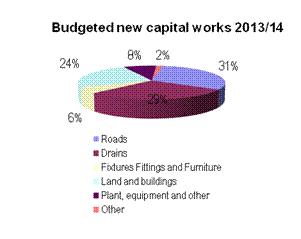

Source: Appendix A. A more detailed listing of the capital works program is included in Appendix C.
6.1.1 Carried forward works ($31.35M)
At the end of each financial year there are projects which are either incomplete or not commenced due to factors including planning issues, weather delays and extended consultation. For the 2012/13 year it is forecast that $31.35M of capital works will be incomplete and be carried forward into the 2013/14 year. The most significant projects are the road works associated with flood rectification. These works total $28.45M. Additionally, $1.5M will be spent on the Donald Family Services Centre. With further expenditure for completion of this project budgeted for the following year.
6.1.2 Roads ($1.9M)
Roads include local roads, car parks, footpaths, bike paths, bridges and culverts, declared main roads, traffic devices, street lighting and traffic signals.
For the 2013/14 year, $1.92M will be expended on road projects. The more significant projects include local road reconstruction. The federally funded Roads to Recovery projects have been completed for the current cycle thus reducing the amount spend on normal road works. However this is more than offset by the amount of works to be undertaken in the flood road rectification as discussed in the carried forward capital.
6.1.3 Drains ($1.8M)
Drains include drains in road reserves, retarding basins and waterways.
For the 2013/14 year, $1.8M will be expended on drainage projects. Councils drainage plans are currently being reviewed and major drainage works and potential flood mitigation works are being evaluated for capital expenditure in future years.
6.1.4 Fixtures, furniture and fittings ($0.36M)
Fixtures furniture and fittings are items incorporated into council buildings and the furniture contained therein. This also incorporates expenditure on communications and information technology both hardware and software.
For the 2013/14 year, $0.36M will be expended on these assets mainly to replace existing assets that have reached the end of their useful lives.
6.1.5 Land Buildings ($1.4M)
Land and buildings include community facilities, municipal offices, sports facilities and pavilions.
For the 2013/14 year, $1.44M will be expended on building projects. The more significant projects include the commencement of construction of the Donald Family Services Centre ($2.85M),Swimming pool facility upgrades ($0.69M) The Berriwillock Multi – Purpose Centre ($0.3M),Charlton Travellers Rest ($0.20M) and Charlton Skate Park ($0.15M).
6.1.6 Plant, equipment and other ($0.51M)
Plant, equipment and other includes motor vehicles and plant.
For the 2013/14 year, $0.51M will be expended on plant, equipment and other projects. This includes $0.33M for the replacement of heavy plant and $0.15M for the replacement of light fleet.
6.1.7 Other ($0.1M)
For the 2013/14 year, $0.1M will be expended on other capital items. This includes $0.07M in gravel pit restoration.
6.1.8 Asset renewal ($33.7M), new assets ($3.1M), and expansion/upgrade ($0.75M)
A distinction is made between expenditure on new assets, expenditure on asset renewal and expansion/upgrade. Expenditure on asset renewal is expenditure on an existing asset, which improves the service potential or the life of the asset. Expenditure on new assets does not have any element of expansion/upgrade of existing assets but will result in an additional burden for future operation, maintenance and capital renewal.
The major projects included in the above categories, which constitute expenditure on new assets, are the road works including flood rectification works $33.7 million and new asset of $3.04 million which relate to new assets such as the Berriwillock Multi Purpose Centre and the Donald Family Services Centre.
6.2 Funding sources


Source: Appendix A
6.2.1 Carried forward works ($35.4M)
At the end of each financial year there are projects which are either incomplete or not commenced due to factors including planning issues, weather delays and extended consultation. For the 2012/13 year it is forecast that $35.3M of capital works will be incomplete and be carried forward into the 2013/14 year. Significant funding includes grants for the flood recovery road rectification of $28.5Mmillion and $1.0M for the Donald family services Centre.
6.2.2 Grants - Capital ($2.18M)
Capital grants and contributions include all monies received from State, Federal and community sources for the purposes of funding the capital works program.
Significant grants and contributions are budgeted to be received for Country Roads and Bridges ($1.00M), Local Government Infrastructure program ($0.46M), and $1.1M for the Donald and Charlton flood studies.
An additional $1.05M is expected to be received from the Victorian Grants Commission to fund capital works.
6.2.3 Proceeds from sale of assets ($0.002M)
Proceeds from sale of assets include motor vehicle sales in accordance with Council’s fleet renewal policy of $0.02M.
6.2.4 Operations ($0.0M)
Council has budgeted for an operating deficit. As a result, there are no funds available to fund capital works from this source.
6.2.5 Reserve cash and investments ($0.0M)
Council does not have has significant cash reserves and investments to fund capital works, The majority of works are funded from grant monies to be received in 2013/14.
6.2.6 Unrestricted cash and investments ($0.0M)
Council does not have any uncommitted cash and investments from which to fund capital works.
Buloke Shire Council Special Meeting Thursday, 25 July 2013
5.1.1 Proposed Budget For The Municipal Year Ending 30 June 2014
Attachment 1 Proposed Budget Year Ending 30 June 2014
7.0 Analysis of Budgeted Financial Position
This section analyses the movements in assets, liabilities and equity between 2012/13 and 2013/14. It also considers a number of key performance indicators.
7.1 Budgeted balance sheet
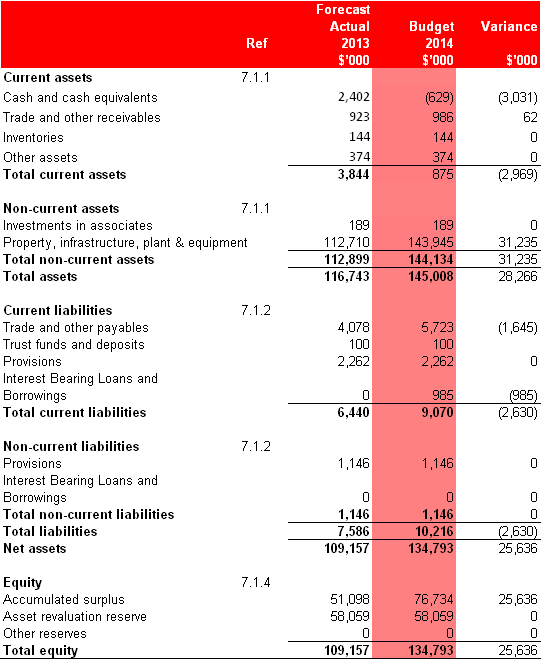
Source: Appendix A
7.1.1 Current Assets ($3.0M decrease) and Non-Current Assets ($28.3M increase)
Cash and cash equivalents include cash and investments such as cash held in the bank and the value of investments in deposits or other highly liquid investments with short term maturities of three months or less. These balances are projected to decrease by $2.9M during the year mainly to fund the capital works program as outlined in Section 5.
Trade and other receivables are monies owed to Council by ratepayers and others. Short term debtors are not expected to change significantly in the budget.
Other assets includes items such as prepayments for expenses that Council has paid in advance of service delivery, inventories or stocks held for sale or consumption in Council’s services and other revenues due to be received in the next 12 months. These items are currently budgeted to remain at the same levels as the current year.
Property, infrastructure, plant and equipment is the largest component of Council’s worth and represents the value of all the land, buildings, roads, vehicles, equipment, etc which has been built up by Council over many years. The increase in this balance is attributable to the net result of the capital works program ($37.47 million) of new assets), depreciation of assets ($6.3 million) and the sale through sale of property, plant and equipment ($0.024M).
7.1.2 Current Liabilities ($2.6M increase) and Non-Current Liabilities no change.
Trade and other payables are those to whom Council owes money as at 30 June. These liabilities are budgeted to increase by $1.6M due to payments due to contractors working on the major flood rectification contract.
Provisions include accrued long service leave, annual leave and rostered days off owing to employees. These employee entitlements are only expected to remain at the same levels as they are in the current year.
Interest-bearing loans and borrowings are borrowings of Council. Council is budgeting to have $0.985M outstanding at the end of the year being the remaining liability for the Vision Super defined benefits call.
7.1.3 Working Capital ($5.6M decrease)
Working capital is the excess of current assets above current liabilities. This calculation recognises that although Council has current assets, some of those assets are already committed to the future settlement of liabilities in the following 12 months, and are therefore not available for discretionary spending.
The level of working capital has reduced due to large levels of capital expenditure as discussed earlier.
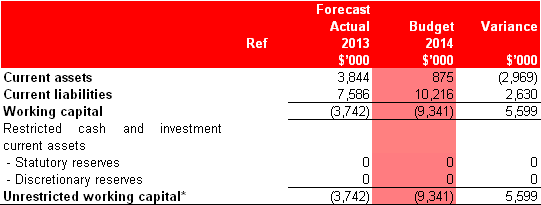
7.1.4 Equity ($25.6M increase)
Total equity always equals net assets and is made up of the following components:
· Asset revaluation reserve which represents the difference between the previously recorded value of assets and their current valuations
· Other reserves that are funds that Council wishes to separately identify as being set aside to meet a specific purpose in the future and to which there is no existing liability. These amounts are transferred from the Accumulated Surplus of the Council to be separately disclosed
· Accumulated surplus which is the value of all net assets less Reserves that have accumulated over time. The increase in accumulated surplus of $1.05M results directly from the surplus for the year.
7.2 Key assumptions
In preparing the Budgeted Balance Sheet for the year ending 30 June 2014 it was necessary to make a number of assumptions about assets, liabilities and equity balances. The key assumptions are as follows:
· A total of 95.4% of total rates and charges raised will be collected in the 2013/14 year. This is in line with the 2012/13 forecast outstanding rate debtor balance.
· Trade creditors to be based on total capital and operating expenditure less written down value of assets sold, depreciation and employee costs. Payment cycle is 30 days
· Other debtors and creditors to remain consistent with 2012/13 levels
· Repayment of loan principal to be $0.5M
· Total capital expenditure to be $37.57M
· The council will repay its share of the unfunded superannuation liability over a period of three years.
Buloke Shire Council Special Meeting Thursday, 25 July 2013
5.1.1 Proposed Budget For The Municipal Year Ending 30 June 2014
Attachment 1 Proposed Budget Year Ending 30 June 2014
8.0 10 Year Financial Plan (Strategic Resource Plan) and Key Financial Indicators
This section includes an extract of the adopted 10 year financial plan to provide information on the long term financial projections of the Council.
8.1 Plan development
The Act requires a forward financial plan to be prepared covering both financial and non-financial resources, and including key financial indicators for at least the next four financial years to support the Council Plan.
Council has prepared a 10 year financial plan for the period 2013/14 to 2022/23 as part of its ongoing financial planning to assist in adopting a budget within a longer term framework.
The plan takes the strategic objectives and strategies as specified in the Council Plan and expresses them in financial terms for the next ten years.
The key objective, which underlines the development of the plan, is financial sustainability in the medium to long term, while still achieving Council’s strategic objectives as specified in the Council Plan.
The financial plan for 2013 – 2023 is based on the following key strategies aimed at ensuring the long-term viability and amenity of the Shire:
• Rate increases over the period of the Financial Plan of 6.0% per annum.
• Total average annual increase in revenue from fees, fines and charges of 2.5% p.a.(CPI) in 2013/14 and continuing at this level the remainder of the plan or in line with cost increases or market levels as appropriate. This also recognises that other levels of Government set a considerable portion of statutory fees, fines and charges.
• An increase in Financial Assistance Grants in line with the Consumer Price Index (CPI) over the life of the Plan.
• The maintenance or enhancement of existing service levels and increased maintenance and asset management of Council facilities and infrastructure.
• The funding of both operating expenditure and base capital works – that is the maintenance of absolute and relative infrastructure standards – from recurrent revenue sources and capital subsidies and cash reserves.
• An asset sales program over the life of the Plan of approximately $1.5M to offset the cost of replacement plant and equipment.
• Maintenance of a level of cash investment to meet non-discretionary funding commitments.
• A base capital works program averaging approximately $4.5M per annum over the life of the plan.
A program of rolling capital works over the four years including
· upgrades of swimming pools
• renewals of playgrounds
• improvements to community halls
• improvements to township drainage
• ground improvements to principal recreation reserves
• upgrades to public amenities.
In preparing the plan, Council has also been mindful of the need to comply with the following Principles of Sound Financial Management as contained in the Act:
· Prudently manage financial risks relating to debt, assets and liabilities
· Provide reasonable stability in the level of rate burden
· Consider the financial effects of Council decisions on future generations
· Provide full, accurate and timely disclosure of financial information.
The plan will be updated annually through a rigorous process of consultation with Council service providers followed by a detailed sensitivity analysis to achieve the key financial objectives.
8.2 Financial resources
The following table summarises the key financial results for the next four years as set out in the plan for years 2013/14 to 2016/17. Appendix A includes a more detailed analysis of the financial resources to be used over the four year period.

Key to Forecast Trend:
+ Forecasts improvement in Council's financial performance/financial position indicator
o Forecasts that Council's financial performance/financial position indicator will be steady
- Forecasts deterioration in Council's financial performance/financial position indicator
The following graph shows the general financial indicators over the four year period.
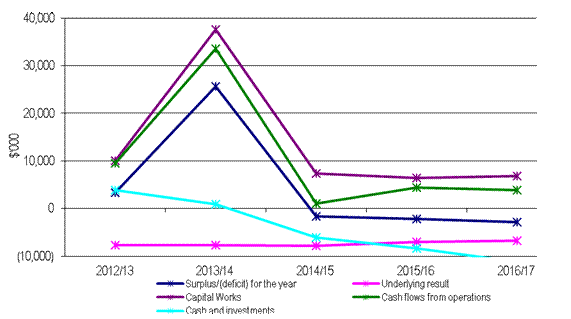
The key outcomes of the SRP are as follows:
· Financial sustainability (section 5) - Cash and investments is forecast to decrease as current cash reserves are channelled into paying for the large capital works program particularly in 2013/14. Cash reserves will decrease from ($0.6M) deficit in 2013/14 to ($12.9M) at the end of the four year plan.
· Rating levels (section 9) – Rate increases are forecast over the four years at an average of 6.0%, this is in line with that expected of comparable councils
· Service delivery strategy (section 10) – Service levels have been marginally reduced over the four year period. Operating surpluses are not projected during the life of the plan. The underlying result is a measure of financial sustainability and is an important measure as once-off items can often mask the operating result .The underlying result is showing progressive improvement throughout the life of the plan,
· Borrowing strategy (section 10) – Borrowings are forecast to reduce from $1.55M to no borrowings over the four year period. This includes borrowings of $1.55M in 2013/14 that were taken out specifically to payout the Defined Benefits Superannuation Liability following the last Vision super call.
· Infrastructure
strategy (section 10) - Capital expenditure over the four year period will
total $58.0M at an average of $14.5M. (This average is affected by the impact
of flood repair capital works in excess of $28M in 2013/14)
Buloke Shire Council Special Meeting Thursday, 25 July 2013
5.1.1 Proposed Budget For The Municipal Year Ending 30 June 2014
Attachment 1 Proposed Budget Year Ending 30 June 2014
8.3 Key financial indicators
The following table highlights Council’s current and projected performance across a range of key financial indicators (KFIs) for the 10 years of the plan. KFIs provide a useful analysis of Council’s financial position and performance and should be used in the context of the organisation’s objectives.
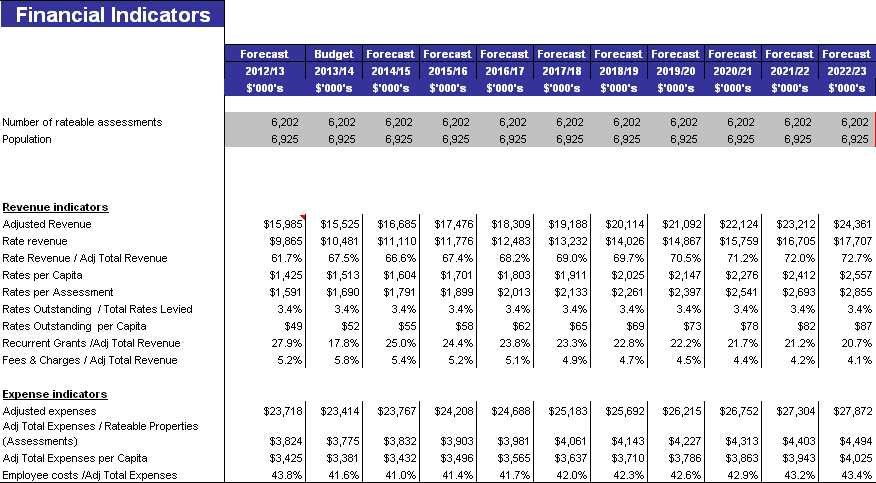
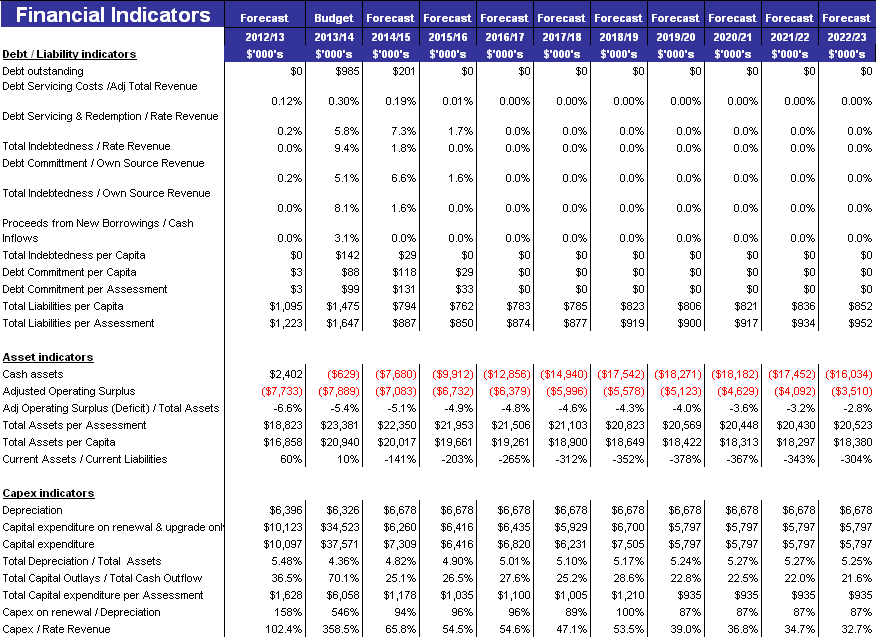

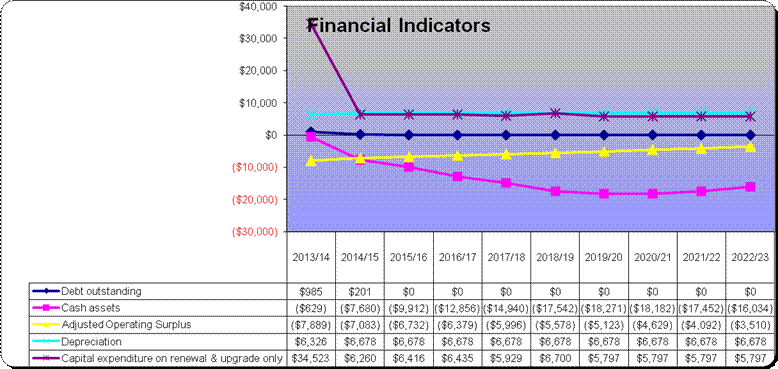
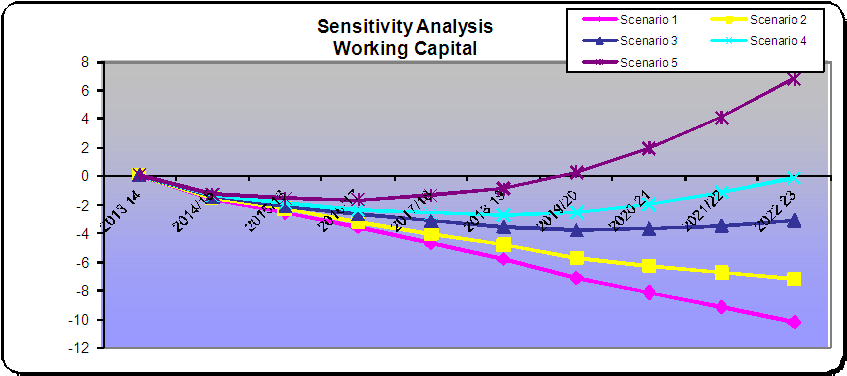
The sensitivity analysis discussed earlier has been reproduced to highlight Council’s difficulties in maintaining suitable working capital levels. Scenario 3 is the line that reflects the forecasts made in this budget.
Notes to indicators
1 Underlying result - Improvement in financial performance expected over the period, although continued losses means reliance on Council's cash reserves or increased debt to maintain services.
2 Rate revenue/Underlying revenue - Reflects extent of reliance on rate revenues to fund all of Council's on-going services. Trend indicates Council will become more reliant on rate revenue compared to all other revenue sources.
3 Indebtedness/Rate revenue - Trend indicates Council's reducing reliance on debt against its annual rate revenue through redemption of long term debt.
4 Current Assets/Current Liabilities – Working capital is forecast to decrease significantly in 2013/14 year due to a run down in cash reserves to fund the capital program. .
5 Cash Op Act/Net Capital outlays - Except for the 2013/14 year budget trend indicates Council expects to be able to service its capital works expenses from cash generated from operating activities, rather than relying on its existing cash reserves or further borrowings.
6 Asset renewal/Total depreciation - This percentage indicates the extent of Council's renewals against its depreciation charge (an indication of the decline in value of its existing capital assets). A percentage greater than 100 indicates Council is maintaining its existing assets, while a percentage less than 100 means its assets are deteriorating faster than they are being renewed and future capital expenditure will be required to renew assets.
8.4 Non-financial resources
In addition to the financial resources to be consumed over the planning period, Council will also consume non-financial resources, in particular human resources. The following table summarises the non-financial resources for the next four years.


Buloke Shire Council Special Meeting Thursday, 25 July 2013
5.1.1 Proposed Budget For The Municipal Year Ending 30 June 2014
Attachment 1 Proposed Budget Year Ending 30 June 2014
9.0 Rating Information
9.1 Rating context
In developing the 10 year financial plan rates and charges were identified as the primary source of revenue for Council, accounting for 67.5% of the adjusted total revenue (after excluding capital grants) received by Council annually.
Maintaining a growth in revenue from rates and charges is therefore vitally important to Council’s future financial sustainability. However, it is also necessary to balance the importance of rate revenue as a funding source with community sensitivity to continuing increase, particularly as they relate to changes in property values and the potential this has to impact on some sections of the community more than others.
Benchmarking of rate levels in Buloke with other small rural Councils confirms that on both a rates per capita, and rates per assessment basis, are higher than the average for this group of Councils. However closer analysis against directly comparable small rural councils (councils with an economy based on broad acre agriculture) shows that rate levels in Buloke are less than the average for this smaller group for both of these measures. This is no justification for an increase in rates but it does identify that affordability, at least in comparable terms with other communities, is perhaps not as challenging as some would suggest. However, benchmarking of rates per assessment as a % of average weekly household income, against the same group of councils, does identify that rates constitute a higher % of expenditure in Buloke compared to other municipalities. What these benchmarking activities highlight is the continuing need for Council to balance its need for revenue against the capacity of the community to pay.
To ensure that deliberations about future rate increases are made on an informed basis benchmarking exercises will continue to be undertaken and a number of key indicators, including rates per assessment as a % of average weekly household income, considered as part of decision making activities.
9.2 Current year rate increase
As identified in other sections of this budget document Council’s 2013/14 operating position will be significantly impacted by increase in the cost of materials and services, wages growth and likely ongoing constraints in available government funding.
Revenue growth is essential to Council continuing to operate and continuing to provide the current range of services.
Modelling undertaken as part of the development of the 10 year financial plan suggest that successive rate increase in excess of 15% are required in order for Council to reach its strategic target of a breakeven operating position. This scenario has been rejected by Council in favour of smaller and more manageable increases in revenue over the next three years accompanied by a significant reduction in operating costs and reductions in capital expenditure.
As stated earlier it is Council intent to reach a break even position (based on the definition of surplus set as part of the rates policy statement0 by the end of the 2015/16 financial year. In the current context this is a ‘stretch target’ and will require significant discipline in decision making over the next three years to achieve.
9.3 Rating Structure
Based on the analysis and discussion that has taken place around current and future rating needs Council has adopted the following Rating Strategy for 2013/14:
1. The 2012 Revaluation will be used for rating purposes in 2012/13.
2. The basis of valuation will continue to be the Capital Improved Value (CIV).
3. An increase in revenue from rates and charges in 2013/14 of 6%. (Total rates and charges incorporate General Rates, Municipal Charge and Waste Service Charges.)
4. The Municipal Charge to be retained and applied to every rateable property in the Shire. However, a single farm enterprise which may be conducted on several properties can apply for an exemption which will mean that they will only be charged one Municipal Charge for that enterprise.
5. The amount of rate revenue collected through the Municipal Charge to increase to represent 7.5% of the total revenue raised through General Rates and Service Charges.
6. The Commercial/Industrial Rate to be set at 100% of the General Rate.
7. The Farm Rate to be set at 98% of the General Rate (A Farm rate differential of 2%).
8. The current kerbside waste and recyclable services will be retained and set at a level to recover 100% of the costs incurred by Council to provide the service and operate land fill and transfer stations across the Shire, including Government levies.
9. The charge for a waste and recyclable service will apply equally to all occupied residential properties where the service is rendered, or is available, whether or not the service is used.
10. A pensioner concession for eligible concession card holders will provide a 50% discount off Council rates up to the maximum amount set by the Victorian Government.
11. The council will allow rates and charges to be paid either in full, by instalments, or by direct debit in nine equal monthly payments commencing in August 2013 and concluding in May 2014. The date for instalments and payment in full will be on the dates fixed by the Minister for Local Government by notice published in the Government Gazette.
9.4 Impact Assessment.
The table below shows the impact of these recommendations on rate bills. The figures are estimates based on current valuations and assumes no movement in assessment numbers between rate categories
. A more detailed analysis of the rates to be raised is contained in Appendix B ‘Statutory Disclosures
’
|
|
2012/13 |
2013/14 |
% Increase – Total Rates Bill (2012/13 – 2013/14) |
||
|
|
Amount (Ave. Per Ass. for each rate type) |
Total Ave. Rates Bill/Ass. |
Amount (Ave. Per Ass. for each rate type) |
Total Ave. Rates Bill Per Ass. |
|
|
General rate (Residential) |
$712.95 |
$1,052.95 |
$757.52 |
$1,124.12 |
+6.76% |
|
General Rate (Commercial/Industrial) |
$1,126.18 |
$1,226.18 |
$1,164.62 |
$1,291.37 |
+5.32% |
|
Farm Rate |
$2,092.83 |
$2,192.83 |
$2163.35 |
$2,290.10 |
+4.43% |
|
Municipal Charge |
$100.00 |
|
$126.75 |
|
+127% |
|
Service Charge |
$240.00 |
|
$240.00 |
|
0% |
|
Total Raised by Rates and Charges |
$9,888,438 |
|
$10,481,744 |
|
+5.99%. |
Council has adopted a Rating Strategy that contains expanded information on Council's rating structure and the reasons behind its choices in applying the rating mechanisms it has used.
9.5 Beyond 2013/14
Beyond 2013/14 Council will need to re-consider the proposals discussed above and consider any other changes of circumstance that may occur.
Long term options to be investigated in the next 10 years include:
· The potential to maintain a differential for farm rates
· Re-evaluate the need for commercial and industrial rate differentials
· Analyse each of the rate differentials to determine:
· Ability to pay
· Equity
· Impact of any potential changes
The Council, in consultation with the community, test these principles to guide the direction and actions pertaining to future revenue-raising (discussing the various approaches and methods in the application of differential rates, subsidies or deferrals where possible.
· Develop a communication and marketing plan to better explain Council’s rating objectives:
Design inclusive consultation and information gathering approaches with the community to ensure community needs and concerns are canvassed.
9.6 Rates Administration
9.6.1 Rate payment dates
Rates are a charge on the property and the Council will allow them to be paid in one of the following ways:
• BY LUMP SUM WITH A DISCOUNT FOR EARLY PAYMENT
Lump sum payments in full made on or before 28 September 2013 which will entitle ratepayers to receive a discount of 1.5% on the total rates and charges raised for the 2013/14 rating year; or
• BY LUMP SUM WITH NO DISCOUNT
Lump sum payments (excludes discounted early payments) made on or before 15 February 2014 (i.e. the date fixed by the Minister by notice published in the Government Gazette); or
• BY FOUR INSTALMENTS
Payments must be made on or before the following dates fixed by the Minister by notice published in the Government Gazette:
1st Instalment – due by 30 September 2013
2nd Instalment – due by 30 November 2013
3rd Instalment – due by 28 February 2014
4th Instalment – due by 31 May 2014
To be eligible to pay by four instalments, the amount of the first instalment must be paid by 30 September 2013. Payments made after that date will not be eligible for the instalment plan and will be treated as a part payment only, with the balance to be paid in full by 15 February 2014. The first instalment is an amount as near as possible to 1/4 of the current rates and charges plus any arrears carried over from previous rating years; or
· BY NINE INSTALMENTS
Payments must be by direct debit and paid by the 28th day of the months of September 2013, October 2013, November 2013, December 2013, January 2014, February 2014, March 2014, April 2014 and May 2014. The first instalment is an amount as near as possible to 1/9 of the current rates and charges plus any arrears carried over from previous rating years.
9.6.2 Payment difficulties
Ratepayers who are experiencing difficulties in paying their rates should contact Council’s Rates Officer to discuss an alternative payment arrangement.
All such enquiries are treated confidentially and will help prevent costly legal action for recovery of overdue rates from commencing.
Interest will still be charged on overdue rates and charges not paid by their respective due dates.
9.6.3 Interest on late payments
In accordance with s172 of the Act Council will charge interest on late payments which have not been paid by the required lump sum payment date or instalment dates.
The penalty interest for 2013/14 will be calculated at the interest rate fixed by the
Attorney General on 1 July 2013.
In the case of ratepayers who choose to make a lump sum annual payment and fail to clear their account in full on or before the due date of 15 February 2014, interest will be calculated on the balance remaining after the due date until the account is paid in full.
Under the legislation, interest in this instance is charged from the date that the first instalment falls due until the account is cleared. This means that ratepayers who choose to pay in full and do not pay will be charged interest at the prescribed rate from 28 September 2013.until the day on which they are paid.
In the case of ratepayers who choose to make payments by four instalments or by nine instalments and fail to clear their instalment accounts on or before the relevant due dates, interest will be calculated on the balance remaining after the due date until the account is paid in full. Under the Act, interest is charged from the date that the instalment was due until the account is cleared.
9.6.4 Pensioner rate concessions
A pensioner concession for eligible concession card holders will provide a 50% discount off council rates up to the maximum amount set by the Victorian Government.
For 2012/13 the maximum amount was $193.40.
The Department of Human Services (DHS) has not yet advised the maximum cap for 2013/14.
To be eligible for a pensioner concession, pensioners must hold at least one of the following concession cards:
• Pensioner Concession Card
• Gold Card issued by the Department of Veteran Affairs (DVA)
• DVA Gold War Widow (WW)
• DVA Gold Totally/Permanently Incapacitated Veteran (TPI)
The concession is only available for a pensioner’s principal place of residence which is
listed on their concession card. Health Care cardholders are not eligible to a concession on Council rates and charges.
9.7 General revaluation of properties
The Council is required to revalue all properties within the municipality every two years.
A revaluation of all properties was completed at 1 July 2012 for use in both the 2012/13 and 2013/14 rating years.
A revaluation is conducted by qualified valuers and updates the rating valuation of all properties in the municipality to a more current level of value date, in order that rates levied are more closely based on prevailing market conditions. Therefore undertaking a general revaluation on a regular basis is fundamental requirement for the maintenance of rating equity.
All properties in the municipality – and across Victoria – have been valued as at the common date of 1 January 2012 in the recent revaluation.
9.8 Fire Services Property Levy
The Victorian Fire Services Property Levy will be included on Buloke rate notices in 2013/14.
It is a State Government requirement for all municipalities in Victoria to collect the levy that will be used to fund our important and essential fire services.
The new rules are in line with the findings of the 2009 Bushfire Royal Commission, which recommended that the previous insurance based fire services levy be replaced with a property-based levy.
This means that all property owners must contribute to the fire services funding, not just those with insurance.
The levy is made up of two components, a fixed charge component, plus a levy rate calculated against the Capital Improved value of the property.
In 2013/14, the fixed charge component will be $100 for residential properties and vacant land and $200 for commercial, industrial, primary production (farms), public benefit and vacant land.
The levy rate, in addition to the fixed charge, will be set by the State Government annually by May 31, having regard to the annual funding requirements for both the MFB and CFA>
Eligible pensioners will receive a $50 concession on the levy.
The levy charge will be included as a separate line item on rate notices when they are sent out later this year.
Sample Fire Service levy amounts for the 2013/14 year – CFA District
|
FSL Category |
Average Capital Improved Value (CIV) |
Amount calculated against CIV |
Fixed Charge |
Total Due |
|
Residential |
$200,000 |
$23.00 |
$100 |
$123.00 |
|
Commercial |
$200,000 |
$218.40 |
$200 |
$418.40 |
|
Industrial |
$200,000 |
$341.80 |
$200 |
$541.80 |
|
Primary Production (Farm) |
$350,000 |
$109.20 |
$200 |
$309.20 |
10.0 Other Strategies
10.1 Borrowings
In developing the 10 year financial plan no borrowing s have been projected beyond those required to reduce Council’s liability for the 2012 defined benefits superannuation call.
A loan of $1.55M has been budgeted for 2013/14 to pay out the remaining amount of the liability. The liability was reduced by $0.749M in 2012/13.
The current loan will be totally repaid by the end of 2015/16.
10.2 Infrastructure
The Council has developed an Infrastructure Strategy based on information derived from the Council Plan, Community Plans and various Asset Management Plans.
The purpose of the Strategy is to quantify the capital expenditure requirements of Council for the next 10 years by class of asset, and is a key input to the 10 year financial plan.
The strategy predicts infrastructure consumption, renewal needs and infrastructure needs to meet future community expectations.
The Strategy has been developed through a process of internal consultation and evaluation.
A key objective of the Infrastructure Strategy is to quantify the level of funds required to maintain and/or renew Council’s existing assets at desired condition levels.
If sufficient funds are not allocated to asset renewal requirements then Council’s investment value in those assets will reduce, along with the capacity to deliver services to the community.
The Strategy identifies that the funds required to meet infrastructure renewal are currently greater than the funds available for the purpose.
This is not a situation unique to Buloke. Many small rural municipalities with extensive local road networks and a large number of predominantly ageing halls, swimming pools and other community assets face similar challenges.
The following influences are seen to be factors leading to this situation:
· Reduction in the amount of cash and investment reserves to fund future capital expenditure programs
· A lack of certainty around continuing Federal and State government funding for upgrade of roads
· The impact of new transport and agricultural technology on roads and road related infrastructure (heavier axle weights, longer vehicles and wider vehicles)
· Changes to building and other regulations that require continuing investment in ageing infrastructure to meet contemporary standards (essential services, accessibility, food safety, early childhood education, child care, etc.)
· Continued community demand for new facilities even when existing facilities are already available
· Community expectations that ‘historic’ building and facilities are maintained even when new facilities are constructed
· Community expectations arising from the impacts of climate change and changing weather patterns (drought, floods, higher summer temperatures)
The following table summarises Council's forward outlook on capital expenditure including funding sources for the next four years.
|
Year |
Total Capital Program |
Grants and Contrib's |
Borrowings |
Investment Reserves |
Unrestricted Cash & Inv |
Council Operations |
|
|
$’000 |
$’000 |
$’000 |
$’000 |
$’000 |
$’000 |
|
2012/13 |
10,097 |
9,786 |
0 |
0 |
0 |
(311) |
|
2013/14 |
37,571 |
32,957 |
0 |
0 |
0 |
(4,614) |
|
2014/15 |
7,309 |
4,218 |
0 |
0 |
0 |
(3,091) |
|
2015/16 |
6,416 |
4,239 |
0 |
0 |
0 |
(2,177) |
|
2016/17 |
6,820 |
3,763 |
0 |
0 |
0 |
(3,057) |
10.3 Service delivery
A stated earlier, a key objective of the 10 year financial plan is for Council to achieve a sustainable annual surplus. Development of the plan has highlighted that this is unlikely to occur without either a significant and sustained increase in revenue from Council’s own sources (rates and charges) and/or a reduction in outgoings (employee costs and the cost of materials and services).
A reduction in outgoings (employee costs and the cost of materials and services) will only be achieved through improvements to productivity, efficiency and effectiveness of service delivery. If these cannot be delivered than Council will have no alternative but to look to reductions in service levels.
Any decisions to reduce service levels will need to be considered within the context of the availability of alternative funding, opportunities that arise and the challenges that any such decision would create.
The 10 year financial plan developed by Council to assist with the development of the 2013/14 budget has taken a ‘neutral’ position on service delivery reductions, not because Council lacks the courage or capacity to address the situation, but because it believes more information and analysis is required before decisions are made. Council is also interested to hear from the community on this matter.
Listed below are some of the general influences Council has identified as likely to impact on future service delivery decisions:
Waste Management
The cost for the collection, processing and disposal or re-processing of all types of waste and recyclables is expected to increase significantly in future years.
Specific considerations for Buloke will include:
· Consumption of airspace at existing land fill sites (Once the current sites are full Works Approvals for new sites are unlikely leading to the development of local Transfer Stations and waste being transported from the Shire to regional waste facilities)
· Increases in tipping fees (levies) for inert waste (The State Government has increased the levy payable upon disposal of waste at landfill by almost 400% over the last two years. Fees are projected to rise a further $4.40 per tonne (10%) in 2013/14 and by a similar amount (10%) in 2014/15.)
· Community expectations for the management of recyclables and green waste (Current volumes of recyclables and green waste are not sufficient to justify local sorting and processing operations but the community will still expect these items to be removed from the general waste stream)
· Increased regulation of the operations of unlicensed land fill sites requiring further capital investment to allow continued operation (All of Council’s current land fill sites are unlicensed. This does not mean that they are unregulated, simply not subject to the same level of regulation that applies to regional and commercial land fill sites.)
· Transport costs. (Transport costs are expected to continue to rise in future years. The long distances travelled in Buloke for waste and recycling collection will lead to substantial price increases.)
· Preliminary estimates are that the cost of waste management in Buloke is likely to increase by between $0.03M and $0.05M per annum for the next four to five years and by more than these figures for the same period after that.
Aged and Disability Services
Buloke’s population is ageing at a rate faster than the State average. At the same time, life expectancy is increasing and medical technology is offering new opportunities for healthy life styles at much older years.
Federal and State Government policy is to support “Ageing in Place” which places a greater emphasis on the availability of local (neighbourhood and town based) services. The Federal Government has also recently announced the introduction of a new National Disability Insurance Scheme which is likely to have a similar focus on the availability of local services.
These factors will place additional pressures on Council’s aged and disability services. These services are already subsidised from rate revenue and it is likely that this will continue to be the case into the future. The challenge for Council will be to ensure the level of subsidy for these services reduces rather than increases.
The 10 year plan provides for a continuing small annual increase in Government support for these services but restricts Council’s contribution to current levels.
Animal Control
State legislation relating to Domestic Animal management has changed dramatically in recent years in response to community demands to increase the emphasis on responsible pet ownership and to impose stricter controls on the ownership and management of a number of breeds of dog.
The consequence of these changes has been to significantly increase workload for Local Government through changes to pet registration requirements, investigation of animal related complaints and enforcement action. The State Government has also significantly increased fines for non-compliance with the legislation which also adds to the complexity of the situation facing local government.
These trends are projected to continue in the foreseeable future and for the cost of administering and enforcing the relevant legislation to continue to increase.
Emergency Management
While fire undoubtedly remains the principal threat to the Buloke community recent events have shown that floods and severe storms can cause just as much, if not more, damage, and have the same level of devastation on the lives of individuals, families and businesses.
Emergency management planning and recovery has always been an important function of local government but since the 2009 Bushfire Royal Commission and the State wide floods of 2010 and 2011 the resources required to meet an increasingly complex array of planning and recovery requirements has increased significantly. With climate change identified as a probable likely cause of changes in weather patterns and more extremes predicted this function of Council’s operations will become more demanding in the future.
The 10 year financial plan projects the need for an increase in resources in this area of Council activity.
Community Facilities
Council is directly responsible for the provision of a wide range of general purpose and specific purpose facilities across the whole of the Shire. These facilities include swimming pools, playgrounds, recreation reserves, caravan parks, public halls, pre-schools, maternal and child health centres, public toilets, parklands, museums and many more. Use of these facilities varies across the Shire. Some towns and localities have one such facility, many have multiple facilities, some performing similar functions. A majority of these facilities are thirty or more years old with some being up to eighty years old or more. The condition of the facilities varies dramatically, from new to ‘run down’. What they all do have in common is strong community attachments.
One of the decisions facing Council into the future is how many of these facilities can it continue to support, and at what cost?
The answer to this question is obviously not simple but it never-the-less is a question that must be asked, and in the context of Council’s forward financial planning increasingly more often.
The answer may be easier to arrive at where there is more than one facility in a locality or township performing the same function, but it will still be difficult. As indicated above, there are strong community attachments to all of these facilities and any decision to close down a facility and either sell it or demolish it will be difficult. They are however situations that will need to be examined and a solution arrived at.
The 10 year financial plan does not include any specific proposals to close down community facilities but this will need to be considered.
Statutory Planning, Building Control and Environmental Health
Despite announcements by Federal and State governments as to the need for ‘red tape’ in these areas of regulatory compliance to be reduced the work load at a local government level has increased. The increase in work load has been driven by legislative and regulatory change but also by community expectations.
As discussed earlier in the context of animal control, community expectation as to the protection of their personal, civil and community rights has increased. There is an increased expectation that any change to a neighbourhood environment, or to an adjoining property should be subject to consultation and explanation. There is an increased expectation that all buildings and businesses will be compliant with contemporary safety, accessibility and health standards and that local government will enforce these. All add to workload and to the need to maintain technically qualified and competent technical staff in these areas.
The 10 year financial plan includes resource commitments to maintain these services and to ensure that community expectations are met.
Roads
$30.3M will be spent on roads in the Shire in 2013/14. $28.4M of this will be on the repair of roads and road related infrastructure damaged by the 2011 flood events. The remaining $1.9M represents the monies to be spent by Council to maintain the local road network and to carry out capital upgrades.
As identified earlier, and excluding the monies specifically related to flood repair works, the amount being spent by Council on roads is not keeping up with the level of deterioration of the road assets. As also indicated earlier, this gap is likely to increase in future years without a significant increase in support for road upgrade projects from other levels of government.
The 10 year financial plan does not include any increase in road funding. The plan does project a continuation of current expenditure levels for maintenance and capital maintenance (based on assumptions regarding the continuation of Federal roads funding). It is expected that further State funding will be made available following the 2014 elections but this has not been included as the likely quantum of any such funding is not known.
One of the actions Council will be taking during the course of the 2013/14 financial year will be a review of road maintenance standards and a review of its road hierarchy. The outcome of these two reviews will form the basis for a comprehensive review of future road maintenance funding and of the maintenance techniques to be used. These decisions will inform the 2014/15 budget and be used to reshape the 10 year financial plan if required.
Decisions on roads will also be impacted by a new national approach to heavy vehicle road management. The new authority will regulate the use of National, State and local roads by heavy mass vehicles (B-doubles, B-triples and road trains). The authority will liaise with local government on the suitability of local roads for use by these types of road transport vehicles.
11.0 Review of Mayor and Councillor Allowances
Council has a legislative requirement under section 74 of the Local Government Act (the Act) to review and determine the level of the Councillor allowance and the Mayoral allowance within a period of six months after a general election or by next 30 June, whichever is later.
The review process includes a section 223 public consultation before the allowances can be set for the next four years.
Mayoral and Councillor allowances ranges and limits within the allocated categories are determined by an Order in Council (Minister for Local Government (the Minister)).
Once set, the allowance cannot be revised again unless the Minister undertakes a review of the categories of Councils.
Allowances are subject to automatic annual adjustment that is announced in the Victorian Government Gazette by the Minister for Local Government.
Councils are designated either a category 1, 2 or 3. The categories are derived by Local Government Victoria from a formula based on an individual Council’s population and annual revenue.
Buloke is a Category 1 Council and allowances paid currently are set at the uppermost allowance limit within the range for this category.
The 2012 review of allowances resulted in a 2.5% increase.
Category ranges as at 27 October 2012 with the 2.5% adjustment are as follows:
· Category One – $7,542 to $17,969 (Councillors) and $53,684 (Mayor) per annum
· Category Two - $9,317 to $22,405 (Councillors) and $69,325 (Mayor) per annum
· Category Three – $11,204 to $26,843 (Councillors) and $85,741 (Mayor) per annum
Mayoral and Councillor allowances are subject to the addition of the equivalent of the superannuation guarantee (currently 9.25%) and it is each Councillor’s own choice whether to put the 9.25% (or any additional sum) into superannuation or not.
|
Details of the current level of allowances paid to Councillors (Category 1) |
Range |
Current level paid |
Allowance plus 9.25% |
|
Councillors |
$7,542 to $17,969 |
$16,232 |
$17,733 |
|
Mayor |
Up to $53,684 |
$48,696 |
$53,200 |
Council is required to review the current allowances and then seek public comment.
Following consideration of public submissions, Council can then determine the allowance level which will stand for the next four years.
Council may resolve to retain allowances at the current level or a lesser amount.
ELIGIBLE LOCAL GOVERNING BODY
Councillors receive allowances over the year.
The payments are to compensate Councillors for the duties performed as an elected local government Councillor
A 2005 Taxation Determination provided that a person who holds office as Councillor is not an ‘employee’ of the Council. As a result income tax is not deducted from Councillor allowances.
There is an option for a Council to determine to be an ‘Eligible Local Governing Body’(ELGB). This needs to be determined by a unanimous resolution of Council.
If Council does not make a unanimous resolution to become an ELGB the status quo remains, that is, Councillors will not be deemed to be employees. Tax is not be deducted from the Allowance and an additional contribution of 9% will be made in lieu of superannuation.
Allowances are considered assessable income for income tax purposes and subject to substantiation provisions.
As an ELGB, Councillors are deemed employees for superannuation purposes. The impact will vary from Councillor to Councillor depending on their particular circumstances. Superannuation contributions will be made, as of right, and allowances will be pre-taxed.
Claims for taxation purposes are subject similar substantiation provisions as above.
Buloke has not traditionally moved to the ELGB option.
COUNCILLOR CONFLICT OF INTEREST
Section 79C of the Act states that there are certain situations where a Councillor is taken to not have a conflict of interest.
“Section 79C(1) A Councillor is taken to not have a conflict of interest for the purposes of this Division if the matter only relates to –
(c) a decision in relation to the payment of allowances to the Mayor or Councillors under section 74 or 74C(2)”
Therefore Councillors are not required to declare a conflict of interest when considering and/or setting Councillor and Mayoral allowances.
Council is required to give notice of its intention to set the Councillor and Mayoral Allowance. Any person has a right to make a submission in respect of the intended levels. For the purposes of the public consultation process, this report proposes the retention of the Councillor and Mayoral allowances at the current level and to commence section 223 provisions with respect to the review of allowances.
Public notice will be given of the review providing for a minimum 28 day submission period.
At the conclusion of the submission period a further report will be presented to Council for final determination.
Appendices
The following appendices include voluntary and statutory disclosures of information which provide support for the analysis contained in sections 1 to 10 of this report.
This information has not been included in the main body of the budget report in the interests of clarity and conciseness. Council has decided that while the budget report needs to focus on the important elements of the budget and provide appropriate analysis, the detail upon which the annual budget is based should be provided in the interests of open and transparent local government.
The contents of the appendices are summarised below:
|
Appendix |
Nature of information |
Page |
|
79 |
||
|
86 |
||
|
96 |
||
|
Fees and charges schedule |
TBA |
Buloke Shire Council Special Meeting Thursday, 25 July 2013
5.1.1 Proposed Budget For The Municipal Year Ending 30 June 2014
Attachment 1 Proposed Budget Year Ending 30 June 2014
Appendix A - Budgeted Standard Statements
This appendix presents information in regard to the Budgeted Standard Statements. The budget information for the years 2013/14 to 2022/23 has been extracted from the Strategic Resource Plan.
At the end of each financial year Council is required to report back to the community a comparison of actual financial results against these Budgeted Standard Statements and provide an explanation of significant variances. The Standard Statements together with the Performance Statement provide a clear, concise and understandable report of Council’s activities for the year from both a financial and non-financial perspective particularly for those users who do not have a financial background.
The appendix includes the following budgeted information:
· Budgeted Standard Income Statement
· Budgeted Standard Balance Sheet
· Budgeted Standard Cash Flow Statement
· Budgeted Standard Capital Works Statement
Buloke Shire Council Special Meeting Thursday, 25 July 2013
5.1.1 Proposed Budget For The Municipal Year Ending 30 June 2014
Attachment 1 Proposed Budget Year Ending 30 June 2014
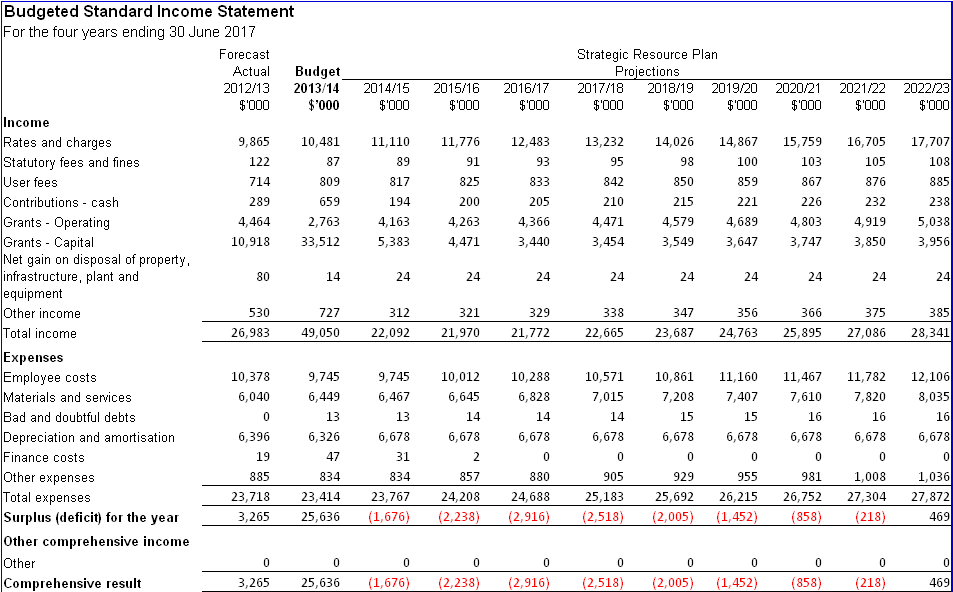
Buloke Shire Council Special Meeting Thursday, 25 July 2013
5.1.1 Proposed Budget For The Municipal Year Ending 30 June 2014
Attachment 1 Proposed Budget Year Ending 30 June 2014
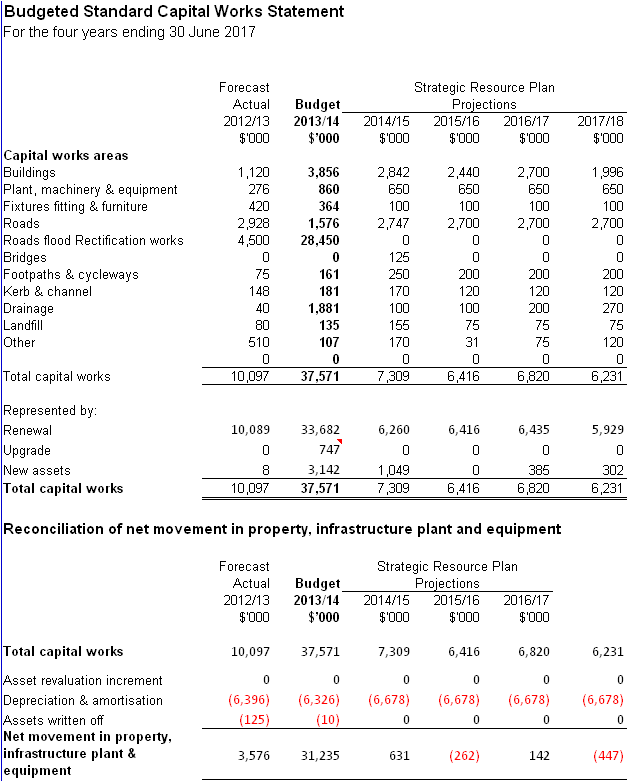
Appendix B - Statutory disclosures
This appendix presents information which the Act and the Regulations require to be disclosed in the Council’s annual budget.
The appendix includes the following budgeted information:
· Borrowings
· Rates and charges
· Differential rates.
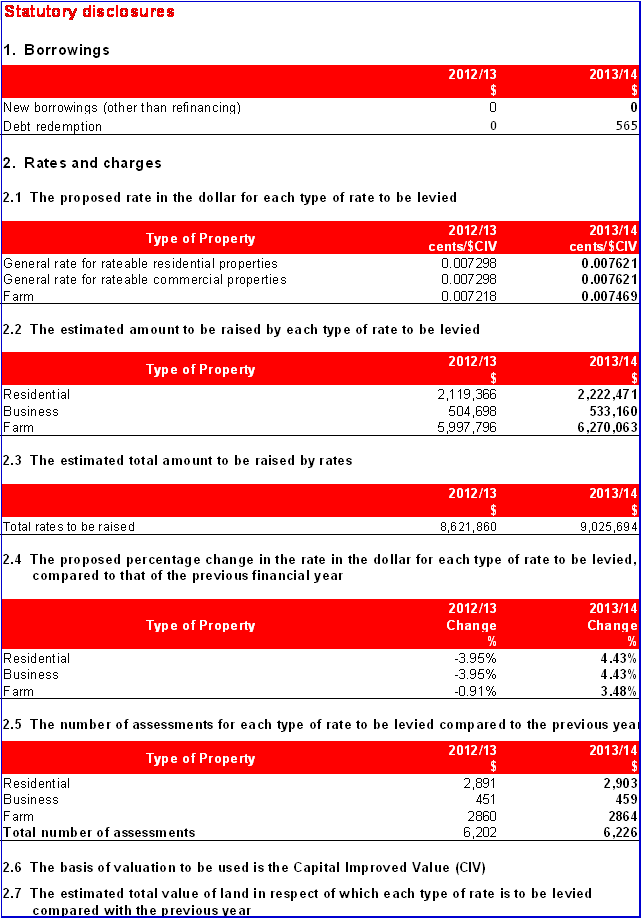
2.11 There are no known
significant changes, which may affect the estimated amounts to be
raised by rates and charges. However, the total amount to be raised by
rates and charges
may be affected by:
· The making of supplementary valuations;
· The variation of returned levels of value (e.g. valuation appeals);
· Changes of use of land such that rateable land becomes non-rateable land and vice versa; and
· Changes of use of land such that residential land becomes business land and vice versa.
3. Differential rates
1.1 Rates to be levied
· A general rate of 0.007621% (0.007621 cents in the dollar of CIV) for all rateable residential and business properties; and
· A concession rate of 0.007469% (0.007469 cents in the dollar of CIV) for all rateable farm properties.
· Each differential rate will be determined by multiplying the Capital Improved Value of rateable land (categorised by the characteristics described below) by the relevant percentages indicated above.
Council believes each differential rate will contribute to the equitable and efficient carrying out of council functions. Details of the objectives of each differential rate, the types of classes of land which are subject to each differential rate and the uses of each differential rate are set out below.
1.2 Business land.
Business land is any land which is:
· Occupied for the principal purpose of carrying out the manufacture or production of, or trade in, goods or services or
· Unoccupied but zoned commercial or industrial under the Buloke Shire Planning Scheme.
The objective of this differential rate is to ensure that all rateable land makes an equitable financial contribution to the cost of carrying out the functions of Council, including (but not limited to) the:
· Construction and maintenance of infrastructure assets
· Development and provision of health and community services
· Provision of general support services.
The types and classes of rateable land within this differential rate are those having the relevant characteristics described above.
The money raised by the differential rate will be applied to the items of expenditure described in the Budget by Council. The level of the rate for land in this category is considered to provide for an appropriate contribution to Council’s budgeted expenditure, having regard to the characteristics of the land.
The geographic location of the land within this differential rate is wherever it is located within the municipal district, without reference to ward boundaries.
The use of the land within this differential rate, in the case of improved land, is any use of land.
The characteristics of planning scheme zoning are applicable to the determination of vacant land which will be subject to the rate applicable to commercial land. The vacant land affected by this rate is that which is zoned commercial and/or industrial under the City of Victoria Planning Scheme. The classification of land which is improved will be determined by the occupation of that land, and have reference to the planning scheme zoning.
The types of buildings on the land within this differential rate are all buildings already constructed on the land or which will be constructed prior to the expiry of the 2013/14 financial year.
3.3 Residential land
Residential land is any land, which is:
· Occupied for the principal purpose of physically accommodating persons or
· Unoccupied but zoned residential under the Shire of Buloke Planning Scheme and which is not commercial land.
The objective of this differential rate is to ensure that all rateable land makes an equitable financial contribution to the cost of carrying out the functions of Council, including (but not limited to) the:
· Construction and maintenance of infrastructure assets
· Development and provision of health and community services
· Provision of general support services.
The types and classes of rateable land within this differential rate are those having the relevant characteristics described above.
The money raised by the differential rate will be applied to the items of expenditure described in the Budget by Council. The level of the rate for land in this category is considered to provide for an appropriate contribution to Council’s budgeted expenditure, having regard to the characteristics of the land.
The geographic location of the land within this differential rate is where it is located within the municipal district, without reference to ward boundaries.
The use of the land within this differential rate, in the case of improved land, is any use of land.
The characteristics of planning scheme zoning are applicable to the determination of vacant land which will be subject to the rate applicable to residential land. The vacant land affected by this rate is that which is zoned residential under the Victorian Local Council Planning Scheme. The classification of land which is improved will be determined by the occupation of that land, and have reference to the planning scheme zoning.
The types of buildings on the land within this differential rate are all buildings already on the land or which will be constructed prior to the expiry of the 2013/14 financial year.
3.4 Farm Land
Farm land is any rateable land:
· That is not less than 2 hectares in area;
· That is used primarily for grazing (including agistment), dairying, pig-farming, poultry farming, fish farming, tree farming, bee keeping, viticulture, horticulture, fruit growing or the growing of crops of any kind or any combination of those activities; and that is used by a business;
· That has significant and substantial commercial purpose or character;
· That seeks to make a profit on a continuous or repetitive basis from its activities on the land; and
· That is making a profit from its activities on the land, or that has a reasonable prospect of making a profit from its activities on the land, if it continues to operate in the way that it is operating.
It further be recorded that the objectives of the differential rate are those specified below:
· To maintain agriculture as a major industry in the municipal district every effort must be made to facilitate the longevity of the farm sector, to achieve a balance between providing for growth whilst retaining the important agricultural economic base; and,
· To ensure that the concessional rate in the dollar declared for defined Farm Land properties is fair and equitable, having regard to the cost of provision of Council services, and the level of benefits derived from expenditures made by Council on behalf of the farm sector.
4. Municipal Charge
A municipal charge is to be declared for the period commencing 1 July 2013 and concluding on 30 June 2014.
The municipal charge is to be declared for the purpose of covering some of the administrative costs of Council.
The municipal charge will be set at $130.00 per rateable assessment, for which the municipal charge may be levied.
The municipal charge is declared in respect of all rateable land within the municipal district in respect of which a municipal charge may be levied.
5. Service Charges
An annual service charge is to be declared for the period commencing on 1 July 2013 and concluding on 30 June, 2014.
.
An annual service charge is to be declared for the collection and disposal of waste (garbage).
The annual service charge is to be in the sum of $255.00 for each rateable urban and rural residence where the applicable (or part) and each rateable commercial property (exclusive of GST).
The criteria specified below is to be the criteria, which form the basis of the annual service charge (refuse collection and disposal) so declared:
· To recover the contract cost of provision of the refuse collection service;
· To recover the cost of disposal of collected refuse in Council’s Waste Disposal Sites; and
· Collection of waste from:
· Residential premises within the township areas,
· Residential properties in the rural collection area, and
· Commercial properties within the township areas.
Buloke Shire Council Special Meeting Thursday, 25 July 2013
5.1.1 Proposed Budget For The Municipal Year Ending 30 June 2014
Attachment 1 Proposed Budget Year Ending 30 June 2014
Appendix C - Capital works program
This appendix presents a listing of the capital works projects that will be undertaken for the 2013/14 year.
The capital works projects are grouped by class and include the following:
· New works for 2013/14
· Works carried forward from the 2012/13 year.
Capital Works Program 2013 /2014
|
ASSET DESCRIPTION |
TOTAL |
RENEWAL |
UPGRADE |
NEW |
|
|
|
$ |
$ |
$ |
$ |
|
|
LAND & BUILDINGS |
|
|
|
|
|
|
Community Facilities |
|
|
|
|
|
|
Donald Family Services Centre |
1,500,000 |
1,500,000 |
|
|
|
|
Berriwillock Multi-Purpose Centre (check actuals at June 1) |
602,000 |
602,000 |
|
|
|
|
Charlton Skate Park |
150,000 |
|
|
150,000 |
|
|
Charlton Travellers Rest Managers Cottage |
200,000 |
|
|
200,000 |
|
|
HACC Minor Projects (50k grant received in 12/13) |
50,000 |
50,000 |
|
|
|
|
|
|
|
|
|
|
|
Caravan Park Fire Protection/Compliance Works |
50,000 |
|
|
50,000 |
|
|
Wycheproof Mens Shed - Fire protection/Compliance works |
25,000 |
|
|
25,000 |
|
|
Donald Archive Building - Compliance works |
20,000 |
20,000 |
|
|
|
|
|
|
|
|
|
|
|
Swimming Pools |
|
|
|
|
|
|
Sea Lake Liner and Hydraulic Uprade |
110,000 |
|
|
110,000 |
|
|
Charlton Liner and Hydraulic Upgrade |
200,000 |
|
|
200,000 |
|
|
Charlton Liner and Hydraulic Upgrade |
100,000 |
|
|
100,000 |
|
|
Pool Technical Audit and Strategy |
55,000 |
|
|
55,000 |
|
|
Replace Automatic Controllers - Birchip, Berriwillock & Watchem |
6,000 |
6,000 |
|
|
|
|
Berriwillock Pool Shed Upgrade |
2,000 |
|
2,000 |
|
|
|
Wycheproof Pool Shade Structure |
10,000 |
|
10,000 |
|
|
|
Service all pool pumps |
5,000 |
5,000 |
|
|
|
|
Sea Lake and Wycheproof Disinfectant Upgrade |
40,000 |
|
40,000 |
|
|
|
Install new pool entry signs |
12,000 |
|
|
12,000 |
|
|
Paint Watchem and Birchip Pool |
45,000 |
45,000 |
|
|
|
|
Replace Birchip solar pump |
1,000 |
1,000 |
|
|
|
|
New Handrails at Birchip and Sea Lake |
6,000 |
6,000 |
|
|
|
|
Birchip Pool Tile Repairs |
4,000 |
4,000 |
|
|
|
|
Replace Berriwillock Concrete Tank |
10,000 |
10,000 |
|
|
|
|
Watchem Pool Pump Replacement |
7,000 |
7,000 |
|
|
|
|
Watchem Pool Sprinkler Upgrade |
1,400 |
|
|
1,400 |
|
ASSET DESCRIPTION |
TOTAL |
RENEWAL |
UPGRADE |
NEW |
|
|
$ |
$ |
$ |
$ |
|
Municipal Offices |
|
|
|
|
|
Office OH&S Essentials (annual) |
10,000 |
|
10,000 |
|
|
|
|
|
|
|
|
Sports Facilities/Parks and Gardens |
|
|
|
|
|
Birchip Bowling Green - Synthetic Surface |
285,000 |
285,000 |
|
|
|
Charlton Park 2020 Design Services |
220,000 |
|
|
220,000 |
|
Wycheproof Centenary Park Shade Structure |
28,000 |
28,000 |
|
|
|
Park Watering Systems Upgrade (across shire) |
20,000 |
|
20,000 |
|
|
Tree Removal and Replacement (across shire) (annual) |
5,000 |
5,000 |
|
|
|
Donald Recreation Reserve Essential Services Upgrade |
40,000 |
|
40000 |
|
|
Sea Lake Community Centre - Essential services upgrade |
18,000 |
|
18000 |
|
|
|
|
|
|
|
|
Other Council Buildings/Infrastructure |
|
|
|
|
|
Council Buildings Condition Audit |
50,000 |
50,000 |
|
|
|
Depot OH&S Essentials (annual) |
10,000 |
10,000 |
|
|
|
Birchip Hall Power upgrade |
31,000 |
31,000 |
|
|
|
Street Light Sustainability Upgrade |
31,000 |
31,000 |
|
|
|
Buloke Shire Honour Board |
4,650 |
|
|
4,650 |
|
Sub-Total - Land & Buildings |
3,964,050 |
2,696,000 |
140,000 |
1,128,050 |
|
|
|
|
|
|
|
FURNITURE, IT & EQUIPMENT |
|
|
|
|
|
Implement Stage 3 of Wireless program |
157,943 |
|
|
157,943 |
|
Minro Wireless Link Upgrade |
60,000 |
|
60,000 |
|
|
Desktop Replacement |
20,000 |
20,000 |
|
|
|
Laptop Replacement |
9,800 |
9,800 |
|
|
|
M&CH tablets |
3,090 |
3,090 |
|
|
|
Server Replacement (Birchip ESX Host Server) |
15,300 |
15,300 |
|
|
|
Wycheproof Tape drive upgrade - additional licensing and configuration |
21,570 |
|
21,570 |
|
|
Telephones and Hands Free Kits |
3,000 |
3,000 |
|
|
|
Network auditing and security reporting on file and network permissions |
7,020 |
7,020 |
|
|
|
Terminal server upgrade Citrix |
13,150 |
|
13,150 |
|
|
Two Way Radios |
7,000 |
7,000 |
|
|
|
Underground cabling to the records shed |
7,000 |
|
|
7,000 |
|
Edac generator monitor |
4,000 |
4,000 |
|
|
|
Software Upgrade - Huefner WMS and Lynx integration |
6,500 |
|
6,500 |
|
|
Spoftware upgrade - Huefner and RecFind integration |
6,000 |
|
6,000 |
|
|
Upgrade Software Staff Intranet & training |
15,000 |
|
15,000 |
|
|
Upgrade Records Scanner |
5,000 |
|
5,000 |
|
|
Birchip Main Switch |
3,000 |
|
3,000 |
|
|
Sub-Total - Furn & Equip |
364,373 |
69,210 |
130,220 |
164,943 |
|
ASSET DESCRIPTION |
TOTAL |
RENEWAL |
UPGRADE |
NEW |
|
|
$ |
$ |
$ |
$ |
|
|
|
|
|
|
|
PLANT & MACHINERY |
|
|
|
|
|
Heavy Plant Replacement |
330,000 |
330,000 |
|
|
|
Light Fleet Replacement |
150,000 |
150,000 |
|
|
|
Small Plant |
20,000 |
20,000 |
|
|
|
Jetpatcher Carried Forward |
350,000 |
350,000 |
|
|
|
|
|
|
|
|
|
Sub-Total - Plant & Machinery |
850,000 |
850,000 |
0 |
0 |
|
|
|
|
|
|
|
INFRASTRUCTURE |
|
|
|
|
|
Roads - Sealing |
|
|
|
|
|
Massey Banegrang Rd (Final Seal) (ch. 4,920 -6,610) |
40,560 |
40,560 |
|
|
|
McLoughlan Rd (Final Seal) (ch. 2,295-4,320) |
48,600 |
48,600 |
|
|
|
McLoughlan Rd (Final Seal) (0-1,025) |
24,600 |
24,600 |
|
|
|
Hogans Rd No 3 (ch. 1,670-2,200) |
9,158 |
9,158 |
|
|
|
Queen St, Birchip (ch. 0-111) |
7,010 |
7,010 |
|
|
|
Lewis St, Donald (ch. 0-122) |
5,608 |
5,608 |
|
|
|
Lewis St, Donald (ch. 122-243) |
6,389 |
6,389 |
|
|
|
Complex Dr, Sea Lake (ch 456 - 575) |
3,998 |
3,998 |
|
|
|
Karyrie Station Rd (ch. 0-1,500) |
28,080 |
28,080 |
|
|
|
Waddell St, Donald (ch. 167 - 329) |
4,432 |
4,432 |
|
|
|
Waddell St (ch. 329-908) |
10,561 |
10,561 |
|
|
|
Wilkur Watchupga Rd (ch. 23,710-25,450) |
41,760 |
41,760 |
|
|
|
Wilkur Watchupga Rd (ch. 25,450-26,755) |
23,803 |
23,803 |
|
|
|
Watson St, Birchip (ch. 491-595) |
4,656 |
4,656 |
|
|
|
Wilson St, Charlton (ch. 0-254) |
7,322 |
7,322 |
|
|
|
Camp St Wycheproof (ch. 140-370) |
7,949 |
7,949 |
|
|
|
Currie St, Charlton (ch. 263 - 350) |
2,714 |
2,714 |
|
|
|
Jeffcott South School Bus Route (ch. 5,050-6,235) |
22,183 |
22,183 |
|
|
|
Massey Banegrang Rd (ch. 3,690-4920) |
22,435 |
22,435 |
|
|
|
Meyer St, Donald (ch. 335-548) |
12,661 |
12,661 |
|
|
|
Railway Ave, Sea Lake (ch. 435-674) |
9,866 |
9,866 |
|
|
|
Simpson St, Birchip (Ch 100-250) |
7,217 |
7,217 |
|
|
|
Watchem Corack Rd (ch. 3,560-4,785) |
33,516 |
33,516 |
|
|
|
Duncan St, Birchip (ch. 383-504) |
5,343 |
5,343 |
|
|
|
Greer St, Sea Lake (ch. 260-378) |
4,078 |
4,078 |
|
|
|
Jenkins St, Charlton (Ch 0-245) |
7,127 |
7,127 |
|
|
|
Watchem Corack Rd (ch. 6,260-8,290 |
38,002 |
38,002 |
|
|
|
Camp St Wycheproof (ch. 492-614) |
21,024 |
21,024 |
|
|
|
Dyer St, Donald (ch. 0-424) |
8,141 |
8,141 |
|
|
|
High St Wycheproof (ch. 0-168) |
7,385 |
7,385 |
|
|
|
High St Wycheproof (ch. 168-251) |
4,621 |
4,621 |
|
|
|
Karyrie Station Rd (ch. 1,500-2,410) |
16,598 |
16,598 |
|
|
|
Baden Powell Dr, Charlton (ch. 275-430) |
4,315 |
4,315 |
|
|
|
View St, Charlton (ch. 0-169) |
4,812 |
4,812 |
|
|
|
Webster St, Wycheproof (ch. 0 -93) |
3,087 |
3,087 |
|
|
|
Webster St, Wycheproof (ch. 350-440) |
3,715 |
3,715 |
|
|
|
Hogans Rd No 3 (ch. 3,160-3895) |
13,759 |
13,759 |
|
|
|
Hogans Rd No 3 (ch. 3970-4735) |
14,688 |
14,688 |
|
|
|
Johnston St, Birchip (ch 0-111) |
6,125 |
6,125 |
|
|
|
Meyer St, Donald (ch. 112-335) |
13,808 |
13,808 |
|
|
|
ASSET DESCRIPTION |
TOTAL |
RENEWAL |
UPGRADE |
NEW |
|
|
$ |
$ |
$ |
$ |
|
Sheephills Rd (ch. 1875-2085) |
3,629 |
3,629 |
|
|
|
Swan Water North Rd (ch. 40-1630) |
29,002 |
29,002 |
|
|
|
Swan Water North Rd (ch. 1,835-2,805) |
17,693 |
17,693 |
|
|
|
Walker St, Donald (ch. 213-436) |
11,025 |
11,025 |
|
|
|
Devon Park Rd (ch. 5,180-6,810) |
28,166 |
28,166 |
|
|
|
Jolly St, Wycheproof |
8,800 |
8,800 |
|
|
|
Jolly St, Wycheproof (ch. 0-200) |
4,047 |
4,047 |
|
|
|
Jolly St, Wycheproof (ch. 200-324) |
3,786 |
3,786 |
|
|
|
Watson St Charlton (ch. 0-230) |
6,258 |
6,258 |
|
|
|
Charles St, Wycheproof (ch. 118-255) |
4,808 |
4,808 |
|
|
|
Kaye St, Charlton (ch. 78-274) |
5,534 |
5,534 |
|
|
|
Johnston St, Birchip (ch. 111-265) |
7,244 |
7,244 |
|
|
|
Johnston St, Birchip (ch. 487-750) |
13,296 |
13,296 |
|
|
|
Sheephills Rd (ch. 2,085-3,500) |
25,130 |
25,130 |
|
|
|
Duncan St, Birchip (ch 230-383) |
6,756 |
6,756 |
|
|
|
Laen-Litchfield Rd (ch. 8,855-10,045) |
28,560 |
28,560 |
|
|
|
|
|
|
|
|
|
|
|
|
|
|
|
Roads - Resheets |
|
|
|
|
|
Taylors Rd (ch. 6,060-7,000) |
50,771 |
50,771 |
|
|
|
Rupanyup Rd (ch. 14,710-18,383) |
126,693 |
126,693 |
|
|
|
Edwards Rd (ch. 3,370-5,730) |
97,237 |
97,237 |
|
|
|
M.Stacey Rd (ch 1,440-3,250) |
62,950 |
62,950 |
|
|
|
Forresters Rd (ch. 2,975-4,330) |
14,927 |
14,927 |
|
|
|
Thompsons Rd (ch. 2,640-3,685) |
51,456 |
51,456 |
|
|
|
Myall School Bus Rd (ch. 10,550-11,400) |
26,794 |
26,794 |
|
|
|
Allisons Rd (ch. 2,470-3,435) |
30,313 |
30,313 |
|
|
|
Thompsons Rd No. 2 (ch. 3,600-4,670) |
52,526 |
52,526 |
|
|
|
Towerhill Road (ch. 1,360-2,355) |
31,321 |
31,321 |
|
|
|
|
|
|
|
|
|
|
|
|
|
|
|
Roads - Shoulder Resheets |
|
|
|
|
|
Culgoa Lalbert Road (ch. 15,400-16,200) |
34,060 |
34,060 |
|
|
|
Nullawil Lalbert Road (ch. 2,735-6,655) |
111,544 |
111,544 |
|
|
|
Wilkur Watchupga Road (ch. 26755-31,019) |
106,869 |
106,869 |
|
|
|
|
|
|
|
|
|
Footpaths |
|
|
|
|
|
Main Street, Culgoa (173m) - Hotel to Park |
56,000 |
56,000 |
|
|
|
Mudge Street Sea Lake (298m) - Kinder to Hannon |
72,000 |
72,000 |
|
|
|
Howard Lane, Sea Lake (45m) - Park to Best St. |
11,000 |
11,000 |
|
|
|
|
|
|
|
|
|
|
|
|
|
|
|
Kerb and Channel |
|
|
|
|
|
Campbell Street, Donald (88m) - railway to walker street |
50,000 |
50,000 |
|
|
|
Baxter Street, Nullawil (220m) |
66,000 |
66,000 |
|
|
|
Hoban Street, Watchem (100m)- Post office to Park |
38,000 |
38,000 |
|
|
|
Percy Street, Birchip (45m) - Corner of Cumming Ave |
10,000 |
10,000 |
|
|
|
Johnson Street, Birchip |
8,900 |
8,900 |
|
|
|
Hoban Street, Watchem (100m)- Old Post office to Pub |
8,100 |
8,100 |
|
|
|
|
|
|
|
|
|
ASSET DESCRIPTION |
TOTAL |
RENEWAL |
UPGRADE |
NEW |
|
|
$ |
$ |
$ |
$ |
|
Bridges, Culverts, Pumps and Drainage |
|
|
|
|
|
Charlton Stormwater Re-use Upgrade |
85,000 |
|
85,000 |
|
|
Cecil Street, Culgoa - Development of Plans for culverts |
2,500 |
|
2,500 |
|
|
Watchem Drainage and Beautifaction Plan - Sunraysia Highway |
6,000 |
|
6,000 |
|
|
Elizabeth Street, Donald (GM Water Gate to culvert) Plans |
2,500 |
2,500 |
|
|
|
Birchip Stormwater Overflow Plans (dam at Abbott Street) |
2,500 |
2,500 |
|
|
|
Replace Stahl Street Pump, Wycheproof |
10,000 |
10,000 |
|
|
|
Donald (Penfolds) Pump upgrade |
20,000 |
|
20,000 |
|
|
Street Drain Maintenance and Cleaning |
40,000 |
40,000 |
|
|
|
Charlton Flood Study - Levee Detailed Design |
250,000 |
|
|
250,000 |
|
Charlton Flood Study - St Arnaud Road Floodway |
500,000 |
|
|
500,000 |
|
Donald Flood Study - Levee Development stage 1. |
925,000 |
|
|
925,000 |
|
Charlton Menzies St Drainage |
30,000 |
30,000 |
|
|
|
|
|
|
|
|
|
Waste Management |
|
|
|
|
|
New Garbage Bins (annual) |
15,000 |
15,000 |
|
|
|
New Landfill Cells (annual)- all sites |
30,000 |
30,000 |
|
|
|
Landfill Rehabiliation (annual) |
25,000 |
25,000 |
|
|
|
Street Bin Surrounds |
10,000 |
10,000 |
|
|
|
Recycle Skips (Birchip and Sea Lake) |
50,000 |
50,000 |
|
|
|
|
|
|
|
|
|
Saleyards |
|
|
|
|
|
Replace Damaged Fencing |
5,000 |
5,000 |
|
|
|
|
|
|
|
|
|
|
|
|
|
|
|
Other Infrastructure |
|
|
|
|
|
Donald Aerodrome power Supply |
24,000 |
24,000 |
|
|
|
Gravel Pit Restoration |
10,000 |
10,000 |
|
|
|
Charlton Aerodrome Automated lighting system |
7,000 |
7,000 |
|
|
|
Gable markers - all aerodromes |
10,000 |
10,000 |
|
|
|
|
|
|
|
|
|
|
|
|
|
|
|
|
|
|
|
|
|
Sub-Total - Infrastructure |
3,942,407 |
2,153,907 |
113,500 |
1,675,000 |
|
|
|
|
|
|
|
OTHER STRUCTURES |
|
|
|
|
|
Floodworks (C6 - C12) |
28,450,000 |
28,450,000 |
|
|
|
Grants commission Unallocated |
|
|
|
|
|
|
|
|
|
|
|
Sub-Total - Other Structures |
28,450,000 |
28,450,000 |
0 |
0 |
|
GRAND TOTAL |
37,570,830 |
34,219,117 |
383,720 |
2,967,993 |
|
Infrastructure |
36,356,457 |
33,299,907 |
253,500 |
2,803,050 |
|
Other |
1,214,373 |
919,210 |
130,220 |
164,943 |
Buloke Shire Council Special Meeting Thursday, 25 July 2013
5.1.1 Proposed Budget For The Municipal Year Ending 30 June 2014
Attachment 1 Proposed Budget Year Ending 30 June 2014
Appendix D - Fees and charges schedule
This appendix presents the fees and charges of a statutory and non-statutory nature which will be charged in respect to various goods and services provided during the 2013/14 year.
![]()
VENUE HIRE - PUBLIC HALLS
|
(Casual hire) |
Main Hall (max. 6 hours) |
Supper Room (max. 6 hours) |
Cost p/h (over max. hours) |
Kitchen |
All day booking (24 hours, full use of venue) |
Bond |
|
Birchip (max. 250 people) |
$200.00 |
$50.00 |
$35.00 |
$30.00 |
$350.00 |
$300.00 |
|
Charlton (max. 300 people) |
$200.00 |
$50.00 |
$35.00 |
$30.00 |
$350.00 |
$300.00 |
|
Donald (max. 250 people) |
$200.00 |
$50.00 |
$35.00 |
$30.00 |
$350.00 |
$300.00 |
|
Wycheproof (max. 250 people) |
$200.00 |
$125.00 |
$35.00 |
$30.00 |
$350.00 |
$350.00* |
A Bond is required for all bookings where alcohol is served. The Bond is refundable if there is no damage or requirement for additional cleaning.
*Inspections will be carried out by Buloke Shire Council’s Hall Attendant.
Casual Hire is defined as: Any group, individual or organisation that hires the facility once off or on an irregular basis.
SENIOR CITIZENS
|
Clubrooms
|
Charlton |
Donald |
Wycheproof |
|
Max. 6 hours |
$85.00 |
$100.00 |
$50.00 |
|
Cost per hour over max. |
$20.00 |
$20.00 |
$20.00 |
|
Regular Hire
|
|
|
Private or Commercial |
$30.00 |
|
Community Organisations/Groups |
$20.00 |
Regular Hire is defined as: Any group, individual or organisation that hires the facility on an ongoing basis. To be considered a Regular User, one of the following criteria must be met;
· Weekly hire - minimum of 10 consecutive weeks,
· Fortnightly hire - minimum of 10 consecutive fortnights,
· Monthly hire - minimum of 10 consecutive months
Commercial hirers are defined as those who undertake activities for the purpose of generating a profit.
Non-commercial hirers:
Community groups: Groups who meet for the purpose of providing a service for the community’s benefit. Such groups will only be recognised through a statement of incorporation, or sponsorship through an auspice body.
Private/Individual hirers: Those who undertake activities for the purpose of private events and activities.
Negotiation of Fees: Requests for reducing or waiving of fees must be made in writing to the Chief Executive Officer. Decision is at the discretion of the Chief Executive Officer.
Waived fees will be registered as a donation from Council and listed in the Annual Report.
WYCHEPROOF SALEYARDS
|
Saleyard Fees |
2012/2013 |
2013/2014
|
|
Yard Fees |
0.6% of gross sales turnover |
0.6% of gross sales turnover |
|
Agent’s Fees |
12% of yard fees |
12% of yard fees |
|
Truck Wash |
||
|
Key Deposit (Avdata) refunded on return of keys |
$24.00 |
$24.00 |
|
Water Usage |
$0.60 per minute |
$0.80 per minute |
COMMUNITY BUS HIRE
|
Bus Fees |
2012/2013 |
2013/2014
|
|
Hire rate per day or part thereof |
$14.00 |
$14.00 |
|
Plus 90 cents per kilometre travelled |
$0.90 |
$0.90 |
STAND PIPES
|
Stand Pipes |
2012/2013 |
2013/2014
|
|
|
$2.323 per 1,000 litres |
$$5.00 per 1,000 litres or part there of |
PHOTOCOPYING
|
Black and White Copying |
White Paper |
Colour Paper |
|||
|
|
2012/2013 |
2013/2014 |
2012/2013 |
2013/2014
|
|
|
0-10 copies |
A4 Single Sided |
30c per page |
30c per page |
35c per page |
35c per page |
|
|
A4 Double Sided |
45c per page |
45c per page |
50c per page |
50c per page |
|
|
A3 Single Sided |
45c per page |
45c per page |
50c per page |
50c per page |
|
|
A3 Double Sided |
60c per page |
60c per page |
65c per page |
65c per page |
|
Bulk Copies |
A4 10-100 Single Sided |
25c per page |
25c per page |
30c per page |
30c per page |
|
|
A4 10-100 Double Sided |
35c per page |
35c per page |
40c per page |
40c per page |
|
|
A4 101+ Single Sided |
20c per page |
20c per page |
25c per page |
25c per page |
|
|
A4 101+ Double Sided |
30c per page |
30c per page |
35c per page |
35c per page |
|
|
A3 10-50 Single Sided |
40c per page |
40c per page |
45c per page |
45c per page |
|
|
A3 10-50 Double Sided |
50c per page |
50c per page |
55c per page |
55c per page |
|
|
A3 51-100 Single Sided |
35c per page |
35c per page |
40c per page |
40c per page |
|
|
A3 51-100 Double Sided |
45c per page |
45c per page |
50c per page |
50c per page |
|
|
A3 101+ Single Sided |
30c per page |
30c per page |
35c per page |
35c per page |
|
|
A3 101+ Double Sided |
40c per page |
40c per page |
45c per page |
45c per page |
|
Colour Copying (no photographic paper available) |
2012/2013 |
2013/2014 |
2012/2013 |
2013/2014
|
|
|
|
A4 Single Sided Colour |
$2.50 per page |
$2.50 per page |
$2.50 per page |
$2.50 per page |
|
|
A4 Double Sided Colour |
$3.25 per page |
$3.25 per page |
$3.25 per page |
$3.25 per page |
|
|
A4 20+ Single & Double Colour |
20% of total cost based on the above prices |
20% of total cost based on the above prices |
20% of total cost based on the above prices |
20% of total cost based on the above prices |
|
|
A3 Single Sided Colour |
$5.00 per page |
$5.00 per page |
$5.00 per page |
$5.00 per page |
|
|
A3 Double Sided Colour |
$7.50 per page |
$7.50 per page |
$7.50 per page |
$7.50 per page |
|
|
A3 20+ Single & Double Colour |
20% of total cost based on the above prices |
20% of total cost based on the above prices |
20% of total cost based on the above prices |
20% of total cost based on the above prices |
ANIMAL CONTROL
|
Dog and Cat Registration Fees *Since May 2007 Council can only register animals that have been micro chipped |
2012/2013 |
2013/2014
|
|
Dog or Cat (Not Micro chipped or Desexed – only relevant to animals registered prior to May 2007) |
$60.00 |
$60.00 |
|
Dogs (Micro chipped plus one or more of the following – desexed, not desexed, working or farm dog, over 10 years old or VCA members) |
$20.00 |
$20.00 |
|
Cats (Micro chipped plus one or more of the following – desexed, not desexed, over 10 years old or Feline Association member) |
$20.00 |
$20.00 |
|
Pensioner Concession (Half price for all dog and cat registration categories) |
$10.00 |
$10.00 |
|
Guide dogs, racing dogs (greyhounds), police dogs |
No Charge |
|
|
Replacement lifetime tag/s |
No Charge |
|
|
Registered animals moving to Buloke |
No Charge |
|
IMPOUNDED LIVESTOCK
|
Release Fees |
2012/2013 |
2013/2014
|
|
Sheep up to 5 head |
$30.00 |
$30.00 |
|
Sheep per head over 5 |
$5.00 |
$5.00 |
|
Goats and pigs up to 2 head |
$30.00 |
$30.00 |
|
Goats and pigs per head over 2 |
$10.00 |
$10.00 |
|
Cattle up to 3 head |
$100.00 |
$100.00 |
|
Cattle per head over 3 |
$50.00 |
$50.00 |
|
Horses per head |
$100.00 |
$100.00 |
|
Sustenance – per day – per head |
2012/2013 |
2013/2014
|
|
Sheep |
$5.00 |
$5.00 |
|
Goats and Pigs |
$10.00 |
$10.00 |
|
Cattle and Horses |
$10.00 |
$10.00 |
|
Dogs and Cats (includes sustenance) – per dog and cat |
2012/2013 |
2013/2014
|
|
1 to 4 days |
$55.00 |
$55.00 |
|
For every day in excess of 4 days (maximum 8 days) |
$11.00 |
$11.00 |
|
Impounded Vehicles and Caravans – per vehicle |
2012/2013 |
2013/2014
|
|
Release fee (plus towing fee incurred) |
$153.00 |
$153.00 |
SUNDRY DEBTORS
|
Hire of Council equipment and operator where local service alternatives are not available, including compulsory fire clearances. |
2012/2013 |
2013/2014
|
|
Plant |
150% of internal plant hire rate |
150% of internal plant hire rate |
|
Operator (Labour) |
$50.00 per hour plus plant fee – as above |
$50.00 per hour plus plant fee – as above |
|
Sandstone/Gravel from Council quarry |
$10.00 per cubic metre |
$10.00 per cubic metre |
|
Quarry products from non-Council quarry sources |
Cost to Council plus plant and operator costs – as above. |
Cost to Council plus plant and operator costs – as above. |
WASTE CHARGES
|
Waste |
2012/2013 |
2013/2014
|
|
Municipal Waste Collection and Disposal Charge (One 120L bin for putrescibles waste (collected weekly) and one 240L bin for recyclables (collected fortnightly). Service is compulsory for all residential properties and available to commercial and farm properties on request. |
$240.00 |
$255.00 |
|
Optional additional 240L bin for recycling |
$70.00 per bin |
$75.00 per bin |
|
Landfill |
2012/2013 |
2013/2014
|
|
Up to 3 cubic metres of sorted recyclables, uncontaminated green waste, commercial cardboard. For larger volumes please contact Council to receive a quote. |
Free for local residents and businesses only |
Free for local residents and businesses only |
|
Car boot per load |
N/A |
N/A |
|
6 x 4 Trailer Load/Ute Load up to 1 cubic metre |
$15.00 |
$17.00 |
|
Tandem Trailer up to 2 cubic metres |
$30.00 |
$34.00 |
|
Wheelie bin 120L |
$5.00 |
$5.00 |
|
Wheelie bin 240L |
$5.00 |
$5.00 |
|
General Waste to Landfill per cubic metre |
$15.00 |
$17.00 |
|
Commercial Waste |
$15.00 per cubic m |
$17.00 per cubic m |
|
Builder Waste and Concrete |
$15.00 per cubic m |
$17.00 per cubic m |
|
Concrete uncontaminated |
$15.00 per cubic m |
$17.00 per cubic m |
|
Bricks uncontaminated |
$15.00 per cubic m |
$17.00 per cubic m |
|
White Goods (doors must be removed from refrigerators, ovens and dishwashers) |
Free to local residents only |
Free to local residents only |
|
Car Bodies |
Free to local residents only |
Free to local residents only |
|
TV Screens and Computer Monitors |
$5.00 |
$10.00 |
|
Tyres |
2012/2013 |
2013/2014
|
|
Light car tyre |
$5.00 |
$5.00 |
|
Car tyre on rim |
$20.00 |
$20.00 |
|
4WD and Light Truck tyre |
$10.00 |
$10.00 |
|
Truck tyre |
$25.00 |
$25.00 |
|
Super single tyre |
N/A |
N/A |
|
Truck tyre on rim |
$40.00 |
$40.00 |
|
Small tractor tyres |
$80.00 |
$80.00 |
|
Large tractor tyres |
$140.00 |
$140.00 |
|
Animal Carcasses |
2012/2013 |
2013/2014
|
|
Poultry (including turkeys) per bird |
$5.00 |
$5.00 |
|
Cats and Dogs |
$5.00 |
$5.00 |
|
Sheep, Pigs and Goats |
$10.00 |
$10.00 |
|
Horses and Cattle |
$20.00 |
$20.00 |
SWIMMING POOL FEES
|
Season Membership |
2012/2013 |
2013/2014
|
|
Family |
No charge |
No charge |
|
Adult |
No charge |
No charge |
|
Child |
No charge |
No charge |
|
Monthly Memberships |
No charge |
No charge |
|
Family |
No charge |
No charge |
|
Adult |
No charge |
No charge |
|
Child |
No charge |
No charge |
|
Daily Tariffs |
No charge |
No charge |
|
Adult |
No charge |
No charge |
|
Children 3 & Over |
No charge |
No charge |
|
Children under 3 |
No charge |
No charge |
|
Non-Swimmers |
No charge |
No charge |
|
Student Concessions |
No charge |
No charge |
|
Students involved in School swimming programs that do not have a membership. (Season extends from November to March.) |
No charge |
No charge |
BUILDING FEES AND CHARGES
|
Dwellings |
2013/2014
|
|
Building Works - $0 to $2,500 |
$250.00 |
|
Building Works - $2,501 to $5,000 |
$350.00 |
|
Building Works - $5,000 to $10,000 |
$450.00 |
|
Building Works - $10,001 to $20,000 |
$650.00 plus Levy |
|
Building Works - $20,001 to $80,000 |
$950.00 plus Levy |
|
Building Works - $80,001 to $120,000 |
$1,500.00 plus Levy |
|
Building Works - $120,001 to $200,000 |
$value /75 plus Levy |
|
Building Works - $200,000 plus |
$value /75 plus Levy |
|
Alterations/Additions/Sheds/Carports/Garages |
2013/2014
|
|
New Dwellings - $0 to $120,000 |
$1,200.00 plus Levy |
|
New Dwellings - $120,000 to $200,000 |
$1,500.00 plus Levy |
|
New Dwellings - $200,000 to $312,000 |
$1,800.00 plus Levy |
|
New Dwellings - $312,000 plus |
$value /130 plus Levy |
|
Swimming Pools |
2013/2014
|
|
Swimming Pool and Fence – Above Ground |
$400.00 |
|
Swimming Pool and Fence – In-Ground Pool |
$800.00 |
Notes:
® A $34.00 Lodgement Fee applies to all application for works valued at $5,000 or more.
® 2012/2013 Fee proposals have been based on fee structure of surrounding Councils.
® No fee details’ comment indicates that fees for these services were previously set at the discretion of the Building Surveyor.
® Legislative Fees to be set as part of the State Budget and are forecast to rise by 12.5%.
|
Commercial Building Work |
2013/2014
|
|
Commercial Works - $0 to $10,000 |
$350.00 plus Levy |
|
Commercial Works - $10,001 to $20,000 |
$650.00 plus Levy |
|
Commercial Works - $20,001 to $100,000 |
$value x 1.33% plus $400 plus Levy |
|
Commercial Works - $100,001 to $500,000 |
$value x 0.44&% plus $1,200 plus Levy |
|
Commercial Works - $500,000+ |
$value x 0.25% plus $2,000 plus Levy |
|
Multi-Unit Development |
2013/2014
|
|
Units - $0 to $200,000 |
$1,800.00 plus Levy |
|
Units - $200,001 to $312,000 |
$2,000.00 plus Levy |
|
Units - $312,000+ |
$value/130 plus Levy |
|
Enforcement |
2013/2014
|
|
Building Notices/Orders (To allow buildings to remain as constructed, without a Building Permit) |
Building Permit Fee plus 25% |
|
Miscellaneous Items |
2013/2014
|
|
Fence |
$200.00 |
|
Demolitions or Removals - $0 to $5,000 |
$350.00 |
|
Demolitions or Removals - $5,000+ |
$500.00 |
|
Re-Erections of Dwellings – Security Deposit |
$5,000.00 |
|
Extensions of Time Requests |
$100.00 |
|
Amended Plans |
$100.00 |
|
Information Request Reg. 326 (1) Permit Info, Final Certifications, Current Orders or Notices |
Legislative fee |
|
Information Request Reg. 326 (2) Flooding, Termite, Bushfire, Snowfall, Designated |
Legislative fee |
|
Information Request Reg. 326 (3) Mandatory notification states, Inspection Dates |
Legislative fee |
|
Request for search of Building Permit Plans |
$60.00 |
|
Report and Consent |
2013/2014
|
|
Planning Authority for Demolition Section 29A of the Act |
Legislative fee |
|
Build Over Council Easement Reg. 310 (1) |
Legislative fee |
|
Report & Consent under Parts 4, 5 or 8 |
Legislative fee |
|
Request Legal Point of Discharge for Stormwater Reg. 610 (2) |
Legislative fee |
|
External Inspection (i.e. Private Building Surveyors) |
2013/2014
|
|
Additional Inspection |
$120.00 |
|
Contract Inspection – Foundations, Reinforcement and Finals |
$180.00 |
|
Contract Inspection – Frame |
$200.00 |
|
Occupancy Permit/Places of Public Entertainment |
$200.00 |
|
Travel Time and Vehicle Costs – (where more than 5km from Donald Office) |
$1.00 per km plus $75.00 per hour |
|
Government Levy (only applies if development value over $10,000) |
2013/2014
|
|
Additional Inspection |
$120.00 |
Notes:
® A $34.00 Lodgement Fee applies to all application for works valued at $5,000 or more.
® 2013/2014 Fee proposals have been based on fee structure of surrounding Councils.
® No fee details’ comment indicates that fees for these services were previously set at the discretion of the Building Surveyor.
® Legislative Fees to be set as part of the State Budget and are forecast to rise by 12.5%.
ENVIRONMENTAL HEALTH
|
Food Act |
2013/2014
|
|
Class 1 Food Premises – High Risk ready to eat food serves to vulnerable groups. Including hospitals, nursing homes, child care centres. Must have 3rd party audited FSP. |
$250.00 |
|
Class 2 Food Premises – High Risk or unpackaged foods. Including hotels, restaurants cafes, takeaway, supermarkets, manufacturers, caterers, milk bars and some service stations. Must have FSPI (may be template or 3rd Party audited) |
$200.00 |
|
Class 3 Food Premises – Premises selling low risk pre-packaged food only e.g. Packaged confectionary, soft drink, Newsagents, video stores, some service stations. |
$50.00 |
|
Non Profit Organisations & Community Groups – Food is prepared predominately for consumption by members, or for fundraising activities Service Clubs, mostly Sporting Clubs |
$20.00 |
|
Street Stalls/Temporary Food Vendor Permits; Non Profit & Community Groups (fetes, sausage sizzle, street stall) Single Event Permit Yearly Permit (up to 12 Events per year) Private Individuals & Businesses (Markets, Private Stalls) Single Event Permit Yearly Permit (up to 12 Events per year) |
$20.00 $20.00
$20.00 $40.00 |
|
Transfers Fees |
50% of the current classed fee both Food & Health Act |
|
Transfer Inspection Fee |
$75.00 |
|
Public Health and Wellbeing Act |
2013/2014
|
|
Hairdresser/Beauty Therapy /Skin Penetration |
$80.00 |
|
Prescribed Accommodation Premises providing accommodation for 5 or more persons including hotels, motels, hostels and camps. |
$80.00 |
|
Environmental Protection Act |
2013/2014
|
|
Septic Tank ® New ® Alteration to Existing |
$200.00 $150.00 |
5.1.3 Review of Mayor and Councillor Allowances
Author’s Title: Chief Executive Officer
Department: Office of the CEO File No: GO/06/11
|
Nil |
Relevance to Council Plan 2013 - 2017
Objective: A Buloke community where people of all ages, backgrounds and abilities, are embraced and supported and can access the Council services they need to help live healthy and fulfilling lives.
Strategy: Working with communities and other stakeholders in planning for and making decisions about the future
Priority: Ensure all major projects and strategies are informed through community and stakeholder consultation which is guided by Council’s Community Consultation framework and, where relevant, appropriate advisory committees and/or consultative mechanisms
|
That: Council
1. At the same time that it gives Notice pursuant to Section 223 of the Local Government Act 1989 of the adoption of the 20103/14 Budget in principle 2. Give notice pursuant to Section 223 of the Local Government Act 1989 of its intention to set the annual allowances for Councillors and the Mayor for the next 4 years as follows: Councillors - $16,232 and Mayor - $48,696. 3. Consider all submissions made with respect to the review of Councillor and Mayoral allowances following conclusion of the public submission process.
Seconded: Cr David Pollard Carried. |
1. Executive Summary
Council must set the level of Councillor and Mayoral allowances within a period of six months after a general election or by next 30 June. The level of allowances, as set by Council through the review process will be the base rate for the term of this Council (four years).
Once set, the allowance cannot be revised again unless the Minister undertakes a review of the categories of Councils.
Allowances are subject to automatic annual adjustment that is announced in the Victorian Government Gazette by the Minister for Local Government.
In setting allowances for the Mayor and Councillors Buloke has historically set the levels near the top of the range.
2. Discussion
Council has a legislative requirement under section 74 of the Local Government Act (the Act) to review and determine the level of the Councillor allowance and the Mayoral allowance within a period of six months after a general election or by next 30 June, whichever is later.
The review process includes a section 223 public consultation (see details ‘Consultation’ below) before the allowances can be set for the next four years.
Mayoral and Councillor allowances ranges and limits within the allocated categories are determined by an Order in Council (Minister for Local Government (the Minister)).
Councils are designated either a category 1, 2 or 3. The categories are derived by Local Government Victoria from a formula based on an individual Council’s population and annual revenue.
Buloke is a Category 1 Council and allowances paid currently are set at the uppermost allowance limit within the range for this category.
The 2012 review of allowances resulted in a 2.5% increase.
Category ranges as at 27 October 2012 with the 2.5% adjustment:
Category One – $7,542 to $17,969 (Councillors) and $53,684 (Mayor) per annum
Category Two - $9,317 to $22,405 (Councillors) and $69,325 (Mayor) per annum
Category Three – $11,204 to $26,843 (Councillors) and $85,741 (Mayor) per annum
Mayoral and Councillor allowances are subject to the addition of the equivalent of the superannuation guarantee (currently 9.25%) and it is each Councillor’s own choice whether to put the 9.25% (or any additional sum) into superannuation or not.
|
Details of the current level of allowances paid to Councillors (Category 1) |
Range |
Current level paid |
Allowance plus 9.25% |
|
Councillors |
$7,542 to $17,969 |
$16,232 |
$17,733 |
|
Mayor |
Up to $53,684 |
$48,696 |
$53,200 |
Council is required to review the current allowances and then seek public comment.
Following consideration of public submissions, Council can then determine the allowance level which will stand for the next four years.
Council may resolve to retain allowances at the current level or a lesser amount.
ELIGIBLE LOCAL GOVERNING BODY
Councillors receive allowances over the year.
The payments are to compensate Councillors for the duties performed as an elected local government Councillor
A 2005 Taxation Determination provided that a person who holds office as Councillor is not an ‘employee’ of the Council. As a result income tax is not deducted from Councillor allowances.
There is an option for a Council to determine to be an ‘Eligible Local Governing Body’ (ELGB). This needs to be determined by a unanimous resolution of Council.
If Council does not make a unanimous resolution to become an ELGB the status quo remains, that is, Councillors will not be deemed to be employees. Tax is not deducted from the Allowance and an additional contribution of 9% will be made in lieu of superannuation.
Allowances are considered assessable income for income tax purposes and subject to substantiation provisions.
As an ELGB, Councillors are deemed employees for superannuation purposes. The impact will vary from Councillor to Councillor depending on their particular circumstances. Superannuation contributions will be made, as of right, and allowances will be pre-taxed.
Claims for taxation purposes are subject similar substantiation provisions as above.
Buloke has not traditionally moved to the ELGB option.
3. Financial Implications
A budget allocation for the allowances at the existing level has been provided for in the proposed 2013/14 Budget.
Upon the completion of the section 223 process and the setting of the allowances, the amount of the allocation will be confirmed as part of the 2013/14 Budget.
4. Community Consultation
Council is required to give public notice of its intention to set the Councillor and Mayoral Allowance. Any person has a right to make a submission in respect of the intended levels.
For the purposes of the public consultation process, this report proposes the retention of the Councillor and Mayoral allowances at the current level and to commence section 223 provisions with respect to the review of allowances.
Public notice will be given of the review providing for a minimum 28 day submission period.
At the conclusion of the submission period a further report will be presented to Council for final determination.
5. Internal Consultation
There has been no internal consultation in relation to this matter. The proposed level of allowances to be paid is in accord with previous Council deliberation.
6. Legislative / Policy Implications
Council has a legislative requirement under section 74 of the Local Government Act (the Act) to review and determine the level of the Councillor allowance and the Mayoral allowance within a period of six months after a general election or by next 30 June, whichever is later.
The review process includes a section 223 public consultation (see details ‘Consultation’ below) before the allowances can be set for the next four years.
7. Environmental Sustainability
There are no environmental considerations associated with this report.
8. Conflict of Interest Considerations
Section 79C of the Act states that there are certain situations where a Councillor is taken to not have a conflict of interest.
“Section 79C(1) A Councillor is taken to not have a conflict of interest for the purposes of this Division if the matter only relates to –
(c) a decision in relation to the payment of allowances to the Mayor or Councillors under section 74 or 74C(2)”
Therefore Councillors are not required to declare a conflict of interest when considering and/or setting Councillor and Mayoral allowances.
9. Conclusion
That Council:
1. Give notice pursuant to Section 223 of the Local Government Act 1989 of its intention to set the annual allowances for Councillors and the Mayor for the next 4 years as follows: Councillors - $16,232 and Mayor - $48,696.
2. Consider all submissions made with respect to the review of Councillor and Mayoral allowances following conclusion of the public submission process.
5.1.4 Shire of Buloke Community Grants and Sponsorship Program
Author’s Title: Chief Executive Officer
Department: Office of the CEO File No: CR/24/13
|
1 ViewCommunity Grants and Sponsorship Guidelines 2013 - 2014 |
Relevance to Council Plan 2013 - 2017
Objective: A Buloke community where people of all ages, backgrounds and abilities, are embraced and supported and can access the Council services they need to help live healthy and fulfilling lives
Strategy: Working with the community to make Buloke an even better place to live
Priority: continue community planning and community development activities in all communities across the Shire with the objective of improving local connections, encouraging citizenship, identifying self-help opportunities and assisting in achieving desired local outcomes
|
That: 1. Council adopt the proposed Buloke Community Grants and Sponsorship Program and implement it during 2013/14 2. Allocate an amount of $100,000 to the program as part of the 2013/14 Budget 3. Print and distribute copies of the Buloke Grants and Sponsorship Program Guidelines document to community organisations across the Shire 4. As part of the implementation of the new scheme conduct information and training sessions for Council staff likely to have contact with community organisations that will wish to participate in the program 5. Take action to ensure the new program is incorporated into Council’s website and that all the required forms are uploaded and tested to ensure they can be used by grant applicants 6. As part of the implementation initiate a community education, information and support program to assist in transition to the new scheme and to assist local organisations in making the transition 7. Contract with one or more local community organisations to develop and offer training programs to organisations across the Shire to assist with the completion of the required application forms and with general grants administration, including acquittal.
Seconded: Cr Gail Sharp Carried. |
1. Executive Summary
This report proposes that Council implement a Community Grants and Sponsorship Program as a means of ensuring that the following principles of good governance are applied to decisions made by Council to allocate funds (cash and in-kind support) to community organisations through Grants and Sponsorship opportunities.
· Applications – all applications for funding assistance to Council should be made in writing indicating the need for the funds and how the funds will be used. The application should include some justification for the amount of money being requested, like a quote, for example.
· Criteria for eligible grant recipients – Council should make publically available a policy statement regarding who is eligible for consideration for funding and how eligibility to access monies is assessed. The policy needs to provide stringent requirements regarding the type of recipients, the amounts of monies that can be awarded and the method by which payments are to be authorized.
· Transparent assessment processes of applications – Council to have in place structures and processes to provide evidence as to how each application for assistance has been assessed against published assessment criteria and be able to provide non-successful applicants reasons for the decision and the public evidence why successful applications were assessed as such
· Publically available information regarding the recipients of Council funds – Council should make information publically available about who has received funding assistance, how much was received and the purposes to which the funding will be used
· Acquittal of funds granted – Council should ensure that grants are utilized for the purpose that Council has allocated the funds
· Ensuring that there are no conflicts of interest in making grant funds available – Decision makers in the process should make declarations regarding whether they have a real, or perceived or no conflict of interest in the matter being resolved. This should also apply to Council staff.
It is proposed this new Program be introduced for the 2013/14 financial year.
A Community Grants and Sponsorship Guidelines document has been prepared to assist organisations with the transition to the new scheme. Distribution of the Guidelines document is to be supported by community education and training activities to ensure all community organisations in the Shire are informed of the new processes. Council staff will also be available to assist with transition to the new scheme.
2. Discussion
Council has historically provided funds and other support to a wide range of community based organizations, community based committees, individuals, teams through a number of mechanisms including:
· The Mayor’s Fund (an annual allocation of up to $5,000 set aside for the Mayor to allocate to local organizations in consultation with the relevant Ward Councillors on the basis of requests and applications received)
· Waiving of fees for the hire of Council facilities (usually agreed on the basis of requests received but also on the basis of historic practice (i.e. a particular group/organization has enjoyed free use of facilities for a long period of time))
· Provision of in-kind support to events and activities across the Shire (this may include the provision of additional rubbish bins at events, assistance with road closures, additional cleaning of facilities, the provision of specific materials and services)
· Waiving of statutory or other user fees to occupiers of Council or DSE owned facilities (i.e. waiving of fees for building, planning or health approvals, free entry to landfill to dispose of materials, etc.)
· Resolution of Council following receipt of a specific request and consideration of a report on the request
· Council entering into agreements, both formal and informal, with organizations to provide financial support for specific activities including assistance with administration costs, training, printing etc.
· Council entering into specific agreements with committees to make funds available in return for the provision of services whether by volunteers or paid employees (i.e. the maintenance of primary sports grounds across the Shire)
· Resolution of Council to meet a specific community need on a ‘one-off’ basis but is repeated for several years and thereafter being treated as an entitlement
· Provision of ‘seed’ funding for events and organizations, sometimes initially for a specific timeframe, that becomes an ongoing commitment
· Resolutions of Council passed as a result of direct approaches from individuals, groups and individuals requiring financial support for a number of reasons
· Resolutions of Council to assist individuals, teams, groups and organizations through a variety of sponsorship proposal.
· Requests for Council to become a paid member of a wide variety of organizations, some of which are directly related to the objectives and operations of Council but others are for membership of professional associations and advocacy based organizations.
· Requests for assistance with administrative costs.
· Requests for cash donations as part of fund raising activities.
· Requests for sponsorship of events, teams, individuals and organisations for a wide range of competitions (State, national and international) and causes (including for State, national and international campaigns).
· Requests for contributions to ‘prize’ monies, awards etc.
These practices have served Council and the Buloke community well for much of the last decade and a half and largely reflect the practices that were likely to have been in place when Buloke was formed in 1995.
The value of these requests, including requests for in-kind assistance, has grown in recent years to now be in excess of $400,000 per annum which represents more than 4% of the revenue Council receives annually from Rates and Charges. Continuing growth in the demand for grant and in-kind services is not sustainable.
More than half of this amount, $235,300, represents the value of contributions made by Council to recreation Reserve Committees of Management or other nominated local recreation based association for assistance with the maintenance of recreational facilities in the ten towns across the Shire. The scale of these contributions is to be reviewed during the course of 2013/14.
A further $49,000 of this amount is allocated to the payment of annual membership fees by Council to a variety of State, regional and professional service organisations that provide services and support to Council. These memberships are reviewed annually.
Taking the two amounts outlined into account it means that Council on an annual basis distributes approximately $100,000 on a ‘discretionary’ basis.
Use of the word ‘discretionary’ is done with some caution as a number of the organisations that have received money or in-kind support from Council in the past have done so on the basis that they would regard the arrangement as semi-permanent. Many of these long term support arrangements involve relatively small amounts of money (i.e. $200 or less) but the number of these has slowly grown over a number of years.
The growth in requests for assistance, combined with changing community attitudes towards the need for open and transparent decision making by governments has led to the development of this policy.
While there is some level of criteria around the decision making that underpins the decisions to allocate funds for the purposes listed above, it must be acknowledged that the criteria are not published and the decisions that are made are often not referenced to past practice or to any specific policy framework.
It is also acknowledged that apart from the Mayor’s Fund, and those instances where specific agreements have been put in place, the amount of funds available for distribution through these means is not clearly defined.
The fact that a high proportion of the funds distributed through these means have been in response to a specific resolution of Council means that they are not discretionary in the true sense of the word. However, the fact that many of the amounts allocated in response to such requests are to some extent historic in nature means that other organizations are not able to apply for the funds without potentially requiring the allocation of additional funds through the annual Budget process. In other words, the basis for some of the support is historic with either little or no contemporary review of need or impact of the monies made available. The funds distributed through these means are also often not subject to any formal process of acquittal or substantiation that the funds made available were used for the purpose requested.
A recent State wide review of the application of Discretionary Funds by Council undertaken by the Local Government Investigations and Compliance Inspectorate (LGICI) identified the need for improved processes around the distribution of funds through these means.
The LGICI concluded that a good Council Discretionary Funds program required strong and auditable processes which are open and transparent. The following characteristics of a good Discretionary Funding program were identified:
· Applications – the requirements for the person/organization requesting funds from Council to apply in writing indicating the need for the funds and how the funds will be used. The application should include some justification for the amount of money being requested, like a quote, for example.
· Criteria for eligible grant recipients – publically available policy regarding who is eligible for funding and how eligibility to access monies is assessed. Such policies need to provide stringent requirements regarding the type of recipients, the amounts of monies that can be awarded and the method by which payments are to be authorized.
· Transparent assessment processes of applications – Council to have evidence of assessing each application against the assessment criteria and being able to provide non-successful applicants reasons for their decision and the public evidence why successful applications were assessed as such
· Publically available information regarding the recipients of Council funds – Council should make information publically available about who has received funding assistance, how much was received and the purposes to which the funding will be used
· Acquittal of funds granted – ensuring that grants are utilized for the purpose that Council has allocated the funds
· Ensuring that there are no conflicts of interest in making grant funds available – Decision makers in the process should make declarations regarding whether they have a real, or perceived or no conflict of interest in the matter being resolved. This should also apply to Council staff.
The LGICI concluded that there was a strong case to be made for Council’s to develop programs to make funding allocations available equally to all members of the community through a well governed and transparent funding application program which will remove the perception of Councillors having the ability to make funding available only to certain members/groups of the community or as an opportunity for self promotion.
Specifically in relation to current Buloke processes the LGICI identified the following possible issues:
· Information relating to the allocation of discretionary funds is not publically available.
· There is currently no formal application process.
· There appears to be no publically available assessment or evaluation criteria to provide a context for decisions made by the Mayor, Ward Councillors or the Council as a whole.
· There appears to be no provision for conflicts of interest to be declared, with respect to the allocation of funds
· There appears to be no probity checks done on funds recipients or no requirement to account to Council for the usage of funds.
The LGICI review has led to Council looking carefully at its current processes and to consider the need for change.
When considering this matter Council has acknowledged that there is a strong, active and vibrant community sector in Buloke. The activities of this sector enrich the social fabric of the Shire; builds social capital, and promotes active community participation.
Council also acknowledges that these organizations have a proud history of working with the community and wishes to continue this partnership, assist community organisations to meet the needs of local residents and to work with them in a constructive manner to deliver the best possible services.
Council also acknowledges that by providing grants funding and other support to community organizations and groups in the Shire these organizations assist in achieving the objectives and strategies identified in the Council Plan and other plans and strategies.
Council has also confirmed its commitment to provide financial support to community organizations through cash grants and in-kind support.
The recommendation to arise from this review is for Council to formalize its approach to the handling and processing of applications for assistance whether it is for cash, in-kind support or the waiving of fees.
All applications for financial assistance, whether it be by way of a grant, sponsorship, in-kind support, the waiving of fees and charges, free use of council facilities or administrative help will be managed through a Grants and Sponsorship process established to reflect ‘best practice’ governance requirements.
Buloke Community Grants and Sponsorship Program – Policy
- To provide a consistent process for Council to allocate funds for the purpose of operating a community grants and sponsorship program that is within the financial means of Council.
- To provide a basis for Council to allocate funds for community purposes in an effective and equitable manner based on the individual merits of each request.
- To acknowledge that the provision of grants to community organizations and individuals is an important role for local government, and is an essential way in which Council can directly support the local community.
- To operate a Community Grants and Sponsorship Program based on a philosophy of partnership whereby Council recognizes the vital role that individuals, community groups and organizations play in contributing to the creation of a vibrant and sustainable Shire. In return, Council provides a range of grants to encourage and support individuals and groups in the community to engage in activities that advance the quality of life in Buloke.
- To apply appropriate transparent and ethical management practices to the program to ensure that there is a balance between the responsible administration of public funds, and supporting the community in a practical and effective manner.
The Community Grants and Sponsorship Program is also a way of empowering communities to apply for funding to progress and improve their local area through planned assistance and equitable distribution of Council funding while addressing the priorities in their community plans.
Council will make an annual allocation to this program, the level of which will depend on annual budgetary constraints. The proposed allocation to this program in 2013/14 is $100,000.
In making this policy Council acknowledges that it will have an impact on a number of community organisations that have received financial and/or other assistance from Council on an ongoing basis over a number of years. These organisations will now need to apply for funding on an annual basis and their applications considered on the same basis as those received from other organisations.
In making this policy Council has determined to exclude the organisations listed below from having to make application for funding under these guidelines on the basis that it has previously resolved to provide funding for specific purposes, or has entered into separate funding agreements.
Organisations affected by this exclusion, the amount of the annual grant to be made available to them in 2013/14, and the purpose for which the grant is to be used is shown in the Table below.
|
Organisation |
Amount of Grant ($’s) |
Purpose of Grant |
|
|
|
Nullawil Recreation Reserve Committee of Management |
22,000 |
Maintenance and support of recreation facilities in Nullawil |
|
|
|
Sea Lake Community Complex Inc. |
39,000 |
Maintenance and support of recreation facilities in Sea Lake |
|
|
|
Wycheproof Recreation Reserve Committee of Management |
33,100 |
Maintenance and support of recreation facilities in Wycheproof |
|
|
|
Watchem Progress Association Inc. |
4,500 |
Maintenance and support of recreation facilities in Watchem |
|
|
|
Culgoa Recreation Reserve Committee of Management |
6,500 |
Maintenance and support of recreation facilities in Culgoa |
|
|
|
Nandaly Hall and Recreation Reserve Committee of Management |
5,000 |
Maintenance and support of recreation facilities in Nandaly |
|
|
|
Charlton Parks Committee |
36,400 |
Maintenance and support of recreation facilities in Charlton |
|
|
|
Donald Recreation Reserve Committee of Management |
43,700 |
Maintenance and support of recreation facilities in Donald |
|
|
|
Birchip Leisure Centre Inc. |
32,100 |
Maintenance and support of recreation facilities in Birchip |
|
|
|
Berriwillock Progress Association Inc. |
6,500 |
Maintenance and support of recreation facilities in Berriwillock |
||
|
Charlton Forum |
1,000 |
General administration |
||
|
Birchip Forum |
1,000 |
General administration |
||
|
Advance Sea Lake Incorporated |
1.000 |
General administration |
||
|
Berriwillock Progress Association |
1,000 |
General administration |
||
|
Culgoa Development Group |
1,000 |
General administration |
||
|
Donald 2000 Incorporated |
1,000 |
General administration |
||
|
Nullawil Progress Association |
1,000 |
General administration |
||
|
Wycheproof Vision Incorporated |
1,000 |
General administration |
||
|
Nandaly Progress Association |
1,000 |
General administration |
||
|
Watchem Progress Association |
1,000 |
General administration |
||
|
Watchem Lake Committee of Management |
4,300 (Caretaker allowance) 1,800 (Est.) (Water allowance) |
50% of the cost of annual recreational water allocation to maintain water levels at Watchem Lake. (Amount subject to finalisation following Government determination of the cost of recreational water supply.) |
||
|
Tchum Lake Aquatic Club Incorporated |
4,300 (Caretaker allowance 4,120 (Est.) (Water allowance) |
50% of the cost of annual recreational water allocation to maintain water levels at Tchum Lake. (Amount subject to finalisation following Government determination of the cost of recreational water supply.) |
|
Green Lake Committee of Management |
4,300 (Caretaker allowance) Water allowance not known |
Water allocation to Green Lake has been temporarily suspended due to high loss of water loss through seepage. When water supply is recommenced the same arrangements as those that apply to Watchem Lake and Tchum Lake will apply. |
|
Wooroonook Lake |
4,300 (Caretaker allowance) Water allowance not known |
Wooroonook Lake has been at capacity following the September 2010 and January 2011 flood events. When top up water is required the same arrangements as those that apply to Watchem Lake, Tchum Lake and green Lake will apply. |
|
Folletti Caravan Park |
470 (Est.) |
50% of the cost of annual recreational water allocation to maintain water levels at Folletti Caravan Park Lake. (Amount subject to finalisation following Government determination of the cost of recreational water supply.) |
Grants made available to the organisations listed above will be reviewed by Council on an annual basis as part of the Budget process and as part of periodic reviews of the arrangements that have been put in place.
The annual allocation to the recreation facility managers listed above is fixed, and is based on a detailed analysis of costs undertaken by an external consultant in 2006. The allocation has not been reviewed since it was determined in 2006 but will be subject to review in 2013/14 and henceforth reviewed at least once every three years.
The results of the 2013/14 review will be implemented in the 2014/15 Budget year.
Effective from 2013/14 Council will also be recording in-kind, sundry debtor and works undertaken as a result of works requests at recreation reserves and considering these costs as part of the review of maintenance allocations.
While the organisations listed in the Table above will not need to make an application to receive the funds allocated to them under this program they will be required to meet full acquittal requirements.
Community Grants Strategic Objectives
The program is designed to meet and respond to Council’s priorities and vision as outlined in the Council Plan.
|
Council Plan 2013-2017 Outcome Areas |
|
Our Community A Buloke community where people of all ages, backgrounds and abilities are embraced and supported and can access the Council services they need to help live healthy and fulfilling lives.
A Buloke community connected and involved in shaping decisions that affect them.
|
|
Our Local Economy
A local economy in which the contribution of the agricultural sector and business sector is recognised and their continued growth actively encouraged and supported.
A local economy in which new business is actively encouraged; investment welcomed; employment created; business skills developed and local networks are supported.
|
|
Our Built Environment
A Shire planned to meet the current and future needs of the agricultural sector and town based residents while maintaining and enhancing its built environment.
A Shire where roads, drains, public spaces, community facilities, parks and other essential infrastructure are fit for purpose, well maintained and contribute to the wellbeing of the community.
|
|
Our Natural environment
A Shire working with the community to reduce our carbon footprint: protect and enhance the natural environment and share experiences and information.
|
|
Our People and Organisation
An organisation that is responsive to the evolving needs of the community.
An organisation that is responsibly governed with a strong emphasis on sustainable financial and risk management.
An organisation that values and supports the development of its people and is an employer of choice.
An organisation committed to active communication and engagement with our community. |
Aspiring to the objectives set out in the Council Plan enables council to contribute to the community by:
· Assisting community organisations to provide local services
· Empowering community organisations and building capacity
· Building community infrastructure
· Encouraging and supporting volunteers
· Assisting disadvantaged/vulnerable groups
· Providing cost-efficient local initiatives
· Increasing leverage to gain additional funds for local services and activities from state and federal departments and the philanthropic sector
· Increasing employment and boosting the local economy
· Creating identity, a sense of place and celebration
· Contributing to a sustainable environment
· Supporting a robust community life
Applicants to the grants program will be required to align their project with one or more of these program objectives to be eligible for funding.
Alignment with the Council Plan will be one of the evaluation criteria used in assessing grant applications.
Context of the Buloke Community Grants and Sponsorship Program
As indicated earlier, Council provides financial assistance to community organizations in a number of ways.
The proposed new program seeks to maintain this flexibility while at the same time proving a sound structure on which applications and decision can be made. The following structure is proposed:
|
Funding type |
Maximum funding available per application |
|
COMMUNITY GRANTS PROGRAM (One funding round per annum – applications close the last day of February each year) |
|
|
Organisation Support Grant (Assistance with the strengthening the capacity and capability of local organisations through improvements to administration, volunteer recruitment, volunteer training, governance training, financial management, grant writing, etc. Can include contributions to offset hall hire, council assistance etc.) |
Up to $3,000 |
|
Project Support Grant (Assistance with the organising and management of an event, activity and/or exhibition, specific local self help project, local history publication, seed funding, etc. Can include contributions to offset hall hire, council assistance etc.) |
Up to $5,000 |
|
Small Capital Infrastructure Grant (Assistance with the purchase of small capital items such as office equipment, computers, chairs, tables, small electrical equipment, catering equipment, sports equipment, display cabinets, archival materials, etc.) |
Up to $5,000 1. Applicants must make a 20% financial cash contribution towards the project. 2. Applicants can only make one successful application in every 12 month period. |
|
Major Capital Infrastructure Grant (Assistance with capital improvements to facilities or with the development of new facilities. Grant funds may be used to leverage funds from other sources as appropriate and as provided for as part of other grants based programs.) |
Between $5,000 - $20,000 1. Applicants must make a 50% financial cash contribution towards the project. 2. Applicants can only make one successful application in every 3 year period. |
|
|
|
|
SMALL GRANTS (Two funding rounds per annum – applications close 30 November and 31 May each year) |
|
|
Small Grants (Assistance to individuals to attend events, conferences etc. outside of the Shire, including representation in international, national and state sporting and cultural events. While the focus is on individuals it is expected that recipients will be able to demonstrate active involvement in the community and/or local activities. Applicants will need to be endorsed by a local community, cultural or sporting group.) |
Up to $500 |
|
|
|
SPONSORSHIP (Applications are considered as they are received until available funding is expended) |
|
|
Sponsorship (Assistance with local events and activities. Sponsorship of individuals teams and groups to participate in sports and cultural events. Can include contributions to offset hall hire, council assistance etc.) |
Negotiated value 1. Applications $250 and under are assessed and approved by Council Officers 2. Applications over $250 are assessed by Council Officers before being endorsed by Council. |
|
NOTE: The total amount available for each Funding Type will be set by Council annually as part of the Budget process. Once the available funds are expended no further grants will be available. |
|
Requests for donations from individuals and organizations outside of the program will not be supported. Such requests will be dealt with as either SMALL GRANT or SPONSORSHIP applications.
Application Process
All applications will be assessed according to a rigorous process.
Assessors are required to identify any conflict of interest that may arise. If a conflict of interest is identified assessors are required to exclude themselves from the decision making process
Applications are assessed in a two-stage process, initially by Council staff and then by Councillors.
A Guidelines Booklet has been developed to provide full details of the proposed Grants and Sponsorship program and to assist applicants with applications.
Council staff will also be available to assist with the preparation of applications.
Council has also determined to build capacity for organizations/individuals to participate in the program and prepare applications by running periodic grant writing workshops that will assist with understanding the processes required to make a successful application.
Eligibility
Eligibility criteria will apply to all applications, including any additional criteria applicable to the particular grant type being applied for.
Common eligibility criteria require the applicant to:
· be an incorporated or registered not-for-profit organisation;
· have a bank account with at least two signatories and electronic funds transfer (EFT) facilities so that funds can be deposited directly into the bank account;
· meet project deadlines (the project must take place within the agreed time period);
· meet and abide by the conditions of the funding agreement; and
· have no outstanding debts to Council, or outstanding acquittals from previous grant applications, such as overdue acquittals.
Council Process
Grants will be provided subject to due process of Council, which includes the following requirements:
· transparent submission based processes with clear program budgets;
· applications clearly aligned to Council’s strategic objectives as outlined for that particular grant’s stream;
· applications meet eligibility criteria as outlined for the particular grant’s stream;
· applications must meet the assessment criteria;
· no canvassing or lobbying of Councillors or Council staff in relation to any grant application;
· all Council decisions are final;
· funding is only released when original signed Funding Agreements are returned to Council
Decisions made outside of a recurring grant round are made only in exceptional circumstances. When this happens the Council Resolution clearly states
· the purpose of the funding;
· the funding agreement clearly states the purpose and amount of the grant; including any conditions attached to Council’s resolution; and
· recipients are required to formally acquit the grant on completion of the project.
Acquittal
At the end of the project the grant must be duly acquitted and Council provided with a report.
Applications and acquittals processes ensure that each project is duly evaluated.
Previous grants must be acquitted otherwise the recipient will not be able to apply for future grants rounds.
Community Support
Council recognizes that the shift from a largely ad-hoc approach to dealing with applications for grants and sponsorship to dealing with such requests within a structured Grants and Sponsorship program is a significant shift. As such, it is recognized that it will require the development of a communication strategy, community education and liaison with a wide range of community organizations.
For community organizations that have received cash and/or in kind support from Council for local activities and events over many years without having to make a formal application the change will be dramatic. The new requirements for the acquittal of all funds, including in-kind assistance, received from Council will also be seen by some groups as a new and potentially intrusive initiative.
Despite these potential negatives Council believes the introduction and implementation of this new program does represent a step forward in that it significantly improves the governance of decisions relating to the use of community funds and opens up the process to other organizations that may not have previously seen that opportunities for Council support exist.
Discussion has commenced with a local community based organisation to provide training to community organisations to assist with the completion of the application process for the new program and to assist with acquittal and general grants administration. Council regards this as a positive extension to the programs it is also developing to assist with the attraction, retention and training of volunteers by local community organisations.
3. Financial Implications
An allocation of $100,000 has been made in the proposed 2013/14 Budget for the implementation of this program.
4. Community Consultation
There has been no community consultation during the development of this proposal.
It is proposed to implement the new program in 2013/14 and undertake a review of implementation, including seeking feedback from community organisations.
5. Internal Consultation
There has been extensive internal consultation during the development of this proposal.
An internal working party of Officers assisted with the development of the proposal.
Councillors were briefed on the proposal, discussed the principles involved and commented on drafts of the Guidelines as they were developed over several months.
The proposal was also discussed by Councillors and staff as part of the preparation of the 2013/14 Budget.
6. Legislative / Policy Implications
The Buloke Community Grants Program supports the Local Government Act 1989, s3D as undernoted.
|
Local Government Act 1989 |
Buloke Community Grants Program |
|
(1) Council is elected to provide leadership for the good governance of the Municipal district and local community. |
Aligns funding priorities with the Buloke Council Plan, and other significant plans. |
|
(2a) Acting as a representative government by taking into account the diverse needs of the local community in decision making; |
Caters for a wide range of funding streams and ensures that wide sections of the community are supported to apply for grants. |
|
(2b) Providing leadership by establishing strategic objectives and monitoring their achievement; |
Application and acquittal reports assist in monitoring the achievement of Council objectives (detailed in the Council Plan and other strategic documents). |
|
2c) Maintaining the viability of the Council by ensuring that resources are managed in a responsible and accountable manner;
|
Ensures that funding is distributed in accordance with the grants policy. |
|
Administration of the program ensures that funds are managed in a responsible and accountable manner. |
|
|
(2d) Advocating the interests of the local community to other communities and governments;
|
Provides further support for the local community by advising of other funding opportunities in the philanthropic and business sectors, and other levels of government. |
|
Provides support for partnership projects which includes writing letters of support for community organisations. |
|
|
2e) Acting as a responsible partner in government by taking into account the needs of other communities; |
Provides liaison for joint applicants who may seek funding for projects that support more than one community group. |
|
(2f) Fostering community cohesion and encouraging active participation in civic life. |
Community cohesion and active participation are key criteria in all rounds of the program and are key in the ways that Council is able to achieve the strategic objective that relates to a strong and vibrant Buloke. |
7. Environmental Sustainability
There is no environmental sustainability matters associated with this report.
8. Conflict of Interest Considerations
There are no known conflicts of Councillors or officers associated with the development of this proposal.
9. Conclusion
It is recommended Council adopt the Community Grants and Sponsorship program as presented in this report and spelt out in more detail in the attached Guidelines document.
It is proposed the new program be implemented in 2013/14.
It is further proposed that an evaluation of the program be carried out during the course of 2013/14 and a report endorsing the program and/or proposing changes be prepared and considered by Council no later than May 2014.
Buloke Shire Council Special Meeting Minutes Thursday, 25 July 2013
5.1.4 Shire of Buloke Community Grants and Sponsorship Program
Attachment 1 Community Grants and Sponsorship Guidelines 2013 - 2014
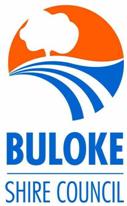
COMMUNITY GRANTS AND SPONSORSHIP - GUIDELINES 2013-14
|
COMMUNITY GRANTS PROGRAM (One funding round per annum – applications close the last day of February each year)
|
|
|
Organisation Support |
Up to $3,000 |
|
Project Support |
Up to $5,000 |
|
Small Capital Infrastructure |
Up to $5,000 (Applicants must make a 20% financial cash contribution towards the project.) |
|
Major Capital Infrastructure |
Between $5,000 and $20,000 (Applicants must make a 50% financial cash contribution towards the project.) |
|
SMALL GRANTS (Two funding rounds per annum – applications close 30 November and 31 May each year)
|
|
|
Small Grants |
Up to $500 |
|
SPONSORSHIP (Applications considered as received) |
|
|
Sponsorship |
Negotiated value Applications $250 and under are assessed and approved by Council Officers Applications over $250 are assessed by Council Officers before being endorsed by Council.
|
|
NOTE: The total amount available for each Funding Type will be set by Council annually as part of the Budget process. Once the available funds are expended no further grants will be available. |
|
Contents
POLICY STATEMENT
KEY PRIORITIES FOR GRANTS AND SPONSORSHIP
Program objectives
TARGET GROUPS FOR GRANTS AND SPONSORSHIP
GRANT TYPES AVAILABLE
Grants
Sponsorship
Donations
GRANT CATEGORIES AND FUNDING AVAILABLE
APPLYING FOR A GRANT
Who can apply?
Who can’t apply?
Ineligible activities
GRANT CATEGORIES UNDER THE COMMUNITY GRANTS PROGRAM
Organisation Support Grants
Project Support Grants
Support provided for all events
Capital Infrastructure Grants
Small Capital Infrastructure Grants
Major Capital Infrastructure Grants
Advice to Applicants for Small and Major Capital Infrastructure Grants
SMALL GRANTS PROGRAM
How do I submit my Small Grant application?
Contacts
SPONSORSHIP
What is sponsorship?
What will Council support under sponsorship?
How to apply for sponsorship
Assessment criteria for sponsorship
Agreement on sponsorship terms
For more information about sponsorship
SUBMITTING AN APPLICATION UNDER THE COMMUNITY GRANTS AND SPONSORSHIP PROGRAMS
Planning your application
Preparing the application
How do I submit the application?
Information privacy and personal information
ASSESSMENT UNDER THE COMMUNITY GRANTS AND SPONSORSHIP PROGRAMS
Assessment criteria
Assessment process
Managing risk
Decision-making
Notification
GRANT CONDITIONS
Insurance
Compliance with the Planning and Environment Act, Local Laws, Food Act and Places of Public Entertainment Requirements
ABN and GST
Acquittals and reporting
SUPPORT AND ASSISTANCE
Contacts
COMMON QUESTIONS AND TERMS
Frequently asked questions
Glossary of terms
APPLICATION AND ACQUITAL FORMS
POLICY STATEMENT
The objective of this policy is to provide a consistent process for Buloke Shire Council to allocate funds for the purpose of operating a Community Grants Program that is within the financial means of Council.
Council acknowledges that the provision of grants to community organisations and individuals is an important role for local government, and is an essential way in which Council can directly support the local community.
The Community Grants Program is based on a philosophy of partnership whereby Council recognises the vital role that individuals, community groups and organisations play in contributing to the creation of a vibrant and sustainable Shire. In return, Council provides a range of grants to encourage and support individuals and groups in the community to engage in activities that advance the quality of life in Buloke.
Council will apply appropriate, transparent and ethical management practices to its grants program to ensure that there is a balance between the responsible administration of public funds and supporting the community in a practical and effective manner.
Council receives many requests for financial assistance from individuals, community groups and organisations. The value of these requests, including requests for in-kind assistance, has grown in recent years to now be in excess of $400,000, which represents more than 4% of the revenue Council receives annually from rates and charges. Continuing growth in the demand for grant and in-kind services is not sustainable.
The growth in requests for assistance, combined with changing community attitudes towards the need for open and transparent decision-making by governments has led to the development of this policy.
Requests for assistance come in a wide variety of forms and can include:
· requests for assistance with administrative costs
· cash donations as part of fund-raising activities
· in-kind support such as:
o assistance with the cost of using Council-owned buildings such as community/public halls, including requests for Council to waive hire charges
o road closures (liaison with other agencies such as VicRoads, supply, erection and removal of temporary barriers and signs)
o supply of waste and recycling bins
o assistance with events (litter collection, access to facilities, additional cleaning, etc.)
o out-of-hours access to facilities
o use of specialist equipment
o additional services (supply of materials, additional cleaning, signage, etc.)
o payment of insurance for assets not owned by Council or under the control of Council
o assistance with the cost of caretaking services
· sponsorship
· prize money
· assistance with the cost of awards
· waiving of fees for:
o rates and charges, such as the fire service property levy
o hall hire
o waste disposal costs
o statutory fees
· photocopying
· assistance with capital purchases
· contributions to project costs.
This policy is intended to provide a basis for Council to allocate funds for community purposes in an effective and equitable manner, based on the individual merits of each request.
The Community Grants Program is also a way of empowering communities to apply for funding to progress and improve their local area through planned assistance and equitable distribution of Council funding while addressing the priorities in their community plans.
Council will make an annual allocation to this program, the level of which will depend on relevant annual budgetary constraints.
In making this policy Council acknowledges that it will have an impact on a number of community organisations that have received financial and/or other assistance from Council on an ongoing basis over a number of years. These organisations will now need to apply for funding on an annual basis and their applications considered on the same basis as those received from other organisations.
In making this policy Council has determined to exclude the organisations listed below from having to make an application for funding under these guidelines on the basis that it has previously resolved to provide funding for specific purposes, or has entered into separate funding agreements.
Organisations affected by this exclusion, the amount of the annual grant to be made available to them, and the purpose for which the grant is to be used is shown in the table below.
|
Organisation |
Amount of Grant ($) |
Purpose of Grant |
|
Nullawil Recreation Reserve Committee of Management |
22,000 |
Maintenance and support of recreation facilities in Nullawil |
|
Sea Lake Community Complex Inc. |
39,000 |
Maintenance and support of recreation facilities in Sea Lake |
|
Wycheproof Recreation Reserve Committee of Management |
33,100 |
Maintenance and support of recreation facilities in Wycheproof |
|
Watchem Progress Association Inc. |
4,500 |
Maintenance and support of recreation facilities in Watchem |
|
Culgoa Recreation Reserve Committee of Management |
6,500 |
Maintenance and support of recreation facilities in Culgoa |
|
Nandaly Hall and Recreation Reserve Committee of Management |
5,000 |
Maintenance and support of recreation facilities in Nandaly |
|
Charlton Parks Committee |
36,400 |
Maintenance and support of recreation facilities in Charlton |
|
Donald Recreation Reserve Committee of Management |
43,700 |
Maintenance and support of recreation facilities in Donald |
|
Birchip Leisure Centre Inc. |
32,100 |
Maintenance and support of recreation facilities in Birchip |
|
Berriwillock Progress Association Inc. |
6,500 |
Maintenance and support of recreation facilities in Berriwillock |
Charlton Forum |
1,000 |
General administration |
|
Birchip Forum |
1,000 |
General administration |
|
Advance Sea Lake Inc. |
1.000 |
General administration |
|
Berriwillock Progress Association |
1,000 |
General administration |
|
Culgoa Development Group |
1,000 |
General administration |
|
Donald 2000 Inc. |
1,000 |
General administration |
|
Wycheproof Vision Inc. |
1,000 |
General administration |
|
Nandaly Progress Association |
1,000 |
General administration |
|
Nullawil Progress Association |
1,000 |
General administration |
|
Watchem Progress Association |
1,000 |
General administration |
|
Watchem Lake Committee of Management |
4,300 (Caretaker allowance) 1,800 (Est. water allowance) |
50% of the cost of annual recreational water allocation to maintain water levels at Watchem Lake. (Amount subject to finalisation following Government determination of the cost of recreational water supply.) |
|
Tchum Lake Aquatic Club Inc. |
4,300 (Caretaker allowance 4,120 (Est. water allowance) |
50% of the cost of annual recreational water allocation to maintain water levels at Tchum Lake. (Amount subject to finalisation following Government determination of the cost of recreational water supply.) |
|
Green Lake Committee of Management |
4,300 (Caretaker allowance)
Water allowance not known |
Water allocation to Green Lake has been temporarily suspended due to high loss of water loss through seepage. When water supply is recommenced the same arrangements as those that apply to Watchem Lake and Tchum Lake will apply. |
|
Wooroonook Lake |
4,300 (Caretaker allowance)
Water allowance not known |
Wooroonook Lake has been at capacity following the September 2010 and January 2011 flood events. When top up water is required the same arrangements as those that apply to Watchem Lake, Tchum Lake and Green Lake will apply. |
|
Folletti Caravan Park |
470 (Est.) |
50% of the cost of annual recreational water allocation to maintain water levels at Folletti Caravan Park Lake. (Amount subject to finalisation following Government determination of the cost of recreational water supply.) |
Grants made available to the organisations listed above for the support of recreation reserve based activities are based on a detailed analysis of costs undertaken by an external consultant in 2006. The allocations have not been reviewed since 2006 but will be subject to review in 2013/14 and will thereafter be reviewed by Council at least once every three years, or as circumstances change, as part of the Budget process.
While the organisations listed in the table above will not need to make an application to receive the funds allocated to them under this program they will be required to meet full acquittal requirements.
KEY PRIORITIES FOR GRANTS AND SPONSORSHIP
Buloke Shire Council currently provides financial assistance to support local community organisations and individuals to undertake projects and activities for the benefit of the Buloke community. Projects and activities that have received assistance in the past include arts and cultural heritage, environment, community development, enterprise development, recognition of personal excellence, personal development, sports development and recreation.
Previous processes have been effective, but there is a need to ensure that the opportunity to receive assistance is opened up to everyone in the community and that decisions made to allocate funds are made in a consistent, equitable, open and transparent manner.
The program has been designed to ensure all applications for funding assistance from Council go through a competitive process and that processes and procedures to allocate available funds are equitable, open and transparent to the general community and to organisations and individuals seeking financial assistance through Council.
Program objectives
The program is designed to meet and respond to Council’s objectives and priorities as outlined in the Council Plan.
|
Council Plan 2013-2017 Outcome Areas
|
|
Our Community
A Buloke community where people of all ages, backgrounds and abilities are embraced and supported and can access the Council services they need to help live healthy and fulfilling lives.
A Buloke community connected and involved in shaping decisions that affect them.
|
|
Our Local Economy
A local economy in which the contribution of the agricultural sector and business sector is recognised and their continued growth actively encouraged and supported.
A local economy in which new business is actively encouraged; investment welcomed; employment created; business skills developed and local networks are supported.
|
|
Our Built Environment
A Shire planned to meet the current and future needs of the agricultural sector and town based residents while maintaining and enhancing its built environment.
A Shire where roads, drains, public spaces, community facilities, parks and other essential infrastructure are fit for purpose, well maintained and contribute to the wellbeing of the community.
|
|
Our Natural Environment
A Shire working with the community to reduce our carbon footprint: protect and enhance the natural environment and share experiences and information.
|
|
Our People and Organisation
An organisation that is responsive to the evolving needs of the community.
An organisation that is responsibly governed with a strong emphasis on sustainable financial and risk management.
An organisation that values and supports the development of its people and is an employer of choice.
An organisation committed to active communication and engagement with our community. |
Aspiring to the objectives set out in the Council Plan enables Council to contribute to the community by:
· assisting community organisations to provide local services
· empowering community organisations and building capacity
· building community infrastructure
· encouraging and supporting volunteers
· assisting disadvantaged/vulnerable groups
· providing cost-efficient local initiatives
· increasing leverage to gain additional funds for local services and activities from state and federal departments and the philanthropic sector
· increasing employment and boosting the local economy
· creating identity, a sense of place and celebration
· contributing to a sustainable environment
· supporting a robust community life.
Applicants to the Community Grants Program are required to align their project with one or more of these program objectives to be eligible for funding.
Alignment with the Council Plan is one of the evaluation criteria used in assessing grant applications.
TARGET GROUPS FOR GRANTS AND SPONSORSHIP
Applicants for grants under this program, whether individuals, organisations or teams, must be:
· either based within Buloke, or proposing an activity/project that is focused on people who live within the Shire or which builds on an activity/event that is held in the Shire
· not-for-profit, or be sponsored by a not-for-profit organisation that will accept legal and financial responsibility for the administration of any funds provided through this program
· able to demonstrate their ability to deliver the activity/project that they apply for
· able to demonstrate administrative and financial accountability through the availability of minutes of meetings and annual financial statements or provide relevant documentation in support of their application
· capable of completing the required grant application forms within the timelines adopted by Council
· able to acquit the funds received at the end of the activity/project.
Only one successful application can be submitted by an organisation, or individual, per grant category within a twelve-month period, except for Small Grants (up to $500), where one successful application can be submitted every six months.
The following are ineligible to apply for grants:
· individuals (individuals may be eligible to apply for sponsorship; refer to later sections of these guidelines for details)
· organisations:
o operating for commercial purposes (e.g. organisations wishing to use Council facilities to sell goods or services directly to the community)
o seeking funding for insurance (public liability, fire and theft, natural disaster, fraud, director’s liabilities, etc.)
o seeking support for ongoing operational and/or administrative costs
o seeking the remission of rates, waiving of garbage charges or remission of the fire service property levy
o putting forward proposals which may lead to a continued dependence upon Council funds
o which are government or semi-government bodies (e.g. hospitals and libraries)
o which are public and private education institutions (e.g. primary, secondary and independent schools, or tertiary institutions)
o which are political parties
o requesting retrospective funding for monies that have already been spent
o raising funds that will be distributed to other persons and/or third parties in the form of a donation or gift, including general donations to charities
o proposing activities/works that are the responsibility of other government bodies.
A full list of eligibility criteria is set out later in this document.
GRANT TYPES AVAILABLE
Council provides financial assistance in a number of ways and it is important for applicants to understand the differences between the types of grant programs on offer to ensure they are applying under the correct funding category.
Grants
A grant is money or goods provided to recipients through formally recognised programs for a specific purpose and outcome.
Grants involve a competitive process in which applications are assessed against a set of criteria and funding is determined against quality of the application; merit of the project; and available funding.
Grants should not be relied on as a continual source of income and instead are considered an aid in the development of projects or activities.
CASH contributions, 20% of the project cost for applications less than $5,000 and 50% of the project cost for applications more than $5,000, are required from applicants to be eligible for capital grants. Please note: This contribution is cash only. In kind contribution is additional to this amount.
Sponsorship
Sponsorship involves Council providing a financial contribution or in-kind support to an event, project, service or activity, in return for agreed commercial and other benefits.
Sponsorship is regarded as a business transaction because it involves an exchange that has a measurable value to each party in commercial, communication or philanthropic terms.
Sponsorship provides financial or value in-kind support to individuals and organisations providing tangible and measurable commercial benefits to Council and the community.
Donations
Donations are no longer supported as they are discretionary with no agreed outcome or expected return.
Groups that have previously sought donations are encouraged to contact the Community Development Officer to discuss their needs and see whether the request is suited to a grant or sponsorship application instead.
GRANT CATEGORIES AND FUNDING AVAILABLE
Funding is available for a wide range of projects under the following categories:
|
FUNDING TYPE |
Maximum funding available per application |
|
COMMUNITY GRANTS PROGRAM (One funding round per annum – applications close the last day of February each year)
|
|
|
Organisation Support Grant (Assistance with strengthening the capacity and capability of local organisations through improvements to administration, volunteer recruitment, volunteer training, governance training, financial management, grant writing, etc. Can include contributions to offset hall hire, Council assistance etc.)
|
Up to $3,000 |
|
Project Support Grant (Assistance with the organising and management of an event, activity and/or exhibition, specific local self help project, local history publication, seed funding, etc. Can include contributions to offset hall hire, Council assistance etc.)
|
Up to $5,000 |
|
Small Capital Infrastructure Grant (Assistance with the purchase of small capital items such as office equipment, computers, chairs, tables, small electrical equipment, catering equipment, sports equipment, display cabinets, archival materials, etc.)
|
Up to $5,000 1. Applicants must make a 20% financial cash contribution towards the project. 2. Applicants can only make one successful application in every twelve-month period. |
|
Major Capital Infrastructure Grant (Assistance with capital improvements to facilities or with the development of new facilities. Grant funds may be used to leverage funds from other sources as appropriate and as provided for as part of other grants based programs.) |
Between $5,000 and $20,000 1. Applicants must make a 50% financial cash contribution towards the project. 2. Applicants can only make one successful application in every three-year period. |
|
|
|
SMALL GRANTS (Two funding rounds per annum – applications close 30 November and 31 May each year) |
|
|
Small Grants (Assistance to individuals to attend events, conferences etc. outside of the Shire, including representation in international, national and state sporting and cultural events. While the focus is on individuals it is expected that recipients will be able to demonstrate active involvement in the community and/or local activities. Applicants will need to be endorsed by a local community, cultural or sporting group.) |
Up to $500 |
|
|
|
SPONSORSHIP (Applications are considered as they are received until available funding is expended) |
|
|
Sponsorship (Assistance with local events and activities. Sponsorship of individuals, teams and groups to participate in sports and cultural events. Can include contributions to offset hall hire, Council assistance etc.) |
Negotiated value 1. Applications $250 and under are assessed and approved by Council Officers 2. Applications over $250 are assessed by Council Officers before being endorsed by Council. |
|
NOTE: The total amount available for each funding type will be set by Council annually as part of the Budget process. Once the available funds are expended no further grants will be available. |
|
The information provided under the various funding type descriptions above does not preclude consideration of other types of applications. Applicants considering lodging an application are encouraged to discuss their application with the Community Development Officer prior to completing the application form.
Grant applicants are encouraged to also seek funds from other sources and for those other sources to also make financial and/or in-kind contributions. All in-kind contributions are additional to the 20% and 50% applicant contribution to Capital Infrastructure grants.
Contributions may be in cash, assistance from other funding agencies, or “in kind” such as voluntary labour or materials.
The number of applications approved and the value of grants and sponsorships awarded each year will be at Council’s discretion, reflect the strength of the applications received, the particular needs of the Shire as a whole and the alignment of applications received with the Council Plan.
The total amount available to Council for distribution through the Grants Program may vary from year to year as its financial position allows.
Council reserves the right to offer applicants a smaller grant than applied for if considered appropriate or if sufficient funds are not available.
APPLYING FOR A GRANT
Who can apply?
Applicants for grants must:
· be a not-for-profit organisation
· be an incorporated group or organisation, or be sponsored (auspiced) by an organisation that will accept legal and financial responsibility for the administration of any funds provided through this program
· be able to demonstrate effective management skills and be financially accountable through the availability of minutes of meetings and annual financial statements
· lodge an application with full budget details as required in the Application Forms and within the timelines as adopted by Council on an annual basis
· demonstrate that suitably qualified and/or experienced people are involved in the project
· be able to make a reasonable co-contribution and/or attract other funding or sponsorship to the project
· be locally based (proposed activities must be offered within the Shire and/or target residents from within the Shire)
· provide a Certificate of Currency for appropriate Public Liability Insurance
· not duplicate or overlap with existing similar activities
· contribute towards the objectives set out in the Council Plan 2013-2017.
Organisations may choose to apply for funding for a number of projects but may only submit one application under each category per round.
All projects must be conducted in the Buloke Shire Council area.
Only one successful application can be submitted by an organisation or individual per category within a twelve-month period, except for Small Grants where one successful application can be submitted each six-month period.
Who can’t apply?
The following are ineligible for grants:
· individuals (individuals may be eligible to apply for sponsorship; refer to later sections of these guidelines)
· organisations that operate for commercial purposes (e.g. organisations wishing to use Council facilities to sell goods or services directly to the community)
· projects or events that are run for commercial purposes
· applicants seeking funding for public liability insurance, fire and theft insurance, disaster insurance, fraud insurance, director’s liability insurance; this includes the payment of insurance for non-Council owned assets (e.g. community halls under the control of committees of management appointed by the Department of Environment and Primary Industry)
· organisations that have not satisfactorily acquitted previous funding applications to Council by the due date
· organisations seeking support for ongoing operational and/or administrative costs
· activities that are the primary responsibility of other funding agencies
· remissions of rates, waiving of garbage charges and remission of the Fire Services Property Levy
· proposals which may lead to a continued dependence upon Council funds
· government or semi-government organisations (e.g. hospitals and libraries)
· public and private education institutions (e.g. primary, secondary and independent schools, or tertiary institutions)
· political parties
· industry peak bodies or organisations that as part of their charter do not provide a direct community benefit
· applicants that have outstanding rates or other debts to Council
· organisations that are currently subsidised by Council through existing service level agreements
· projects requesting retrospective funding for monies that have already been spent
· applicants seeking funding towards any unlawful or irresponsible purpose
· applicants that have not enclosed all required documentation (e.g. ABN, contact details, financial statements, GST status, business plans, etc.)
· applicants seeking funds that will be distributed to other persons and/or third parties in the form of a donation or gift
· works that are the responsibility of other government bodies.
Applicants who are ineligible to apply for a grant are also ineligible to sponsor an applicant.
In addition, organisations who have received funding in one grant category for three consecutive years will be ineligible to apply in that category the following year. This is to ensure money is available to as many organisations as possible and that no organisation becomes dependent on Council for its existence.
Ineligible activities
The following activities are ineligible for funding:
· events for fundraising purposes where proceeds will be provided to a third party
· events of a political nature or which incorporate political activities
· events operated for commercial purposes
· day-to-day operational funding for an organisation, including staff wages and insurances
· projects which begin before grants are awarded (no grants will be awarded retrospectively)
· payment of debts
· recurrent or ongoing projects
· projects that have been previously funded
· projects considered the core responsibility of other levels of government
· events or activities in conflict with Council policy
· prize money
· events or activities that have the same or similar outcome that have been funded under other programs including sponsorship.
If any other support is sought from Council, such as in-kind, or other services in relation to the project an applicant is applying for then this must be identified in the application and Council notified, as this may be taken into account in assessment of the application.
GRANT CATEGORIES UNDER THE COMMUNITY GRANTS PROGRAM
Organisation Support Grants
Grants up to $3,000 are available for eligible organisations to fund management and planning costs associated with becoming more sustainable and improving capacity to deliver services.
Applicants can make more than one application per year but in the event they are successful, will only receive funding for one application.
To be eligible to reapply in a subsequent year applicants will need to ensure previous grants have been properly acquitted.
As indicated earlier, existing Township Forums/Progress Associations operating in the Shire will be automatically eligible for an annual grant of up to $1,000 under this category. These organisations will not need to make application in order to receive these funds, but will still need to meet acquittal requirements.
Council has also determined, as part of its annual budget process, to make a specific allocation of $5,000 to the celebration of Australia Day across the Shire. Existing Township Forums/Progress Associations can apply for up to a maximum of $500 to assist with the celebration of Australia Day in their town/district from this allocation. Applications from other organisations for Australia Day activities to be held in conjunction with those organised by the relevant Township Forum/Progress association will be considered.
Council has also agreed to make Council facilities available free of charge to local RSL sub-branches for the purpose of holding ANZAC Day celebrations. Local ANZAC Day organising committees will not need to make an application for a grant but will be required to advise Council at least six weeks in advance if they are likely to require access to facilities for their celebrations. This includes notification that facilities may only be required in the event of poor weather conditions.
Applicants for Organisational Support Grants are eligible to apply for funding for one or more of the following initiatives:
· education and training (particularly for volunteers)
· recruiting, maintaining or recognising volunteers
· planning and governance which may include strategic plans, constitution reviews or board appraisals
· grant writing assistance for major funding applications outside of Council’s Grants Program
· seeding funds for new organisations less than three years old (e.g. for advertising, printing, office stationery, software).
Examples of projects may include education, training or accreditation of volunteers, supporting activities that recognise or maintain volunteers, business or facility planning. (Please ensure you provide two quotes with your application. Evidence to support the relevance and community benefit of your application is encouraged.)
NOTE: ONLY community organisations based in Buloke are eligible to apply under this category and projects or activities must not commence before the applicant receives formal written notification on the outcome of the application.
Applicants can apply for funding for equipment under this category but only if they have been unsuccessful in receiving funding for this equipment from another grant funding program. Evidence must be provided to demonstrate the application was unsuccessful.
Applicants can also apply for ‘Grant writing assistance’ under the Organisation Support category to engage a grants writer to apply for external funding.
Where relevant, two quotes should be provided with an application. Evidence to support your application is encouraged.
An application form for an Organisation Support Grant is available from Council’s website at www.buloke.vic.gov.au or contact Council’s Community Development Officer on 1300 520 520.
Project Support Grants
Grants up to $5,000 are available to support eligible organisations provide specific one-off projects that deliver long-term positive outcomes to the community.
Applicants can make more than one application per year but in the event they are successful, will only receive funding for one application.
To be eligible to reapply in a subsequent year applicants will need to ensure previous grants have been properly acquitted.
Applications for project support grants must:
· have a start and finish date for project delivery
· have a project plan in place detailing how the project will be delivered
· identify specific project objectives and outcomes to be achieved as a result of funding.
Equipment purchases are eligible but applicants must demonstrate these are essential for the delivery of the project. Equipment related items are capped at $1,500 or 30% of the total amount granted (whichever is the lesser).
Examples of projects that may be eligible under this category include: arts projects with young people or older persons, festivals, events, community gardens, community kitchens, performance workshops, revegetation projects or a neighbourhood welcome project.
Support provided for all events
The following support is provided to the organisers of events in Buloke irrespective of whether Council provides a Project Support Grant:
· Liaison with the organisers of events with a view to maximising the benefits for Buloke. (An important part of this role is to encourage the use of local services in preference to suppliers from outside Buloke and to directly link organisers to the various people in Council with whom they may need to liaise. This relates to such areas as road closures, food stall inspection, the provision of barricades, additional cleaning, additional rubbish bins and similar municipal services. NOTE: There will be charges associated with Council providing these services which organisers will be expected to pay.
· Assisting local organisations to bid for regional, state and national events. (This assistance can include the provision of promotional photography and written information on local tourism and other services and attractions, and supplies of any appropriate promotional materials for inclusion with bid documents. There will be no charge for these services.)
· Promotion through Shire publications. This may include:
o inclusion in the regular ‘Community Matters’ publication
o display of promotional materials in Council’s District Offices
o a link posted on Council’s website
o arranging for a Mayoral message to be included in the event program.
Capital Infrastructure Grants
Capital Infrastructure Grants are available to assist eligible organisations build, renovate or refurbish community facilities, including kitchens, toilets and hard-wired technology upgrades.
This category aims to increase and improve community facilities in Buloke.
There is one round of funding available each financial year. Applications for funding under this category close on the last day of February each year. Applicants will be advised of the success or otherwise of their applications by the last day of May.
Applications can be lodged at any time during the year, but will only be assessed in the period March through April of each year. Applications received after the last day of February will be considered for funding in the following financial year. Late applications will not be considered under any circumstances.
Applicants are eligible to apply for a grant from one of the following two categories:
Small Capital Infrastructure Grants
For eligible organisations seeking capital infrastructure works up to $5,000.
NOTE: Applicants must make a 20% cash contribution towards the project.
Only one successful application per organisation is eligible within a twelve-month period for a Small Capital Infrastructure Grant. To be eligible to reapply after this period, applicants must ensure that any previous grant has been successfully acquitted.
To apply for a Small Capital Infrastructure Grant, applicants must complete a full application and submit all relevant information.
Applications must be submitted by the last day of February each year.
An application form for a Small Capital Infrastructure Grant is available from the Council’s website at www.buloke.vic.gov.au or you can contact the Community Development Officer on 1300 520 520.
Major Capital Infrastructure Grants
For eligible organisations seeking capital infrastructure works of between $5,000 and $20,000.
NOTE: Applicants must make a 50% cash contribution towards the project.
Only one successful application per organisation is eligible within a three-year period for a Major Capital Infrastructure Grant. To be eligible to reapply after this period, applicants must ensure that any previous grant has been successfully acquitted.
To apply for a Major Capital Infrastructure Grant, applicants must initially submit an Expression of Interest (EoI) application form outlining the scope of the works.
An assessment is carried out on the EoIs to determine a shortlist of applicants who are invited to submit a formal application.
The successful EoIs from this process will receive support from the Community Development Officer and a member of Council’s Asset and Infrastructure Project Management Team to prepare a formal Major Capital Infrastructure Grant application.
Applications must be submitted by the last day of February each year.
An application form for an Expression of Interest for a Major Capital Infrastructure Grant is available from the Council’s website www.buloke.vic.gov.au or you can contact the Community Development Officer on 1300 520 520.
Advice to Applicants for Small and Major Capital Infrastructure Grants
Applicants for grants from these two categories are encouraged to view Council as just one of a number of contributors to the project.
In-kind contributions based on the assessed cost of volunteer labour, free goods or services and in-house labour costs, are eligible components of application process. A methodology for calculating in-kind contributions is provided in the application forms. As indicated earlier, in-kind contributions cannot be counted as part of the cash contribution required to meet the eligibility criteria for these two grant categories.
Applicants under these two categories must provide evidence they have secured, or are able to secure, the funding required to deliver the project.
The project must also be “shovel ready” and all necessary permits and approvals obtained either before an application is submitted, or the applicant can demonstrate that all required permits/approvals are likely to be issued if the application is successful. Council staff are available to assist with these processes and organisations proposing to submit applications are strongly advised to contact the Community Development Officer on 1300 520 520 to arrange a pre-project meeting before an application form is completed. The Community Development officer can direct applicants to the relevant Council Officers or government departments.
Applications for both Small and Major Capital Infrastructure Grants will go through an assessment process.
The assessment of applications for both categories of grant will take into account the extent of co-contributions for the proposed project.
As part of the assessment process, applicants may be contacted by Council Officers to seek more information, provide advice on improving an application or to arrange site visits.
Applicants must:
· meet the cash contribution requirements associated with the relevant grant type
· have a legal right to conduct works on the proposed site and have a registered lease or permit to occupy for a minimum three-year period.
· secure all permits and approvals required to conduct works; these approvals should be obtained or in progress prior to submitting your application; if you do not need any approvals you will need this confirmed in writing
· have appropriate site or works plans considering impacts and accessibility to other users and residents as a result of the works
· have an established budget containing sufficient funds to cover all costs, not just building works
· ensure only licensed contractors undertake works related to the project
· have a facility management plan or an identified need for the project in a strategic plan or other document
· if occupying Council-owned buildings or operating on land owned by Council or under the control of Council, comply with Council’s Procurement Policy when engaging contractors and purchasing materials and services. (Members of Council’s Purchasing Department are available to provide advice and assist with these processes.)
The statements above should be regarded as pre-conditions to the assessment of any application. Failure to comply with any of these pre-conditions may result in your application being eliminated from further consideration.
As indicated above, applicants may require a planning permit under the Planning and Environment Act and/or other permits (i.e. Local Laws) and approvals under federal and state legislation. The nature of your project and its location will determine the type of approvals required and it is the responsibility of applicants to ensure these approvals are in place prior to project commencement. Applicants who have these approvals in place at the time of application will be considered favourably. Project costs should include the cost of all permit applications including those under the control of Council.
Ineligible capital works include:
· maintenance of a Council facility where the responsibility of maintaining the facility lies with the lessee, including but not limited to, painting and day-to-day maintenance to ensure the general upkeep of the building or facility
· purchase of land, existing buildings or facilities
· operational costs
· building work and professional fees not incurred in relation to a project
· repair or redevelopment of facilities damaged by fire, explosion, vandalism, flood (except projects impacted by floods in areas declared by the Natural Disaster Relief and Recovery Arrangements (NDRRA)), storm, or other natural disaster where the facility should be covered against that type of damage by insurance.
Receiving funding under either the Small or Major Infrastructure Grant categories does not guarantee that future stages of a funded project will also be funded. For instance, if an application for funding for the first stage of a three-stage project is successful this does not guarantee that Council will provide funding for the next two stages.
Supply of equipment such as furniture, decorations and fittings, which are related to the works, are eligible up to $3,000 or 30% of the total amount granted (whichever is the lesser amount).
Projects or activities must not commence before you receive formal notification on the outcome of your application.
Applicants will receive written notification of the success or otherwise of their applications.
Successful applications may at Council’s discretion be required to enter into a progress payment schedule that will be outlined in the final funding agreement. Also, funding may only be provided once certain conditions are met.
SMALL GRANTS PROGRAM
Grants are available to eligible organisations and individuals based in Buloke for amounts of up to $500.
Applications can be submitted at any time throughout the year but announcements as to the success or otherwise of applications received are made in December (applications received between 1 June and 30 November) and June (applications received between 1 December and 31 May) of each year.
Applications that are not successful will not be held over.
Applicants who have been unsuccessful may resubmit an application to be considered in the following funding round.
Funding under the Small Grants Program provides small amounts of assistance for, for example, sponsorship, equipment or incidental items.
All projects must be conducted in Buloke and individuals must reside in Buloke.
Organisations or individuals who receive funding under this category for three consecutive years will be ineligible to apply in that category the following year.
Projects or activities must not commence before formal notification of the outcome of an application is received.
Applicants will be notified of funding outcomes in December and June of each year.
Individual Excellence Grants are also available to support Buloke residents to compete in major sporting and other competitive events, including for music/dance, debating, leadership development, etc. Teams can only apply for one grant.
The following criteria apply to applications for Individual Excellence Grants:
· International Competition: Up to $500 for individuals who have been selected to attend an internationally recognised event to represent Australia
· National Competition: Up to $250 for individuals who have been selected to attend nationally recognised events to represent Victoria or who are competing at national events after winning a state competition
· Supporting documentation such as confirmation of selection or attendance from the relevant body must be supplied
· Only one successful application per person is eligible within a six-month period. To be eligible to reapply after this period, applicants will need to ensure any previous grant has been successfully acquitted. Proper acquittal is required by the submission of receipts for any expenditure.
The Small Grants Program will not operate during the six-month period prior to a general election of councillors. The program will re-open after the election results have been published.
How do I submit my Small Grant application?
An application for a Small Grant is available from Council’s website www.buloke.vic.gov.au or you can contact the Community Development Officer on 1300 520 520 for an application form.
Applications can be submitted as follows:
· Hand deliver your application to: any of Council’s District Offices (Wycheproof, Charlton, Birchip, Donald and Sea Lake)
· Post your application to:
Chief Executive Officer
Buloke Shire Council
PO Box 1
Wycheproof VIC 3527
· Email your application to: buloke@buloke.vic.gov.au
Contacts
If you need any information about the Small Grants Program, please contact the Community Development Officer on 1300 520 520.
SPONSORSHIP
Council has been sponsoring local groups and individuals for many years through cash donations, in-kind support and advertising in catalogues and souvenir programs.
Council provides support to large and small projects/events all over the Shire ranging from sports to the arts, and awards celebrations to promotion of the local economy.
The purpose of the Sponsorship Program is to help promote a strong and involved Buloke community by helping deliver successful local events, projects, services and other activities.
NOTE: Applications for sponsorship can be submitted at any time throughout the year.
What is sponsorship?
Sponsorship provides financial or value in-kind support to eligible individuals and organisations providing tangible and measurable benefits to Council and the community.
Sponsorship is a business transaction in which Council provides a financial contribution, or value in-kind support, for an event, project, service or activity, in return for agreed commercial and other benefits. It’s called a business transaction because it involves an exchange that has a measurable value to each party in commercial, communication or philanthropic terms.
For example, sponsorship benefits in return for a financial or value in-kind contribution may include featuring Council’s logo in project signage, promotional material or advertising, public acknowledgements in speeches and media materials, invitations to participate in an opening ceremony, or including materials in information packs.
What will Council support under sponsorship?
Council is committed to protecting our diverse natural environment, maintaining our quality lifestyle, and attracting and supporting businesses that complement our environmental values and lifestyle while providing sustainable jobs for the community and thoughtful planning for population growth.
Before applying for sponsorship please ensure that the sponsorship request is for a project that will help support one or more of Council’s strategic priorities as listed earlier. If more information is required about Council’s strategic priorities, refer to the Council Plan 2013-2017 at www.buloke.vic.gov.au.
Applicants should address how their event or project will align with one or more of these priority areas.
The Sponsorship Program is open to all local, regional and national groups, businesses and individuals who meet the selection criteria and can demonstrate a benefit to the Buloke community.
The amount available for distribution as sponsorship will be determined by Council annually as part of the Budget process. Once the funds allocated to sponsorship activities for a particular year are fully committed no further applications will be considered.
Buloke Shire Council will only engage in sponsorship where it will assist in achieving the following outcomes:
· supporting Council’s goals and objectives
· increasing the effectiveness of Council’s strategic programs
· communicating key messages to target audiences
· enhancing Council’s public image and reputation.
Council will not sponsor the following:
· activities that compromise public confidence
· initiatives and/or events which compete or conflict with Council activities
· individuals or political parties
· organisations or events where the funds made available would be used to provide sponsorship or grants to third parties.
How to apply for sponsorship
Council’s preference is to receive and decide applications annually; however it will receive and consider applications throughout the year.
All applications for sponsorship must be received at least three months prior to the project launch or event.
While we endeavour to finalise sponsorship approvals quickly, it can take several weeks to process requests, particularly in the case of requests over $250.
Assessment criteria for sponsorship
All applications will be initially assessed by the Community Development Officer against the following stage one criteria. Initial assessment involves determining whether the application is:
· consistent with the objectives and strategic priorities set out in the Council Plan
· provided in writing with sufficient detail to make a detailed assessment
· lodged with sufficient time for a decision to be made
· not in conflict with legal requirements or Council and community legal and ethical standards
· not controversial
· not likely to adversely affect Council’s image.
If the proposal fails to meet these criteria, a letter of refusal will be sent outlining the reasons.
If additional information is required, the Community Development Officer will liaise with the applicant to obtain the extra information.
Once all relevant material has been received and the initial assessment completed successfully, the Community Development Officer will assess the application against the following stage two criteria and prepare a report with recommendations to the Chief Executive Officer (for applications under $250) or to the Council (for applications over $250):
· alignment with the objectives and priorities in the Council Plan (10%)
· value for money with regard to commercial and other benefits (10%)
· track record of organisers regarding financial administration, general management and budget preparation (10%)
· extent of financial and other support from other organisations (10%)
· demonstrated ethical behaviour and fair dealing (10%)
· promotion of Buloke to people attending the festival/event (Research has shown that perceptions of townships and facilities are driven by exposure and knowledge of what is available and on offer. There is no better way of improving the positive perceptions of the Shire and its facilities than having people visit for an enjoyable and memorable experience and the opportunity to experience our hospitality.) (10%)
· media exposure (This can include print, radio, television, social media and the web. The benefits of media exposure are similar to those arising from direct exposure of visitors to events. Media exposure is potentially more powerful because of the large volume of numbers that can be reached.) (10%)
· reinforcement of Buloke as a destination for people seeking to make a ‘tree change’, ‘grey nomads’ and socialgroups looking for an event destination. This doesn’t mean that if there is no benefit from events that don’t conform to this theme they will not be considered for funding, but it is a factor that will be considered when assessing the benefits of sponsoring an event.) (10%)
· direct economic multipliers generated by visitors and locals attending events. (Visitors come and spend money on accommodation, entertainment, petrol, etc. Organisers of events use local suppliers for event operations.) (10%)
· Giving local residents additional entertainment choice and recreational opportunities, and creating a more dynamic, energetic and interesting local lifestyle. (10%)
A request for sponsorship must score against at least five of these criteria for it to be recommended to Council, or where applicable the Chief Executive Officer, for determination.
Agreement on sponsorship terms
If an application is successful, the applicant will be contacted by Council to confirm the terms of sponsorship.
A sponsorship agreement will be sent to the applicant, setting out agreed terms and advising that they should report back to Council on how the conditions of the sponsorship were met. A typical sponsorship agreement will include reference to the following matters:
· the level of Council sponsorship both direct and in-kind
· the promotional exposure that the organisers will be required to provide for Buloke
· guidelines for the use of the Council logo (if applicable)
· details of any written material referring to Council (material generally to be submitted in draft prior to being submitted for print production)
· confirmation of the availability of Council promotional materials such as banners
· contact details of the relevant Council Officer for ongoing liaison between Council and the organisers
· any additional requirements set by Council.
Once a signed agreement is received the sponsorship payment will be made.
Council will work closely with successful applicants to ensure sponsorship progresses smoothly.
Projects or activities must not commence before an applicant receives formal notification on the outcome of their application.
Applicants will receive written notification of the success, or otherwise, of their application.
For more information about sponsorship
For an application form, go to www.buloke.vic.gov.au or contact the Community Development Officer on 1300 520 520.
SUBMITTING AN APPLICATION UNDER THE COMMUNITY GRANTS AND SPONSORSHIP PROGRAMS
Planning your application
· Read the program guidelines to determine whether the organisation and project is eligible for funding.
· It is important to thoroughly plan the project and identify who will be responsible for the project within your organisation.
· Undertake research to check that the project is not duplicating a similar or existing program.
· Talk about the project with members of the community to obtain advice and support for the application.
· Ensure the project aligns with the program objectives and the strategic priorities for that category.
· Identify any permits, approvals and licences that may be required, as the organisation will be responsible for obtaining these where necessary.
Preparing the application
· Read the program guidelines carefully before completing the application.
· Attend a free Council-run Grant Application Writing workshop to assist in determining the correct category of funding to apply for and the eligibility of the project.
· To develop the project/application, contact the Community Development Officer who can provide advice in developing the project and the application. Feedback will be provided to assist with the timely preparation of the application. This assistance does not guarantee funding.
· Complete the application form and ensure all relevant information and documentation is included. Do not assume Council knows about the organisation or project, as only information contained in the application will be assessed. Refer to the checklist in the relevant application for the documentation required.
· Before submitting the application, provide a draft copy to the Community Development Officer for feedback. NOTE: Feedback on draft applications will not be provided in the week leading up to the closing date for applications (the last day of February each year).
· Ensure you submit the application before the last day of February. The application does not have to be bound or in a display folder, but preferably it should be typed and on the relevant application form.
· Keep a copy of the application and related documents as Council is unable to return submitted documents. NOTE: Handwritten applications that are not on the relevant application form will not be accepted. This is to ensure that the application can be read and accurately assessed.
How do I submit the application?
Applications can be submitted in any of the following ways:
· Online: Visit Council’s website at www.buloke.vic.gov.au. An instruction manual is available to assist you prepare your application.
· Hand deliver the application to: any of Council’s District Offices (Wycheproof, Charlton, Donald, Birchip and Sea Lake)
· Post the application to:
Chief Executive Officer
PO Box 1
Wycheproof VIC 3527
· Email the application to: buloke@buloke.vic.gov.au
NOTE: Only applications submitted through the above avenues will be accepted.
Information privacy and personal information
Council treats all personal information provided as part of a grant or sponsorship application in accordance with the Information Privacy Act 2000 and the Public Records Act 1973.
The information requested on the application form is collected for the purposes of assessing and processing applications and allocating grant and sponorship funding. The information will only be used by Council for that primary purpose and will not be disclosed to any other party except as required by law.
If an organisation or individual fails to provide the requested information the application may not be considered for funding.
ASSESSMENT UNDER THE COMMUNITY GRANTS AND SPONSORSHIP PROGRAMS
Assessment criteria
Eligible applications (those that meet the pre-conditions) will be evaluated and rated against a set of assessment criteria as part of a competitive process.
Each application will be given a score against each criterion by Council assessors. These scores will be added together to produce a total score to determine the allocation of funds. Please note that submitting an application is not a guarantee that the application will be funded.
Assessment criteria for the Grants Program are:
· compliance with all pre-conditions required to make an application (10%)
· ability to achieve one or more of the program objectives listed earlier and as set out in Buloke’s Council Plan 2013-2017 (10%)
· that the project identifies needs and emerging local issues and how it can contribute towards addressing those matters (10%)
· evidence of involving the broader community in the development, planning and implementation of the project (10%)
· that the proposed project budget is realistic and, where possible, demonstrates value for money (10%)
· that the project demonstrates long-term benefits to the community/participants (10%)
· extent to which alternative and complementary funding sources have been explored or secured (10%)
· the level of in-kind contribution, both cash and other, towards the overall cost of the project (10%)
· capacity to undertake all aspects of the project including progress reporting, evaluating outcomes and documenting results (10%)
· ability to sustain the project or its outcomes after Council funding has ceased (10%).
Information provided in each application will be assessed against the above criteria.
Only information that is contained in the application will be assessed.
For Small Grant applications, refer to the assessment criteria set out earlier for Small Grants.
For Sponsorship applications refer to the assessment criteria set out earlier for Sponsorship.
The number of grants awarded and the value of grants will be at Council’s discretion and will reflect the relative strength of applications received, the needs of the Shire as determined by Council through the Council Plan and the availability of funds. Applicants may be offered a smaller grant than they applied for.
Assessment process
Applicants will receive a letter acknowledging receipt of their application within two weeks of the application being received.
This letter will contain a unique reference number which should be quoted when making enquiries about the application.
Nominated Council Officers and assessment panels will assess the application against the specific criteria for the relevant grant (as mentioned above) or sponsorship applied for.
Grants and sponsorship are allocated through a competitive process and should not be relied on as a source of continual funding.
Applications will be approved depending on the funds available, the number of applications received and the program priorities.
Council reserves the right to part-fund an application, make progress payments and instigate special funding conditions.
Incomplete or unsigned applications are ineligible and will not be assessed.
Managing risk
Risk management is an integral part of the effective administration of a grants program.
The importance of appropriate risk management to informing sound grants administration is reflected in principles which focus on achieving the outcomes required in a manner that maximises transparency, accountability and cost-effectiveness from the perspective of both the community and the Council.
Risk management involves the systematic identification, analysis, treatment and allocation of risks, both in relation to the overall design of the Grants Program and in the assessment and, where relevant, administration of individual grants.
Some risks are associated with providing community grants; however there are also a number of opportunities to mitigate any risks which may be encountered.
|
Risk Management Strategies |
|
|
Grant Size: |
· The amount of funding provided and the duration of the project can vary depending on the applicant’s demonstrated capacity to deliver. · This depends upon the applicant’s ability to demonstrate: ® financial management capability, and ® the need for the project to the community. |
|
Spot Audit: |
· Random audits are conducted on 10% of grants and help to identify any potential issues early in the process. · This means that any issues arising can be investigated and support provided to ensure the project is successful. |
|
Objectivity: |
· By ensuring that all applications are assessed through open and transparent processes, the parties are protected. · Any potential conflicts of interest or bias are mitigated. |
Decision-making
An initial assessment of all applications will be completed by nominated Council Officers.
The Officers will assess applications against the relevant criteria for the type of grant or sponsorship being sought.
For sponsorship under $250
The Officers will prepare a report to the Chief Executive Officer or his/her nominee recommending approval or refusal.
The Chief Executive Officer or his/her nominee will review the recommendation and make a final determination.
The Chief Executive Officer will ensure details of all sponsorship approvals are reported to the next Ordinary Meeting of Council.
For Small Grants (up to $500) and sponsorship (over $250)
The Officers will prepare a report to Council recommending approval or refusal and seeking Councillors’ endorsement of the recommendation. The report will be emailed to Councillors with a request for a response within three business days, either endorsing the recommendation or not.
If all of the Councillors, or a majority of Councillors (4), endorse the recommendation the Chief Executive Officer will treat the application as approved. The Chief Executive Officer will ensure details of the grant are reported to the next Ordinary Meeting of Council.
In the event a majority of Councillors (4) do not endorse the recommendation, the Chief Executive Officer will ensure the matter is the subject of a report to the next Ordinary Meeting of Council for determination.
For Organisation Support Grants (up to $3,000), Project Support Grants (up to $5,000), Small Capital Infrastructure Grants (up to $5,000) and Major Capital Infrastructure Grants ($5,000 to $20,000)
The Officers will prepare a report to an Ordinary Meeting of Council recommending approval or refusal for each of the applications received.
The report will advise of the scores achieved against each of the assessment criteria and any other matters considered relevant to the application.
The report will also list applications that were not assessed as they failed to meet the necessary pre-conditions.
The Council’s decision will be final.
Notification
Applicants will receive written notification about the success, or otherwise, of their grant or sponsorship application.
Funding must be used for the purposes it has been provided, unless written permission is obtained to vary the project.
Successful applicants will need to sign a funding agreement and agree to its terms and any special funding conditions and provide an invoice/tax invoice, before payment will be processed.
If an application is not successful, written notification will be provided with feedback on how the application could be improved in future. The Community Development Officer can also be contacted for feedback.
GRANT CONDITIONS
Insurance
It is the applicant’s responsibility to obtain and maintain adequate insurance (including public liability) with a reputable insurer, in relation to activities carried out by the applicant for the project, to guard against any claims for loss or damage to property and injury or death to persons.
Applicants must provide a Certificate of Currency demonstrating appropriate insurance cover as part of their application.
The applicant is also responsible for ensuring a safe work environment in accordance with Occupational Health & Safety (OH&S) standards. Where applicable, the applicant is to obtain and maintain workers’ compensation insurance in accordance with applicable legislation.
Compliance with the Planning and Environment Act, Local Laws, Food Act and Places of Public Entertainment Requirements
Provision of grant funding or sponsorship for events will be dependent on the applicant obtaining all necessary permits as required by the Planning and Environment Act 1987, Council’s Local Laws, the Food Act 1984 and the State Government Places of Public Entertainment requirements.
This may require the completion of other application forms and liaison with several Council departments.
If an applicant does not need any approvals, this will need to be confirmed in writing.
Contact Council’s Community Development Officer on 1300 520 520 for further information.
ABN and GST
Australian Business Number (ABN)
All applicants must have an ABN.
Organisations that have not registered for an ABN will have the withholding tax (PAYG) of 46.5% deducted from their payment if they do not complete a Statement by a Supplier form.
To obtain a form, visit Council’s website www.buloke.vic.gov.au.
To register for an ABN, contact an accountant or visit the Australian Business Register at www.abr.gov.au.
Goods and Services Tax (GST)
Applicants must advise whether they are registered for GST.
GST can affect a grant in the following ways:
· total amount paid for goods and services purchased using the grant funding
· total grant funding approved.
If an application submitted by an organisation that is registered for GST, is successful an additional 10% will be automatically added to the grant amount to cover the GST component. This will ensure no out of pocket expenses for organisations that are registered for GST.
For advice on GST, contact a tax advisor, or the Australian Taxation Office on 13 24 78 or www.ato.gov.au.
Acquittals and reporting
Applicants must acquit funds that have been provided at the completion of the project or activity. This will include providing receipts, invoices, evidence of project expenditure, copies of any relevant media coverage and a written report outlining the activities that were conducted.
For this purpose successful applicants are required to keep all receipts for items purchased. Any unexpended funds must be returned to Council.
Applicants are ineligible to apply for grants under the Grants and Sponsorship Programs if there are any outstanding acquittals.
If a successful grant applicant needs to change or vary the project for which funds have already been approved, the applicant must contact the Community Development Officer to approve a variation to the funding agreement.
For more information or for a copy of an Acquittal Report, go to Council’s website www.buloke.vic.gov.au or contact the Community Development Officer on 1300 520 520.
SUPPORT AND ASSISTANCE
Free Council-run Grant Application Writing workshops are conducted at various times and locations throughout the year to provide information to applicants about the Grants and Sponsorship Programs.
The Community Development Officer is available to identify the most relevant category/ies for an organisation or individual applicant, and to meet with applicants to provide advice in the development of their project/application.
Applicants are strongly encouraged to register for one of the Grant Application Writing Workshops and to seek assistance to ensure their applications meets the objectives of the category they are applying under and to increase the chances of being successful in receiving funding.
Contacts
For any information about Council’s community grants and sponsorships, contact the Community Development Officer on 1300 520 520.
COMMON QUESTIONS AND TERMS
Frequently asked questions
Q. Can I get help with the project and completing the application form?
A. Yes, the Community Development Officer and other Council Officers are happy to assist with the application. In addition, applicants can attend one of the free workshops that are held around the opening of a funding round. For more details, visit Council’s website at www.buloke.vic.gov.au.
Q. Can I submit the application online?
A. Yes, applications can be submitted online through Council’s website at www.buloke.vic.gov.au. The application forms are also available in Word and PDF format on this website. The application form and all relevant supporting documentation can also be hand delivered to one of the Council’s District Offices, posted to Council or emailed to buloke@buloke.vic.gov.au.
Q. Can an application be made if the organisation is not registered for GST?
A. Yes, if the organisation is not required to be registered for GST it will not apply to any grant allocated.
Q. Can funding be obtained for an annual event for longer than one year?
A. No, grants are provided for a funding period of twelve months. In relation to an annual event, an application can be made under the Sponsorship Program each year for the same event however the application must be made under another category as the same project is ineligible for multiple sources of Council funding.
Q. If the application is unsuccessful will it automatically be considered for the next round?
A. No. We strongly advise that the feedback provided about why your application was unsuccessful be considered and attend one of the workshops to enhance the application for future funding.
Q. Can schools apply?
A. No, applications from primary schools, secondary schools and independent schools will not be considered.
Q. Can individuals apply?
A. Yes, individuals can apply under the Councillor’s Small Grants Program. Please refer to the specific criteria and eligibility that applies to this program.
Q. Can an application for equipment be made?
A. Yes, but please ensure the eligibility criteria for equipment under the relevant category is read and understood. The Community Development Officer can advise of other programs for which applications for equipment purchase funding are most likely to be successful.
Q. Will the grant or sponsorship pay for retrospective projects or activities?
A. No, the project or activity must not commence prior to receipt of formal written notification.
Q. Can more than one grant or sponsorship be applied for?
A. Yes, one application per category per round can be submitted but please ensure you read that the guidelines for the organisation’s eligibility and the funding rounds available for that category are read and understood.
Q. The organisation/individual has received a grant under the same category for the last three years. Can funding still be applied for in the next round?
A. No, any organisation that has received funding in one grant category for three consecutive years will be ineligible to apply in that category the following year. This is to ensure money is available to as many organisations as possible and that no organisation becomes dependent on Council for its continued existence.
Q. Can the applicant contribution for Capital Infrastructure grants of 20% under $5,000 or 50% for $5,000 - $20,000 be made ‘in-kind’?
A. No, this contribution is a cash only component.
Glossary of terms
Acquittal - A certified report of financial and outcome transactions relating to a grant.
Capital Infrastructure - The capital works that are separate or ancillary to a fixed building.
Community Capacity Building - Projects that build social capital and provide for the social and recreational needs of the community.
Funding agreement - Contractual terms and conditions in which funding has been approved, which may include special conditions specific to the project or activity.
Grant - Funding that is provided to a recipient on merit against a set of program-specific criteria.
In-kind - Contributions based on barter arrangements, including assessed cost of volunteer labour, free goods or services and in-house labour costs
Minor Capital Works - Projects that create a physical asset with a total value less than $50,000.
Parent organisation - An incorporated organisation that overarches subsidiary groups which may include sub-committees, steering groups or other groups that have an association with the parent organisation.
Sponsoring organisation - An incorporated body that will accept legal and financial responsibility on behalf of a non-incorporated group that is seeking funding for a project or activity that is not represented by a parent organisation.
Township Forums/Progress Associations - Local resident associations owned and run by their members. Any resident within the Shire is entitled to and welcome to become a member of their local township forum/progress association. Township forums/progress associations meet on a regular basis to discuss matters of local concern and to put forward practical solutions. Issues commonly addressed include: traffic and parking, building developments, heritage conservation, street lighting, graffiti, footpaths, the viability of local shopping areas, street trees, parks and sporting facilities. They often communicate their concerns and suggestions to appropriate government departments, Council or other relevant organisations. In particular, there is constructive dialogue between township forums/progress associations and Council, with councillors regularly attending meetings.
APPLICATION AND ACQUITAL FORMS
Application for Community Grants and Sponsorship
Please complete all sections and keep a copy for your records. Council looks favourably on applications from organisations that have sought funds from other sources for the same project.
|
Applicant Details |
||
|
Name of Organisation: |
|
|
|
Postal address: |
|
|
|
Contact Name: |
|
|
|
Telephone Numbers: |
Mobile: |
Home/Business: |
|
Email: |
|
|
|
ABN: |
|
|
|
1. What are the aims of your group? |
Provide brief details: |
|
|
2. What are the main activities of your group? |
Provide brief details: |
|
|
3. Does your group/organisation hold regular meetings?
|
Yes/No If YES: How often and are minutes of meetings made available to members and the broader community? |
|
|
4. Is your organisation/group incorporated?
|
Yes/No If NO: Please name the incorporated association that will receive and administer the grant on your behalf, attach a letter from that association to confirm this arrangement, attach the EFT form with that association’s bank details, and provide their ABN below. Name: …………………………………………………………………… ABN: …………………………………………………………………….. |
|
|
5. Does your group/organisation prepare an annual financial statement? |
Yes/No/Not Applicable If YES: Please provide a copy of the Financial Statement for the last financial year. |
|
|
Description of Project (Please answer all questions you believe to be applicable. Refer to the Grants and Sponsorship Guidelines if you have any questions as to relevance) |
|
|
1. Project/Event |
Title: |
|
Project/Event start date: |
|
|
Project/Event completion date: |
|
|
Location of Project/Event: |
|
|
2. Is there a requirement for a cash contribution to be made for your application to be eligible for a grant? |
Yes/No/Not Applicable If YES: Please indicate the amount required.
|
|
3. Do you have a legal right to conduct works or hold an event on the proposed site? |
Yes/No/Not Applicable If YES: Please provide details of lease or occupancy arrangements.
|
|
4. Have you acquired all necessary permits and/or approvals for the proposed project/event? |
Yes/No/Not Applicable If YES: Please provide details and copies of all permits and approvals obtained. Also provide details of any outstanding permits/approvals.
|
|
5. Have you prepared appropriate site plans/construction drawings for the project/event? |
Yes/No/Not Applicable If YES: Please provide a copy of all relevant plans, etc.
|
|
6. Have you considered the impact of your project/event on adjoining property owners/neighbours and other affected parties? |
Yes/No/Not Applicable If YES: Please provide details.
|
|
7. Have you prepared list of suppliers/tradespersons/support persons, etc., necessary to complete your project/event and developed a strategy to make use of local suppliers? |
Yes/No/Not Applicable If YES: Please provide details including copies of quotations obtained. |
|
8. Have you prepared a project/event plan which identifies possible risks and how these will be addressed? (A risk plan will be required for all public events and for Major Capital Infrastructure Grant applications) |
Yes/No/Not Applicable If YES: Please provide a copy of the project plan, including details of any risk assessment undertaken and actions proposed to mitigate identified risks.
|
|
9. Have you read Council’s Procurement Policy and prepared a Procurement Plan? |
Yes/No/Not Applicable If YES: Please provide details.
|
|
10. How does your project/event/proposal with the priorities set out in the Council Plan? (Refer to Guidelines document) |
Yes/No/Not Applicable If YES: Please provide details. |
|
11. Have you received a grant from Council before? |
Yes/No If YES: Please name the year, the amount provided and the purpose.
|
|
12. Could the project/event proceed if only partial funding was received? |
Yes/No If YES: How?
|
|
13. Does your organisation have a code of conduct for members, a statement of ethics or any policies relating to matters such as the declaration of personal interests, gender equity etc.? |
Yes/No/Not Applicable If YES: Please provide details. |
|
14. How many people will benefit and how will the project be of value to them and the community? |
Estimate numbers:
|
|
15. How did you decide the project/event was needed?
|
Provide brief details:
|
|
16. How will you promote your project/event in the community?
|
Provide brief details:
|
|
17. How will you know your project/event has been a success? |
Provide brief details:
|
|
18. Does your project/event offer any opportunities to promote living in Buloke or conducting a business in Buloke? |
Yes/No/Not Applicable If YES: Please provide details |
|
19. Do you have any plans to promote your project/event in the local media? |
Yes/No/Not Applicable If YES: Please provide details
|
|
20. Does your project propose to either make use of, or locate activities on, property/facilities that are not either owned, or under the control of Council? (e.g. a school, health service, Crown land, private property, scout/guide hall, etc.) |
Yes/No/Not Applicable If YES: Please provide details
|
Budget Information
Please note the following when preparing the Budget page:
· Please attempt the budget page before seeking assistance.
· Start with the Project Cost section and try to list all the possible costs.
· An in-kind contribution is a non-cash contribution that is given a monetary value. For example, your labour on the project. If you put 48 hours voluntary work toward the project then multiply that by $18 per hour, this gives an in-kind contribution of $864. Loaned equipment is also an in-kind contribution. For example, a trailer used for four hours would normally cost $15 an hour, so that’s a $60 in-kind contribution.
· When calculating voluntary hours, only calculate the hours spent by volunteers preparing, planning and actually doing the specified project.
· If you require assistance with your application form please call Council on 1300 520 520.
· If necessary, attach a separate project budget and ensure all associated costs are detailed.
· All expenses involved in undertaking the project must be listed in Project Costs – Section A.
NOTE: Copies of quotes or significant evidence, e.g. quotes for equipment, materials, catering, advertisements, etc., required for your project must be attached as verification. If not attached, your application will not be considered.
Applicant contribution to Capital Infrastructure grants of 20% under $5,000 or 50% for $5,000 - $20,000, is a cash only contribution.
BOTH SECTIONS MUST BE COMPLETED – (A) MUST EQUAL (B) The balancing factor is the amount you require from Council
PROJECT COSTS – SECTION A
You must include/attach copies of quotes justifying your request for funding. Please include all event/project costs in this section.
|
1. Advertising, Promotion (etc.) |
$ |
|
2. Materials (Please specify) |
$ |
|
3. Catering |
$ |
|
4. Other support (e.g. other funding, please specify)
|
$ |
|
5. Licences, Permits, Approvals (etc.) |
$ |
|
6. In-kind support from Council (e.g. road closures, rubbish bins, clean-up, etc.) |
$ |
|
|
|
|
|
|
|
7. Other costs (Please specify) |
$ |
|
|
|
|
|
|
|
|
|
|
Total Project Cost |
$ |
PROJECT REVENUE – SECTION B
Please note that you must match Council’s funding dollar for dollar, either in cash or in-kind.
|
8. Amount Of Grant Requested From Council
|
$ |
|
9. Your organisation’s financial contribution
|
$ |
|
10. Your organisation’s in-kind contribution
|
$ |
|
11. Donations, material, etc.
|
$ |
|
12. Entrance fees or other
|
$ |
|
13. Other support (e.g. other funding)
|
$ |
|
Total Project Cost |
$ |
APPLICATION CHECK LIST
(Please note, that you must complete this section to be eligible for a grant or sponsorship.)
Please complete this section to provide us with information about your eligibility. You may not be able to answer all questions until you have completed the application form.
|
1. Will your project take place in the Buloke Shire Council area and will it benefit the community? |
YES |
NO |
Not Applicable |
|
2. Are you a ‘not for profit’ or incorporated group and have you provided a copy of your Incorporated Certificate? |
YES |
NO |
Not Applicable |
|
3. If you answered ‘NO’ to the above question have you provided a letter from the incorporated body who will receive the grant on your behalf? |
YES |
NO |
Not Applicable |
|
4. If you are not incorporated have you provided a copy of your sponsor’s incorporated certificate? |
YES |
NO |
Not Applicable |
|
5. Have you acquitted your last community grant received from Council? |
YES |
NO |
Not Applicable |
|
6. Have you supplied your Australian Business Number (ABN)? |
YES |
NO |
Not Applicable |
|
7. Is your project, program or event able to continue with partial funding? |
YES |
NO |
Not Applicable |
|
8. Have you provided your organisation or your sponsor’s latest audited/certified financials? (income and expenditure, balance sheet or trading statement) |
YES |
NO |
Not Applicable |
|
9. Does your budget balance and is your funding request for $3,000 or below? |
YES |
NO |
Not Applicable |
|
10. Have you provided quotes to justify the amount you are asking from Council? |
YES |
NO |
Not Applicable |
|
11. Have you signed and agreed to the funding terms and conditions if your application is successful? |
YES |
NO |
Not Applicable |
|
12. Have you completed the EFT form with your bank details? |
YES |
NO |
Not Applicable |
|
13. Do you have matching funding? I.e. cash or in-kind equal to the amount requested? |
YES |
NO |
Not Applicable |
|
14. Is your organisation the owner or lessee of the land where the activity is to take place? Note: If work is to be performed on Council property or buildings, please complete form B, or if you are not the owner or lessee you must supply a letter of approval by the owner |
YES |
NO |
Not Applicable |
|
15. Has your project already commenced or already been completed? |
YES |
NO |
Not Applicable |
|
16. Are you an elected member or staff member of the Buloke Shire Council or a family member of either? |
YES |
NO |
Not Applicable |
|
17. Is the grant intended to fund general ongoing operating expenses (in part or in full)? |
YES |
NO |
Not Applicable |
|
18. Did your group or organisation receive a community grant within the last calendar year? |
YES |
NO |
Not Applicable |
|
19. Are you the recipient of an annual fixed grant from Council? |
YES |
NO |
Not Applicable |
|
20. Is your organisation in debt to Council? |
YES |
NO |
Not Applicable |
|
21. Does your project target activities in a school setting? |
YES |
NO |
Not Applicable |
|
22. Is your project the responsibility of the State or Federal Government? |
YES |
NO |
Not Applicable |
|
23. Is your group planning to renovate/upgrade or change a building in some way? If YES have you sought Planning/Building Approval from Council? Please provide and attach a copy of the approval |
YES |
NO |
Not Applicable |
|
24. Will the project/event be conducted on Council Land? If YES have you completed form B? |
YES |
NO |
Not Applicable |
PLEASE respond to the questions below if your group/organisation has a lease, licence or will be using Council property to undertake your proposed project.
|
Name of Club/Organisation:
|
|
|
Date of Community Grant application:
|
|
|
Do you have a lease or licence with Council? (Including expired leases/licences)
|
Yes/No |
|
Do you intend to use Council land including reserves and buildings to undertake your activity?
|
Yes/No |
|
If YES to the question above, please specify:
|
|
|
Name of Project:
|
|
|
Location of Project:
|
|
|
Brief description of activity:
|
|
|
Does the applicant’s insurance cover the prescribed activity?
|
Yes/No |
|
If YES to the question above, please attach a certificate of currency.
|
|
|
Have you previously sought approval from Council to undertake this activity?
|
Yes/No |
|
If required, please attach additional information for consideration. Upon submission of the Community Grant application, this section will be forwarded to Council’s Asset and Infrastructure Department where it will be considered in accordance with any agreement or approval Council may have granted to your community group for the use of Council property. This is not the same as having Building or Planning approval. Where necessary, these approvals will be required prior to the distribution of any grant. |
|
ADDITIONAL INFORMATION
|
Signatures 1. Must be signed by two members of your management committee.
2. Unsigned applications will be returned to you. |
||
|
Name: (please print)
|
|
|
|
Signature:
|
|
|
|
Position:
|
|
|
|
Date:
|
|
|
|
If Applicable - COUNTER SIGNATORY OF MANAGEMENT COMMITTEE |
||
|
Name: (please print)
|
|
|
|
Signature:
|
|
|
|
Position:
|
|
|
|
Date:
|
|
|
Lodge this application at any of Council’s District Offices or post to P.O. Box 1 Wycheproof VIC 3527
INTERNAL USE ONLY - To be completed by Council
|
Is the land or building where the proposed activity is to take place under Council care and control?
|
Yes / No |
|
If YES to the question above, please indicate the type of arrangement:
|
Lease/License/Other
(specify)……………………………. |
|
Is the activity permitted in accordance with any such agreement?
|
Yes / No |
|
If NO to the question above, is the activity approved?
|
Yes / No |
|
Is a change to the lease/license or agreement required?
|
Yes / No |
|
SIGNED: |
|
|
DATED: |
|
|
POSITION: |
|
Buloke Shire Council – Community Grants and Sponsorship General Information
Guidelines
The following activities may be eligible for a Community, Events, Grants and Donations:
® recreational activities
® equipment purchases
® community service, events or social welfare activities and programs
® upgrading/improving sports and recreation facilities/infrastructure
® arts and cultural activities
® youth development programs
® environment programs
® promotional activities
® skills development where the activity is made available to the wider community.
The following activities cannot be considered:
® requests from for-profit organisations and commercial interests, and groups not based within the Buloke Shire Council
® sponsorship of individual and team participation in sporting or recreational events
® ongoing salary costs
® day-to-day operating expenses, including rent
® requests from State and Federal government departments and services
® activities targeted at students in a school setting
® general fundraising requests
® commercial undertakings
® already completed/commenced projects
® costumes and uniforms
® requests to support activities taking place outside Buloke.
Applications will be assessed according to the:
® level of community participation in designing and implementing the project
® level of community benefit and the extent to which the project will increase the skills, knowledge, awareness and participation of community members.
® extent to which the project meets a demonstrated need and is appropriate to that need.
® existence of a clearly stated purpose and a plan for achieving that purpose
® ability of the project to develop a sense of community
® innovative nature of the project.
® lack of alternative sources of funding.
The applicant must match the contribution they are seeking, either with cash or in-kind:
® The project must be generated from and based within the Buloke Council area.
® Applications will also be assessed on detail and quality. All necessary questions must be answered appropriately, and all paperwork and essential information documentation (e.g. quotes and attachments) submitted at once and on time (refer checklist for more information).
® Successful applicants are required to sign and return a “Project Completion” form at the conclusion of the funded project. If not received, the organisation will be ineligible to apply for further funding through the Buloke Shire Council Community Grants and Sponsorship Programs.
Other Information:
® Complete all sections of the application forms and the EFT form attached.
® Applications may only be eligible for funding once per year.
® The advertised closing date for applications is not flexible.
® It is up to the applicant to submit all required information on time.
® Keep a copy of your application and any quotes (Council will not return or provide copies to you).
® Individuals cannot apply for funding.
Note: Council reserves the right to assess if a project or group may be partially or entirely exempt from the specified community grants and sponsorship criteria.
Community Project/Event – Acquittal and Project/Event Completion Record
It is a requirement of receiving a contribution for your project from Buloke Shire Council that you complete this form and return it to the address given below.
The information you include on this form and the items you attach to demonstrate the completion of your project are our record of the use to which Council’s contributions have been put.
There is no time limit on returning this form but your organisation may be ineligible for any further contributions from Council for your projects until this project has been recorded as completed.
|
APPLICANT DETAILS |
|
|
Name of organisation:
|
|
|
Postal address:
|
|
|
Name of person completing this form:
|
|
|
Daytime telephone:
|
|
|
PROJECT/EVENT COSTS |
|
|
Total actual cost of project: (include in the total the amounts contributed “in-kind”) |
$
|
|
Date and Amount of funds received from Council?
|
$ |
|
PROJECT/EVENT OUTCOMES |
|
|
Please describe how Council’s contribution to your project/event was used and how the project has benefited your target group.
|
|
|
EVIDENCE THAT YOUR PROJECT HAS BEEN COMPLETED |
|
|
Please tick what documentation you have attached (and attach a copy) |
Photographs |
|
|
Newspaper article |
|
|
Articles in group/organisation newsletter |
|
|
Other |
|
STATEMENT OF PROJECT INCOME AND EXPENDITURE |
|
|
Please attach a statement showing all income and expenditure for the project for which funding was received. |
|
|
CERTIFICATION |
|
|
I confirm that the Community Grant received from Buloke Shire Council was fully expended for the purpose for which it was granted. |
|
|
Name:
|
|
|
Signature:
|
|
|
Date:
|
|
|
Daytime telephone contact:
|
|
NOTE: If you have an outstanding completion record for a project you may not apply for an event grant.
Please return this form to the: Chief Executive Officer,
Buloke Shire Council, PO Box 1, Wycheproof VIC 3527
ELECTRONIC FUNDS TRANSFER INFORMATION
If successful, your grant payment will be made via Electronic Funds Transfer (EFT) to your nominated Bank, Credit Union or Building Society Account.
If you do not have a bank account, please provide details of your auspice body or the account details of someone you authorise to receive funds on your behalf.
Please complete the form below In order to ensure the swift payment of funds.
|
ABN: (Australian Business Number) |
|
|
Organisation Name: |
|
|
Address: |
|
|
Phone Number: |
|
|
Email Address: |
|
|
Name of Financial Institution: |
|
|
Address of Financial Institution: |
|
|
BSB Number: |
Account Number:
|
Authorisation:
I hereby verify that the information provided is correct and request that all payments be made by direct deposit to the above account. I have authorisation to provide this information on behalf of the organisation named above.
|
Name (please print) |
|
|
Signature |
|
|
Date |
|
CONDITIONS
1. The Buloke Shire Council is under no obligation to verify the above bank details. Any changes must be made in writing.
2. The Buloke Shire Council will not be responsible for any delays outside its control e.g. delays or errors in the banking system or errors in account details supplied
3. The Recipient agrees to repay the Buloke Shire Council any payments credited to the Recipient in error.
4. The Buloke Shire Council has the right to accept the authority of the undersigned as conclusive evidence of the person’s authority to execute this direct credit application on behalf of the Recipient.
Agreeing to the terms and conditions of the grant/sponsorship funding
I certify to the best of my knowledge that the statements made in the application are true.
I have read the Buloke Shire Council Community Grants and Sponsorship Guidelines.
I understand that I will be required to accept the conditions relating to the funding received from the Buloke Shire Council.
These conditions are:-
1. Supervise the administration of the grant/sponsorship.
2. Use the funds provided for the approved project/purpose.
3. Obtain any required Planning Consent and/or Building Approvals and/or permission from the land/property owner or regulatory bodies or organisations (if applicable) before commencing the project.
4. Seek Council’s written approval to continue with the project if there is any change in the project.
5. Acknowledge the Buloke Shire Council on all printed material relating to the funded project or activity and provide evidence of such.
6. An appropriate acknowledgment of Council’s funding must be given by the recipient in all promotional material and reports of the project available to the public.
7. Complete the acquittal process at the end of the project and forward a copy to Buloke Shire Council, PO Box 1, Wycheproof VIC 3527.
8. Invite the Mayor and/or Councillors to the project opening and/or event.
9. I/We understand that it is my/our responsibility to obtain all necessary insurances and that the Buloke Shire Council will not be held liable for any matter arising out of this grant.
10. I/We agree to indemnify and keep indemnified the Buloke Shire Council, its employees and agents from and against all actions, costs, claims, charges and expenses whatsoever which may be brought or made to claim against them out of or in relation to the project.
11. Provide a photograph of the completed project, program or event including permission for Council to use the photograph for promotional purposes. Please send/email to: Buloke Shire Council, PO Box 1, Wycheproof VIC 3527 or buloke@buloke.vic.gov.au marked to the attention of the Community Development Officer.
Declaration
I declare that the above details are correct and I am authorised to sign on behalf of the organisation or individual applying to the Community Grants Program:
|
Authorised Signature |
|
|
Print Name
|
|
|
Title
|
|
|
Organisation Title
|
|
|
Project Title
|
|
|
Date
|
|
|
Counter Signatory of Management Committee (where applicable) |
|
|
Signature
|
|
|
Print Name
|
|
|
Title
|
|
6. ANY OTHER BUSINESS
Nil.
Meeting closed at 5.17pm.